

Rio de Janeiro Travel Guide
Last Updated: August 27, 2024
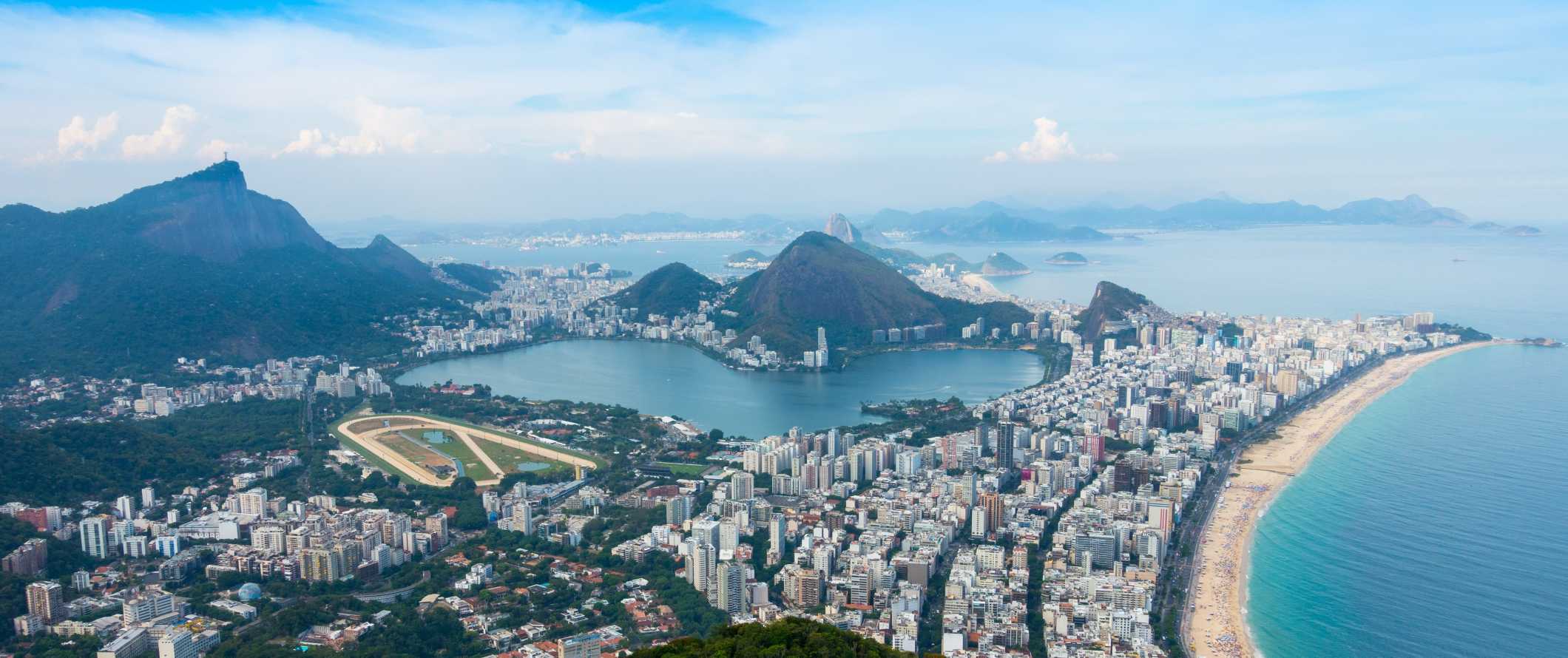
From the world-famous beaches of Copacabana and Ipanema to the magnificent summit of Corcovado, topped with the legendary Wonder of the World Christ the Redeemer, Rio combines big natural attractions with a sprawling metropolis. Home to over 12 million people, it should come as no surprise that it’s one of the most popular destinations in the world.
Founded by the Portuguese in the 16th century, Rio de Janeiro caters to every type of tourist and budget, popular with backpackers, Carnival revelers, and luxury vacationers alike. It’s an exciting city that has a lot to offer — so don’t rush your visit. There’s too much to see, especially when you factor in all those lazy days at the beach!
While petty theft and crime are a big concern here (you’ll want to avoid walking around alone at night), with a little vigilance you’ll be able to enjoy your time in this vibrant city without too much worry.
This travel guide to Rio de Janeiro can help you save money, stay safe, and ensure you have a wonderful visit.
Table of Contents
- Things to See and Do
- How to Stay Safe
- Where to Stay
- Typical Costs
- Suggested Budget
- Money-Saving Tips
- How to Get Around
- Best Places to Book Your Trip
- Related Blogs on Rio de Janeiro
Click Here for City Guides
Top 5 things to see and do in rio de janeiro.
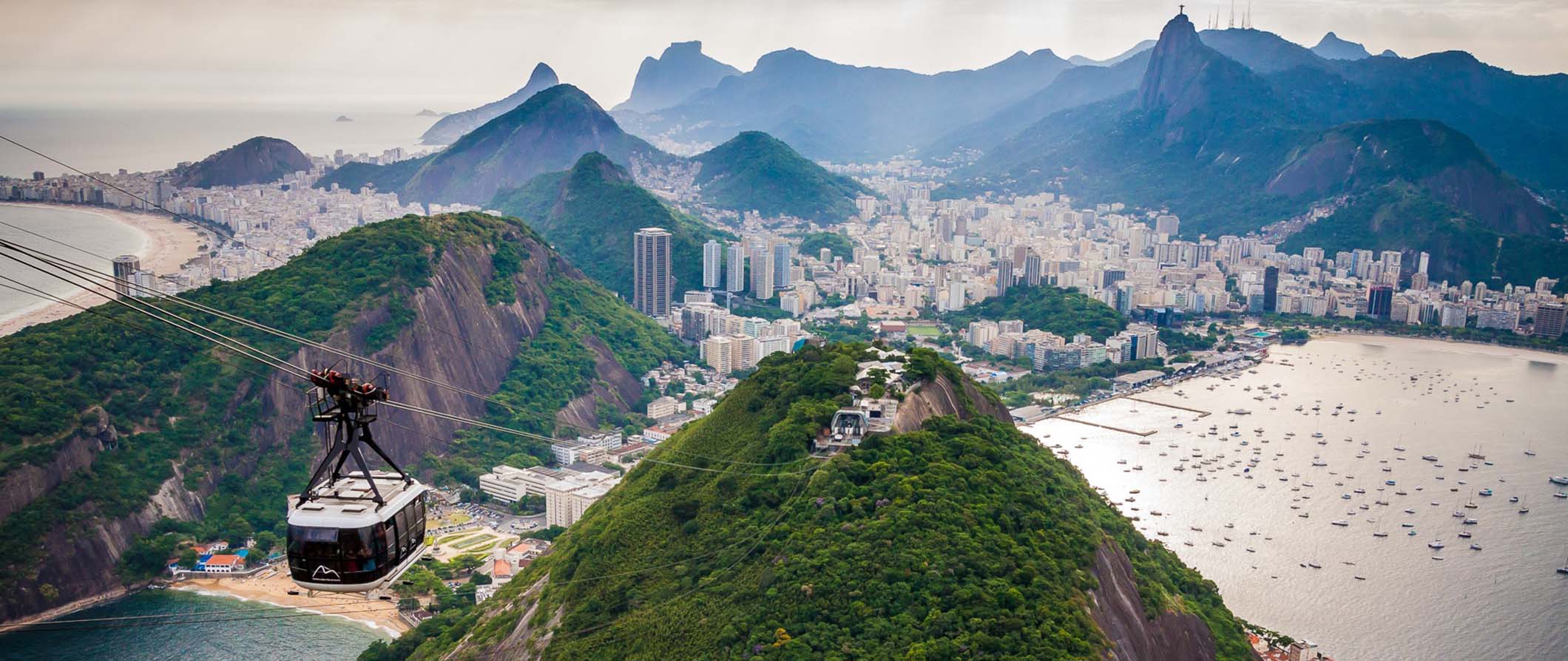
1. Celebrate Carnival
The Rio Carnival is one of the most famous festivals in the world, with people coming together from all corners of the globe to see the parade, listen to samba music, dance in the streets, and party for days. The city comes alive as thousands of people celebrate in bright, exotic regalia. You’ll want to reserve your Carnival tickets in advance as they sell out quickly!
2. Climb Sugarloaf Mountain
The famous Sugarloaf Mountain is one of the city’s most popular tourist destinations. Its name dates to the 16th century (the height of Brazil’s sugarcane trade), named for its resemblance to a conical block of sugar. The mountain is 396 meters (1,300 feet) tall, and at its peak, the entire city unfolds below you with spectacular views of Ipanema and Guanabara Bay, especially at sunset or sunrise. The cable car to get there costs 150 BRL ( reserve online in advance to skip the often super long lines).
3. See Christ the Redeemer
The 30-meter (100-foot) high statue of Christ the Redeemer sits atop the Corcovado Mountain and can be seen from any point in Rio. From its vantage point, you can take in the mountains, the bay, and the entire cityscape from the favelas to the skyscrapers. It’s an incredible Wonder of the World! You can get there a few different ways: via cog train (that goes through the rainforest), shared vans that leave from designated points around the city, or by hiking the (quite steep) trail to the top (though for safety reasons, it’s not recommended to do the trail alone). You can reserve advance tickets for the train and statue here (155 BRL).
4. Hit the beaches
Ipanema and Copacabana are the two largest beaches, and they’re always jam-packed with people. Ipanema has more upscale restaurants and nightlife, while Copacabana has more things to do (like fishing, surfing, and beachside markets selling handicrafts and swimwear). For quieter spots, check out Barra de Tijuca Beach, Prainha Beach, or Leme Beach (at the further end of Copacabana Beach).
5. Watch a fútbol game
Fútbol (soccer) is a religion here, and the chaos and excitement during a match are contagious! Maracanã in Rio de Janeiro is one of the largest stadiums in the world, and it seats 100,000 supporters. The best games are the local teams (Flamengo, Vasco, Botafogo, and Fluminese). Tickets can be as low as 20 BRL. If you’re not in town during a game or want to learn even more about the sport and stadium, you can take a stadium tour for 77 BRL.
Other Things to See and Do in Rio de Janeiro
1. visit the botanical gardens.
For a moment of calm, head to the city’s botanical gardens. Walk along the meandering paths and trails or take a free guided tour of the gardens. This place is home to over 8,000 plant species, designed in 1808 by order of the Prince Regent Dom João. Highlights include a lake filled with enormous Vitória Régia water lilies, an enclosed area with over 600 species of orchids, and a carnivorous greenhouse filled with Venus flytraps and pitcher plants. The gardens get super busy with families on the weekends, so come during the week. Admission is 67 BRL.
2. Wander the Rio de Janeiro Zoo
If your travels don’t include a trip to the Amazon, you can still experience Brazil’s indigenous animals at the Rio City Zoo. Over 1,300 animals from 350 species live here, including many rare and endangered native species such as harpy eagles, maned wolves, golden-headed lion tamarins, anteaters, and more. There’s also a particularly impressive reptile house and open aviary with macaws, toucans, and tropical birds flying freely around. Admission costs 47 BRL.
3. Learn the samba
You’ll hear samba music playing endlessly around Rio, especially during Carnival. Rio de Janeiro is one of the best places in Brazil to learn how to dance. Rio Samba Dancer is my favorite for its all-levels group classes, especially for the classes combined with social outings to samba clubs. Classes start from about 105 BRL.
4. Go to Paquetá Island
Paquetá Island in Guanabara Bay is a favorite with locals for escaping the hustle and bustle of the city center on weekends. The island is an hour-long ferry ride from Rio, and it’s made up of mainly beaches and quaint colonial towns. Transportation around the island is only by foot, bicycle, or horse-drawn carts. There’s not a lot to do here, but that’s kind of the point. The ferry costs 6.50 BRL one-way.
5. Ride the Santa Teresa tram
This tram has been running through the Santa Teresa neighborhood since 1877, making it the oldest electric railway in Latin America. It has always followed the same route from the city center, across the Lapa Arches, and passing by Ruinas Park overlooking Rio. The tram is open-sided, meaning you can lean out over the arches (a narrow former aqueduct) as you cross them – it’s a dizzying view! A return ticket on the 6-kilometer (3.7-mile) route is 20 BRL.
6. Visit the Selaron Stairway
Located in the Santa Teresa neighborhood, this stairway has hundreds of steps all painted with more than 2,000 pieces of colorful tiles, mosaics, and mirrors. Starting in the early 1990s, artist Jorge Selarón began gathering contributions from artists in 60 different countries. He also visited antique shops and trash heaps to find pieces to add over time, working on the staircase’s construction for over 20 years until his death in 2013. It’s one of the most photogenic and popular sights in the city (you’ve probably seen it on Instagram) so don’t miss it!
7. Explore the Arcos da Lapa district
For those of you who love the nightlife, this is an awesome district to head out to on a Friday night. Bars, clubs, and food stalls dominate the area, and street parties run from the famous arches up Avenida Mem de Sá. For live music, go to Circo Voador, an open-air concert venue primarily featuring Brazilian bands and artists. If you want to experience the club scene, check out the three-story Rio Scenarium. If you’re not into partying at all, admire the photogenic Arcos de Lapa (Lapa Arches). These arches date back to the mid-18th century and were once used as aqueducts.
8. Visit Sitio Roberto Burle Marx
This home and World Heritage Site belongs to one of Brazil’s most celebrated landscape designers, Roberto Burle Marx. Begun in 1949 and developed over the course of over 40 years, this 100-acre property features over 3,500 tropical and subtropical plant species. Inside the Burle Marx House Museum is a huge collection of his personal artwork as well as a 17th-century Benedictine chapel. Tours cost 10 BRL and are available by appointment only.
9. Visit the São Bento Monastery
Built between 1617-1641, this colonial Baroque church is located on Morro de São Bentois (St. Benedict Hill) in downtown Rio de Janeiro. Although the exterior is simple, the inside is covered in gold decoration, wood carvings from Frei Domingos da Conceição and Alexandre Machado, and paintings from José de Oliveira Rosa. The monastery is still in operation today, and if you attend Sunday mass, you’ll get to hear some traditional Gregorian chanting. Just be sure to dress respectfully as it is a place of worship.
10. Hike in Tijuca National Park
Tijuca National Park is the largest urban rainforest in the world, stretching across 8,300 acres. Over 350 different species of mammals, birds, and reptiles make their home here, including howler monkeys, which only came back to the park recently after a 100-year hiatus. The Corcovado (Christo) hike through Parque Lage and to the top of Corcovado is a steep climb, but it’s shaded and only takes about three hours. Another scenic hike is to Tijuca Peak, starting in Rio’s North Zone and past waterfalls and dense rainforest. You’ll get views over Niteroi and Guanabara Bay, and it only takes about two hours to complete. Entrance to the park is free. This is a place where it’s really worth it to go with a tour though. You’ll not only have a more in-depth experience, learning history of the rainforest as well as how to recognize native flora and fauna, but get round-trip transportation to/from your accommodation as well. There are tons of tours available, from the popular jeep tours to full-day adventure hikes that go to lesser visited sections of the rainforest.
11. Go to the Ilha Fiscal
A little outside Rio’s city center is Ilha Fiscal, a Neo-Gothic castle on a secluded island in Guanabara Bay. It used to be a location for the Brazilian Custom Service but is now a work of architectural art, with mosaic floors, stained glass, and a traditional Ceremonial Room used by the Navy. You can only access the island by schooner and bus from the Naval Museum. Admission to the Naval Museum is free, while a return ticket to Ilha Fiscal is 42 BRL.
12. Visit the Museum of Tomorrow
The Museum of Tomorrow (Museu do Amanhã) is a science museum that focuses on ecology, sustainability, and the future of our planet. Ultra-sleek and modern, the Museum of Tomorrow has high-tech visuals and simulators that let you consider the world’s past, present, and future. Although it might sound depressing, it’s incredibly well-curated, and the whole experience is captivating. Admission is 30 BRL.
13.Take a walking tour
Walking tours are my favorite way to get my bearings in a new place. Free Walker Tours and Rio by Foot both offer free walking tours through a variety of different Rio neighborhoods, as well as paid tours such as food tours, pub crawls, and rainforest tours. If you’re taking a free tour, just be sure to tip your guide at the end!
14. Explore Rio by Bike
Because of Rio’s geography, stretching along the coast between the ocean and the mountainous rainforest, the city can take some time to get around. You can cover a lot of ground by biking along the beach and through different neighborhoods on the many kilometers of dedicated bike lanes in the city. You can either explore on your own or with a local guide on a tour with Rio by Bike .
For more information on specific cities in Brazil, check out these guides:
- Fernando de Noronha Travel Guide
- Florianopolis Travel Guide
- Sao Paulo Travel Guide
How to Stay Safe in Rio de Janeiro
Rio de Janeiro has a lot of crime and is not the safest city in the world. Violent attacks can occur, however, your biggest concern here is petty crime — especially after nightfall around popular tourist destinations.
Don’t walk alone at night. Instead, take taxis. Have your accommodation call one for you so you can be sure you get a reputable driver.
When withdrawing money, make sure you go inside a bank so that you can put your cash away without the risk of getting robbed.
Don’t flash your valuables and always make sure your possessions are secure and out of reach (especially your phone and wallet).
Never accept drinks from strangers and don’t leave anything unattended at the beach.
Unless you’re on a guided tour, avoid the favelas. The favelas are where the highest rate of crime occurs in the city, and you shouldn’t be exploring there on your own.
Carjacking and break-ins are common so avoid renting a car here.
Solo female travelers will want to exercise caution here. Travel with groups where you can and avoid getting too far off the beaten path if you’re alone.
If you’re worried about getting scammed, you can read about common travel scams to avoid right here.
If you experience an emergency, dial 190 for assistance.
Always trust your gut instinct. Avoid isolated areas at night and be aware of your surroundings at all times. Make copies of your personal documents, including your passport and ID. Forward your itinerary along to loved ones so they’ll know where you are.
The most important piece of advice I can offer is to purchase good travel insurance. Travel insurance will protect you against illness, injury, theft, and cancellations. It’s comprehensive protection in case anything goes wrong. I never go on a trip without it as I’ve had to use it many times in the past.
Where to Stay in Rio de Janeiro
Rio de Janeiro is a sprawling city. When you’re researching your hostel, make sure you find a neighborhood that fits your needs, whether you want to stay in the city center or somewhere near the beach. Otherwise, you’ll be spending a lot of money on taxis and sitting in the city’s terrible traffic. Here are my suggested places to stay:
- Selina Lapa Rio de Janeiro
- Mango Tree Hostel Ipanema
- CabanaCopa Hostel
For more suggestions, check out this post on the best hostels in Rio .
Rio de Janeiro Travel Costs
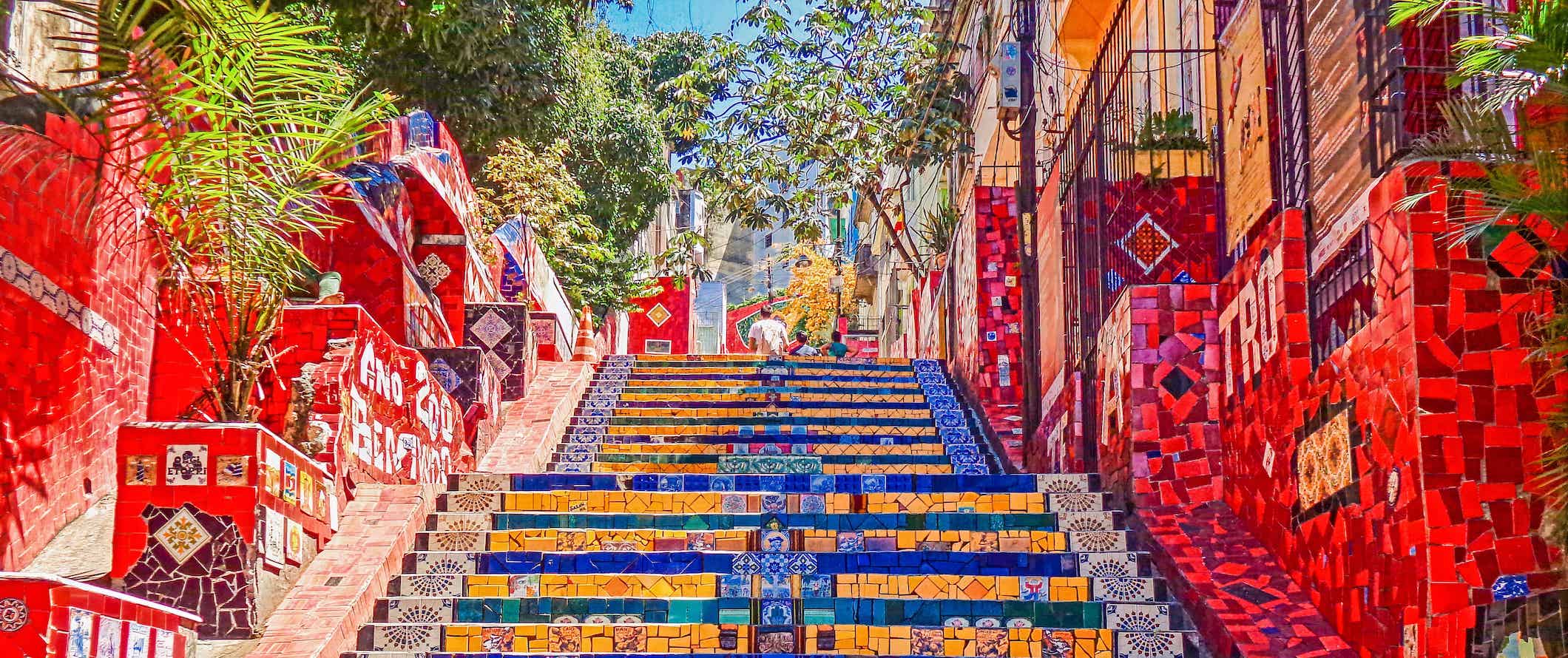
Accommodation
- Hostel dorms – 65-110 BRL per night (double or triple during Carnival)
- Hostel private rooms – 225-300 BRL per night
- Budget hotels – 150-300 BRL per night
- Airbnb private rooms – 100-125 BRL per night
- Airbnb apartments – 275-350 BRL per night
- Street food – 8-20 BRL each
- Buffets – 70-90 BRL per kilo
- Sit-down restaurants – 20-80 BRL
- Casual take-out places – 35 BRL
- Fast food (think McDonald’s) – 35 BRL
- Beer – 7-10 BRL
- Cocktails – 20-40 BRL
- Cappuccino/latte- 8-12 BRL
- Groceries for a week – 100-145 BRL
Rio de Janeiro Suggested Budgets
Backpacker – 215 brl per day.
If you are backpacking Rio de Janeiro, this budget covers staying in a hostel dorm, eating street food, cooking most of your meals, limiting your drinking, using public transportation to get around, and doing mostly free activities like enjoying the beach.
Midrange – 470 BRL Per Day
On a mid-range budget, you can stay in a private hostel or Airbnb room, eat out for all your meals at cheap local restaurants, take the occasional taxi to get around, enjoy a few drinks, and do more paid activities like visiting the zoo and attending a soccer game.
Upscale – 825 BRL Per Day
On a “luxury” budget, you can stay in a hotel, eat out for all your meals, enjoy more drinks, take taxis everywhere, and enjoy all the tours and activities you want. This is just the ground floor for luxury though. The sky is the limit!
Rio de Janeiro Travel Guide: Money-Saving Tips
Rio has lots of free activities and attractions to enjoy, like beaches and hiking trails. While food and accommodation aren’t cheap, there are ways to keep your costs down. Here are some ways to save money in Rio de Janeiro:
Pack a water bottle – The tap water here isn’t safe to drink so bring a water bottle with a filter to save money and reduce your single-use plastic usage. My preferred bottle is LifeStraw as it has a built-in filter to ensure your water is always clean and safe.
Eat por kilo – As with elsewhere in Brazil, restaurants that have you pay by the kilo for your food is a good deal. Look out for these cheap options.
Visit the market – If you’re staying at a hostel with kitchen facilities, it’s a good idea to stock up on food at the market and eat like the locals.
Snack on street food – There’s a thriving street food culture in Brazil, meaning lots of cheap and delicious food to fill up on.
Stay with a local – Couchsurfing connects you with locals who can give you a free place to stay and share their insider tips and advice. It’s the best way to meet locals and save money.
Go to free museum days – Almost all the museums in Rio have a free day to visit each week. Check their website for details!
Take a free walking tour – There are many excellent free walking tours in Rio, including Free Walker Tours and Rio By Foot. They’re the best way to see the main sights on a budget. Just be sure to tip your guide at the end!
Avoid Carnival time – As exciting as Carnival is, visiting Rio any other time of the year is just as magical and saves you lots of money.
How to Get Around in Rio de Janeiro

Public Transportation – Rio’s BRT (Bus Rapid Transit) has quick and reliable routes in Copacabana, Barra, Ipanema, and Leblon. Fares cost from 3.80 BRL per trip. You’ll have to flag down a bus by waving at the driver. Otherwise, the Metrô Na Superfície shuttle passengers between metro stations, but they’re often very crowded. The bus is also not always the safest method of travel, so exercise caution here, and don’t use them at night.
Rio de Janeiro has three very efficient subway lines. Line 1 runs between Ipanema to the North Zone, while Line 2 runs between Botafogo and Pavuna (with Maracanã football stadium on the way). Line 3 runs between Ipanema and the Barra de Tijuca. You can get a prepaid card (called RioCard+Mais) at any kiosk for 4 BRL. A single metro ride costs 5 BRL.
For solo female travelers, note that there are women-only metro cars (marked in pink) during peak rush hours (6am-9am, 5-8pm, on weekdays).
The only remaining tram line in Rio is the famous Santa Teresa line, which runs from the tram station in Centro and travels across the Lapa Arches, Ruinas Park, and then turns around at Largo do Guimarães. A return ticket is 20 BRL.
Bicycle – Rio has tons of bike paths along its main beach areas. Unfortunately, only Brazilian citizens and residents with a CPF number can use the bike sharing system, though you can also rent bikes from a local shop for about 150 BRL per day to navigate the paths between Copacabana and Ipanema.
Ferry – You can take a ferry to visit several of Rio’s highlights, like Ilha Fiscal, Ilha de Paquetá, and Niterói. Ticket prices are generally 12-15 BRL round-trip.
Taxis – Taxis start at 6 BRL and cost an additional 2.65 BRL per kilometer. This rate increases to 3 BRL per kilometer at night and on Sundays. A ride around town generally costs 10-50 BRL. Use the 99 app (formerly 99Taxis) to get a safe, metered taxi.
Ridesharing – Uber is available in Rio de Janeiro and usually costs around the same a taxi.
Car rental – Renting a car generally costs 80-120 BRL per day, though I don’t recommend renting a car here. It’s unnecessary, the traffic is terrible, drivers are aggressive, and parking is expensive. Break-ins and carjackings are common.
When to Go to Rio de Janeiro
December to March is when Rio is at its warmest and sunniest. There isn’t much rain during these months, and temperatures tend to be around 32°C (90°F) and higher each day.
Autumn (April-May) and spring (October-November) offer slightly cooler temperatures, usually in the mid-20s°C (low 80s°F). Although Rio is busy year-round, you’ll avoid a lot of peak tourism madness by visiting during these months.
During February’s Carnival, prices skyrocket, and accommodation sells out very quickly. You should consider booking your travel at least six months (and up to a year) before Carnival time to snag the best deals and places to stay.
Rio de Janeiro Travel Guide: The Best Booking Resources
These are my favorite companies to use when I travel. They consistently have the best deals, offer world-class customer service and great value, and overall, are better than their competitors. They are the companies I use the most and are always the starting point in my search for travel deals.
- Skyscanner – Skyscanner is my favorite flight search engine. They search small websites and budget airlines that larger search sites tend to miss. They are hands down the number one place to start.
- Hostelworld – This is the best hostel accommodation site out there with the largest inventory, best search interface, and widest availability.
- Booking.com – The best all around booking site that constantly provides the cheapest and lowest rates. They have the widest selection of budget accommodation. In all my tests, they’ve always had the cheapest rates out of all the booking websites.
- Get Your Guide – Get Your Guide is a huge online marketplace for tours and excursions. They have tons of tour options available in cities all around the world, including everything from cooking classes, walking tours, street art lessons, and more!
- SafetyWing – Safety Wing offers convenient and affordable plans tailored to digital nomads and long-term travelers. They have cheap monthly plans, great customer service, and an easy-to-use claims process that makes it perfect for those on the road.
- LifeStraw – My go-to company for reusable water bottles with built-in filters so you can ensure your drinking water is always clean and safe.
- Unbound Merino – They make lightweight, durable, easy-to-clean travel clothing.
- Top Travel Credit Cards – Points are the best way to cut down travel expenses. Here’s my favorite point earning credit cards so you can get free travel!
Rio de Janeiro Travel Guide: Related Articles
Want more tips for your trip? Check out all the articles I’ve written on Rio de Janeiro travel and continue planning your trip:

Is Brazil Safe to Visit?

Brazil Travel Guide
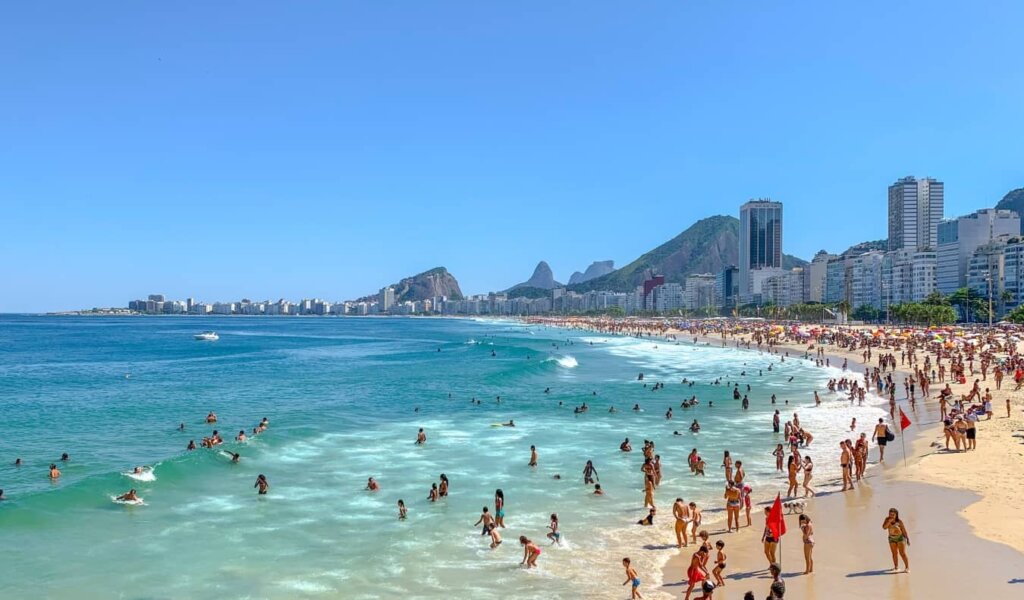
The 6 Best Hostels in Rio de Janeiro
Get your free travel starter kit.
Enter your email and get planning cheatsheets including a step by step checklist, packing list, tips cheat sheet, and more so you can plan like a pro!

- Where To Stay
- Transportation
- Booking Resources
- Related Blogs
Guide Francophone Rio de Janeiro

Guide parlant français pour visiter Rio de Janeiro
Guide francophone à Rio de Janeiro depuis 2004! Bonjour, je m’appelle Madson, je suis brésilien et guide touristique! • J’ai déjà guidé des milliers de touristes qui parlent français : des suisses, des français, des belges, des canadiens, des luxembourgeois… • Demandez-moi un devis et venez découvrir Rio de Janeiro dans les mains du guide francophone le plus experimenté au Brésil (plus de 8.000 personnes guidées en individuel!).
Voici quelques sites que je peux vous faire découvrir dans Rio, la ville merveilleuse:

Quelques avis

“Organisé, sérieux, sympathique, adaptable, parfaitement francophone, connaissant Rio comme sa poche. Madson nous a fait découvrir Rio touriste, Rio local comme on le souhaitait. Merveilleux cadeau de Noël pour ma fille. Visite guidée à faire sans hésiter”.

“Un grand merci à Madson qui a réussi à nous faire découvrir sa ville et surtout à nous la faire aimer en trois jours et malgré une météo capricieuse. Sa gentillesse, son humour et sa connaissance parfaite de Rio nous ont permis de garder un souvenir inoubliable du Brésil et de la “Cidade Maravilhosa”. Il nous a conduit en toute sécurité dans tous les lieux incontournables en nous faisant des commentaires avisés sur chacun. Il nous a conseillé sur les restaurants typiques et leurs spécialités brésiliennes. Grâce à Madson, nous avons passé un excellent séjour et nous le recommandons chaudement à nos compatriotes français car il parle de surcroit un excellent français et fait gagner un temps précieux à ceux dont les jours de vacances sont comptés.”

“ Nous sommes enchantés de notre visite de Rio avec Madson qui est un guide super! Le tour que nous avons fait nous a donné un très bel aperçu d’une partie de la ville. Madson explique très bien, et nous serions passés à côté de beaucoup de choses sans lui, tout cela en 5h mais en prenant le temps. Merci encore! “

“Nous avons visité, mon épouse, notre fille adulte et moi, Rio en compagnie de Madson. Deux matinées magnifiques! Madson a su aller au devant de nos envies, nous faire rire, nous emmener dans des endroits auxquels nous n’aurions jamais pensé tout en gardant ceux traditionnels. De plus, en as du volant, il nous a conduit en toute sécurité tout en ne perdant pas de temps dans le traffic très intense de Rio. Sa connaissance historique, culturelle et géographique et sa gentillesse sont à relever. Nous n’oublierons pas cette expérience extraordinaire que nous ne pouvons que conseiller.”
Demandez un devis

• Merci de remplir le formulaire pour recevoir un devis. • Ça prends quelques secondes et je réponds incroyablement vite!
Oui, l'adresse email tapée est correcte.

Combien ça coute vous prendre comme guide à Rio de Janeiro?
Mon tarif depends de plusiers variables. Merci de m’envoyer un message pour recevoir un devis personalisé.
Combien de temps dure votre visite guidée?
Je propose des demi-journées ou des journées entières.
Vous ne faitez que des visites privées?
Combien de jours il faut pour bien découvrir rio de janeiro avec un guide privé.
Avec moi, il faut compter 3 journées entières. Mais on voit pas mal déjà avec 3 demi-journées de visite .
Ça vaut la peine de prendre un guide touristique à Rio de Janeiro?
Ça vaut la peine de prendre un guide touristique si vous voulez:
1) Gagner du temps 2) Apprendre sur la vie local 3) Découvrir Rio de Janeiro dans les mains d’un expert 4) Visiter les incontounables mais aussi les sites non touristiques 5) Ne pas avoir de soucis pendant la visite des sites célèbres
Parlez-vous bien le français?
Oui, je comprends tout ce qu’on dit, et on comprends tout ce que je dit. Ma diction et pronunciation sont claires. Je suis brésilien mais je parle le français depuis 1998, et j’ai même le DALF (Diplôme Approfondi de Langue Française ). Bref, je suis un vrai brésilien de Rio de Janeiro, mais qui a vecú aussi en France, et pourtant, je parle le français couramment .
Vous êtes guide touristique depuis quand?
Je suis guide indépendant depuis 2004. Donc, j’ai déjà 19 ans d’experience!
Combien des guides francophones il y-a t’il à Rio de Janeiro?
Des guides francophones (qui parlent bien), experimentés, brésiliens et sympas? Il n’y a pas beaucoup.
Quelles sont les avantages de prendre un guide pour visiter Rio de Janeiro?
Voici quelques avantages de découvrir Rio de Janeiro accompagné d’un guide parlant français , réputé, et qui connaît comme sa poche Rio de Janeiro, la destination número 1 au Brésil.
- Économisez de l’argent et du temps à Rio de Janeiro avec un guide touristique francophone qui a une voiture
Rio est une grande ville, mais dans les mains d’un guide francophone avec voiture privée vous pouvez voir et visiter beaucoup plus en moins de temps. Comme ça vous restez moins de jours à Rio de Janeiro, ou restez le temps que vous pouvez et utilisez le reste du séjour pour profiter tranquillement des vacances à Rio de Janeiro (plages, restos, piscine de l’hôtel, cafés, etc.).
- Évitez les queues sur les célèbres sites touristiques de Rio de Janeiro avec un guide local francophone
Rio de Janeiro devient de plus en plus à la mode comme destination touristique , et par conséquent, les sites touristiques et monuments à visiter ont de plus en plus des touristes . La tendance est qui cela augmente et qui devienne de plus en plus difficile visiter Rio de Janeiro sans un guide touristique indépendant , spécialement en haute saison, jours fériés brésiliens, etc.
Un guide touristique professionnel indépendant peut vous faire éviter les longues queues d’attente. Ou vous croyez qui vous êtes le seul à vouloir visiter le Christ Rédempteur et le Pain de Sucre ? Votre guide touristique peut organiser l ’ itinéraire et les visites pour éviter les queues et la foule. Voici pourquoi le mot ‘ visites organisées ’: c’est pour éviter les ennuis, le stress, la désorganisation, les mauvaises surprises pendant les vacances.
Pour passer de bons moments lors de votre découverte de Rio il est fort conseillé de réserver votre visite guidée avec un guide expérimenté et réputé, avec plusieurs années d’expérience.
- Visitez Rio de Janeiro en toute sécurité
Rio de Janeiro a plus de 6 millions d’habitants. C’est la 2ème plus grande ville au Brésil. Il faut prendre de précautions. Un guide privé local francophone peut être votre ange-guardien pendant les visites, mais aussi peut vous donner des conseils et recommandations pour votre sécurité pour le reste de votre séjour dans cette ville magnifique.
Vous voyagez en famille avec des enfants? en couple? une femme seule? un homme en voyage d’affaires? N’importe le cas. N’hésitez pas à réserver votre visite guidée en français à Rio de Janeiro. Après tout, votre sécurité n’a pas de prix, n’est pas? Les guides de voyage ne suffisent pas, il faut un guide en personne, un guide touristique local francophone pour visiter Rio de Janeiro en minimisant les dangers et en évitant des problèmes.
- Visiter Rio de Janeiro en tout confort, en voiture monospace climatisée
Visiter Rio de Janeiro dans les mains d’un chauffeur-guide privé francophone qui a sa propre voiture climatisée est essentiel, spécialement pendant l’été car il fait souvent très chaud (fin décembre, janvier, février, mars), l’automne (avril, mai, juin), le printemps (fin septembre, octobre, novembre) et certains jours de l’hiver (juillet, août).
Il fait parfois trop chaud et trop humide. Donc, se déplacer à Rio de Janeiro dans une voiture spacieuse et climatisée, d’une visite guidée à l’autre, est important pour ne pas être complètement épuisé à la fin de la journée du circuit touristique , même si vous aimez ou cherchez la chaleur. Bref, laissez tomber le métro plein comme un oeuf, les taxis petits, les bus chauds. aitez le tour de Rio de Janeiro en confort et en français ; vous êtes en vacances!
- Visite de Rio de Janeiro sur mesure, à la carte, et en français
Votre visite privée de Rio de Janeiro avec Madson, votre guide privé parfaitement francophone , est faite sur mesure. C’est-à-dire, vous allez visiter ce que vraiment vous intéresse, les meilleures visites (pour vous). En effet, c’est vous que choisissez à la carte les sites à voir, les lieux à visiter , les choses à faire à Rio de Janeiro .
Bref, visiter Rio de Janeiro avec un guide privé francophone est essentiel n’importe combien de jours vous y séjournez.
Visite guidée Rio de Janeiro en français? Contactez-moi
Préférentiellement: Remplisez le formulaire sur cet page Email: [email protected] Téléphone portable: +55 21 9 9395-3537 (WhatsApp) Site: https://www.guidefrancophoneriodejaneiro.com Rio de Janeiro – RJ – Brésil

A Girl's Guide to Rio de Janeiro
Immerse yourself in the pulsating rhythm of Rio de Janeiro with our comprehensive travel guide. Embark on a captivating journey through this vibrant city where the spirit of Brazil comes alive in every corner.
Discover the iconic landmarks that define Rio's skyline and dive into the heart of Brazilian culture as you wander through colorful neighborhoods adorned with mesmerizing street art, or lose yourself in the hypnotic beats of samba echoing through the streets.
Indulge your senses in Rio's culinary delights with our handpicked selection of restaurants offering mouthwatering Brazilian cuisine and international flavors. Unwind in style at exclusive beach clubs dotting the pristine coastline, where sun-kissed sands meet crystal-clear waters.
As night falls, immerse yourself in Rio's legendary nightlife scene, where pulsating music and vibrant energy fill the air. Whether you seek the thrill of a bustling nightclub or the laid-back charm of a beachfront bar, our guide will lead you to the hottest spots in town.
From exhilarating outdoor adventures to hidden gems waiting to be discovered, our Rio de Janeiro travel guide is your passport to an unforgettable experience in this mesmerizing city. So pack your bags and let the adventure begin!
Our Travel Guide Includes:
Hightlights
Restaurants
Beach Clubs
Places to Visit
Download your free travel guide!
Rio de Janeiro

- 1 Districts
- 2.1 History
- 2.2 Climate
- 2.3 Visitor information
- 3.1.1 Public transport from the airports of Rio
- 3.1.2 Taxis
- 3.1.3 Money
- 3.1.4 Destinations
- 3.2 By train
- 3.4 By boat
- 4.1 By boat
- 4.2 By light rails/tram
- 4.3 By cable car
- 4.5 By Bus Rapid Transit (BRT)
- 4.6 By subway
- 4.7 By SuperVia suburban trains
- 4.8 By taxi
- 4.9 By e-hailing
- 4.10 By car
- 4.11 By bicycle
- 5.1 Beaches
- 5.3 Buildings
- 5.4 Museums
- 6.1 Carnaval
- 6.3 New Year's Eve celebrations
- 6.4 Gay Travel
- 6.5 Hang gliding and paragliding
- 6.6 Hiking and Trekking
- 6.7 Panoramic flights
- 6.8 Favela (Shantytown) tours
- 6.9 Out of town trips
- 10.3 Samba clubs
- 10.4 Clubbing
- 12 Stay healthy
- 13 Stay safe
- 14.1 Consulates General
- 15.1 Grande Rio
- 15.2 On the southeastern coast of Rio State
- 15.3 In the northwest
- 15.4 In the north
- 15.5 In the west
<a href=\"https://tools.wmflabs.org/wikivoyage/w/poi2gpx.php?print=gpx&lang=en&name=Rio_de_Janeiro\" title=\"Download GPX file for this article\" data-parsoid=\"{}\"><img alt=\"Download GPX file for this article\" resource=\"./File:GPX_Document_rev3-20x20.png\" src=\"//upload.wikimedia.org/wikipedia/commons/f/f7/GPX_Document_rev3-20x20.png\" decoding=\"async\" data-file-width=\"20\" data-file-height=\"20\" data-file-type=\"bitmap\" height=\"20\" width=\"20\" class=\"mw-file-element\" data-parsoid='{\"a\":{\"resource\":\"./File:GPX_Document_rev3-20x20.png\",\"height\":\"20\",\"width\":\"20\"},\"sa\":{\"resource\":\"File:GPX Document rev3-20x20.png\"}}'/></a></span>"}'/>
Rio de Janeiro is the second largest city in Brazil , on the South Atlantic coast. Rio is famous for its breathtaking landscape, its laid-back beach culture and its annual carnival. The "Carioca Landscapes between the Mountain and the Sea" has been inscribed on the UNESCO World Heritage list .
The harbour of Rio de Janeiro is comprised of a unique entry from the ocean that makes it appear as the mouth of a river. Additionally, the harbor is surrounded by spectacular geographic features including Sugarloaf mountain at 395 meters (1,296 feet), Corcovado Peak at 704 meters (2,310 feet), and the hills of Tijuca at 1,021 meters (3,350 feet). These features work together to collectively make the harbor one of the Seven Natural Wonders of the World .
Rio de Janeiro hosted many of the 2014 FIFA World Cup games, including the final. It also hosted the 2016 Summer Olympics and Paralympics, becoming the first South American city to host the Summer Olympics.

It is a common mistake to think of Rio as Brazil 's capital, a distinction it lost on April 21, 1960 when Brasilia became the capital. Beaches such as Copacabana and Ipanema , the Christ The Redeemer ( Cristo Redentor ) statue, the stadium of Maracanã and Sugarloaf Mountain ( Pão de Açúcar ) are all well-known sights of what the inhabitants call the "marvelous city" ( cidade maravilhosa ), and are also among the first images to pop up in travelers´ minds, along with the Carnaval celebration.
The South Zone holds most of Rio's landmarks and world-famous beaches, in an area of only 43.87 square kilometres (16.94 sq mi) . Many of them are within walking distance of each other (for instance, the Sugarloaf lies about 8 km (5.0 mi) from Copacabana beach). Most hotels and hostels are located in this part of the city, which is compressed between the Tijuca Range ( Maciço da Tijuca ) and the sea. There are important places in other regions as well, such as Maracanã stadium in the North Zone and the many fascinating buildings in the centre.
Sadly, most people also know Rio for its violence and crime, especially related to drugs. And social problems, as slums or favelas , areas of poor-quality housing and living; these slums are usually located on the city's many mountain slopes, juxtaposed with middle-class neighbourhoods.

Rio was founded in 1565 by the Portuguese as a fortification against French privateers who trafficked wood and goods from Brazil. Piracy played a major role in the city's history, and there are still colonial fortresses to be visited (check below). The Portuguese fought the French for nearly 10 years, both sides having rival native tribes as allies. For the next two centuries it was an unimportant outpost of the Portuguese Empire, until gold, diamonds, and ore were found in Minas Gerais in 1720. Then, as the nearest port, Rio became the port for these minerals and replaced Salvador as the main city in the colony in 1763. When Napoleon invaded Portugal, the Royal Family moved to Brazil and made Rio capital of the Kingdom (so it was the only city outside Europe to be capital of a European country). When Brazil became independent in 1822, it adopted Monarchy as its form of government (with Emperors Pedro I and Pedro II). Many historians and Brazilians from other places say cariocas are nostalgic of the Royal and Imperial times, which is reflected in many place names and shop names. In 2009, the city won their bid to host the games of the XXXI Olympics in the summer of 2016. This was the fifth bid by the city, whose 1936, 1940, 2004, and 2012 bids lost.
The climate of the city of Rio de Janeiro is tropical with a hot, humid and sometimes rainy summer and a mild and dry winter. In December and January, the heat and humidity are usually constant, reaching up to 45°C (113°F), However, it rains less in Rio de Janeiro than in other cities in the Southeast (for example, São Paulo) and the rains are usually sudden and rapid, giving a welcoming relief from the sizzling afternoon temperatures. During winter in the southern hemisphere, temperatures in Rio are usually milder. In these months rainfall decreases, and average temperatures are typically 19°C (66°F) to maximums of 25°C (77°F).
Visitor information
- Riotur website
Rio is one of the country's major transportation hubs, second only to São Paulo.
Metropolitan area airport code for the two airports of the city is unsurprisingly RIO IATA .
If the flight connections to Rio don't suit you, you can check flights to the airports of São Paulo , Belo Horizonte , Campinas or Vitoria . From there you can take an intercity bus to Rio.
Public transport from the airports of Rio
From Galeão (GIG) two bus lines operated by Real [ dead link ] depart from right outside the arrival section. Buses are air-conditioned and comfy, with ample luggage space. They run roughly every 30 minutes from 5:30AM to 10PM.
- Bus line 2018 Aeroporto Internacional do RJ/Alvorada (Via Orla da Zona Sul) runs between both airports, the main bus terminal and further along the beachfront of Botafogo , Copacabana , Ipanema and Leblon , and has its terminus at the Alvorada terminal near Barra Shopping in Barra da Tijuca . The full run takes at least 60 minutes, often double that. Tickets are R$16 (Dec 2016).
- Bus line 2918 Aeroporto Internacional do RJ/Alvorada (Via Linha Amarela) runs to the Alvorada bus terminal, via Jacarapaguá (the best spot for taxis) from Galeão airport along the Linha Amarela in as little as 35 minutes, traffic allowing.
For a slightly cheaper option, go ahead as follows. From the airport , take BRT (Bus Rapid Transport System) (R$3.60, RioCard (R$3) needed, but can be used on Metro as well) to Vicente de Carvalho and transfer to the metro. The BRT does not go into the center, but north around Rio towards Alvorada Bus Terminal and Terminal Jardim Oceãnico. From Alvorada they connect to other BRT to Santa Cruz and Campo Grande west. The BRT also connects to the commuter rail system in Madureira. If you head to the airport , you need to take BRT bus #30 semi direto to Galeão , from Vicente de Carvalho . The bus goes every 30 min or so, from the middle doors of the 100 m long bus stop. Allow 1.5 hr for the trip between center and airport, especially if you do it the first time. Connect to Vicente de Carvalho using metro line 2 (R$4.30). Between metro and BRT at Vicente de Carvalho , walk the white footpath. At the airport, you get off at Terminal 2, when all people get off.
There are two types of taxis . As you leave Customs you will see booths of different companies offering their services. These are considerably more expensive than the standard yellow taxis that are to be found outside the terminal building but the quality of the cars is generally better and the price is pre-set and final and you pay at the booth before going to the car with no need to pay (or tip) the driver. These taxis can often charge double the price of those ordinary taxis from the rank around 100 metres from the arrivals exit. It is possible to reserve airport transfers. Standard yellow taxis are cheaper but usually run on meters meaning that, due to high traffic, you may end up paying more than originally expected. Also, although very rare nowadays, you will need to keep the eye on the road (maybe following your route on Google Maps or similar) to ensure that the driver does not make a (long) diversion running up a high fare at the end. Many will also want payment in cash rather than card.
Money change facilities are limited and high commissions are charged. Slightly better rates can be obtained, illegally, at the taxi booths but they may want you to use their cabs before changing money for you. In any event, don't change more than you have to as much better rates are available downtown. However, if you have a VISA or Mastercard Debit Card, you may use the Airport's ATMs (Banco 24 Horas) which will allow you to withdraw cash for a fee. IN this case, do not accept the suggest exchange rate but ask for it to be debited in Reals in your account since your bank will almost certainly havea better rate to offer.
Destinations
From Europe, LATAM Airlines offers direct flights from Paris (daily), London and Frankfurt (both three times a week). Air France flies twice a day from Paris, British Airways three times a week from London, TAP twice a day from Lisbon and on Fridays and Sundays to Porto , Lufthansa four days a week from Frankfurt, KLM four days a week from Amsterdam and Iberia daily from Madrid . From Africa, Taag connects Rio to Luanda four times a week, and from Asia, Emirates has a daily non-stop flight to Dubai , where is possible to continue to many Asian destinations (also, from Rio this flight continues to Buenos Aires ).
From North America, there are non-stop flights to Rio de Janeiro from Charlotte , New York City and Miami with either American Airlines or LATAM Airlines, Washington, D.C. and Houston with United Airlines, Dallas with American Airlines, and Atlanta with Delta Air Lines. Travellers from elsewhere in the region have to make a stop in the aforementioned U.S. cities or in São Paulo to get to Rio.
Gol, LATAM , Emirates, Aerolíneas Argentinas and other carriers connect Rio de Janeiro to Argentina ( Buenos Aires and Cordoba ), Venezuela ( Caracas ), Paraguay ( Asuncion ), Uruguay ( Montevideo ) and Chile ( Santiago ). Avianca and Copa Airlines connect Rio with Bogotá , Lima and Panama City , respectively, offering onward connections to Central America or other South American cities. LATAM and Aerolineas Argentinas offer connections from their respective hubs to Australia and New Zealand .

- -22.9021 -43.556 5 Rodoviário de Campo Grande Bus station ( Terminal Rodoviário de Campo Grande ), Rua Aurélio de Figueiredo, Campo Grande, Zone Norte ( BRT TransOeste terminated here. ). Buses to/from Duque de Caxias, Nova Iguaçu, Itaguaí, Mangaratiba, Niterói and São Gonçalo cities.
Several companies offer bus passes from Rio to the rest of the country. The Green Toad Bus also offer bus tickets online for buses from Rio de Janeiro to Ilha Grande , Paraty , São Paulo , Florianopolis , Campo Grande , Foz do Iguacu and some other destinations in Brazil. They have bus passes to take you to other countries as well.

Ferries ( barcas ) connect neighbouring Niterói to Rio de Janeiro and arrive at Praça XV (see down), in the city centre.
Rio is connected by many roads to neighboring cities and states, but access can be confusing as there are insufficient traffic signs or indications of how to get downtown.
The main interstate highways passing through Rio are:
- BR-116 , which connects the city to the southern region of Brazil. Also known as Rodovia Presidente Dutra
- BR-101 , which leads to the north, northwest plus Costa Verde (Green Coast - Paraty, Mangaratiba, Angra dos Reis) and São Paulo Coast (Ubatuba, Caraguatatuba, Bertioga, Santos) and beyond towards the South of Brazil , and
- BR-040 , which will take you in the central and western areas.
Rio de Janeiro possesses an extensive and complex, highly multi-modal public transportation system, adapted to the city's unique topography - large areas covered by mountains surrounded by pockets of densely populated flat lands. Among the public transportation modes, there is subway, heavy rail, light rail, bus rapid transit, local buses, microbuses, cable cars and ferry boats.
The city uses a prepaid transport SmartCard, the RioCard Bilhete Único Carioca , which costs R$3.00 (refundable) and gives access to nearly all available public transportation (mostly excluding tourist rides), also offering discounts if the user takes more than one transportation within a 2-hr time period and stays within the Rio de Janeiro municipality. Cards can be returned with getting the money on it back. This can be a good way to get cash off credit cards that have a minimum cash withdrawal of like €50, but in case you only need another R$40 before leaving the country.
Unfortunately, the RioCard cannot be returned at the airport.
It is very convenient to get a Bilhete Único if you plan to use public transport on a regular basis during your stay in Rio, as it saves you the hassle of constantly figuring out which type of integration ticket to buy. If you stick to subway, heavy rail, bus rapid transit and local buses (not including executive buses), a public transport trip using the Bilhete Único shall cost between US$1-2.
By light rails/tram
- Santa Teresa Tram, Centro
- Corcovado Rack Railway, Zona Sul
- The VLT ("Veículo Leve sobre Trilhos", Portuguese for "light rail vehicle") connects Rodoviária Novo Rio, Santos Dumont Airport, Praça XV ferry station, Central do Brasil train station, and a couple of subway stations. Can only be paid with a Bilhete Único card (R$ 3,80; each person must have a separate card), which can be bought in any stop but not within the vehicle. The ticket must be validated immediately after entering the vehicle, otherwise a R$ 170 fine will be levied.
By cable car
- Sugarloaf Cable Car ( Zona Sul )
Buses are still the cheapest and most convenient way to get around the South Zone (Zona Sul) of the city due to the high number and frequency of lines running through the area. For the adventurous or budget traveller, it is worth asking your hotel or hostel employees how to navigate the system or which routes to take to arrive at specific locations. However, you should be mindful of questionable characters and your belongings. By night buses are more scarce, and most lines will usually not be running by the time the bars and clubs are full. Buses start at R$4.05 (May 2020); buses with air conditioning charge higher fares. The fare is paid in cash to a controller or the driver inside the bus, by passing through a roulette. There are no tickets, and try to have change/small bills. Some residents and students have a digital pass card. Keep an eye out for pickpockets when the bus is crowded, and don't be surprised if your driver goes a little faster and brakes a little more suddenly than you'd like. Except for minibuses, buses now have two doors: passengers get in through the front door and get off through the back (it was otherwise until 2001-2002).
Some bus stops in the South Zone are equipped with a shelter and a bench, but sometimes, far from tourist areas, they are less obvious and have no signs at all - you might have to ask. As a general rule in most parts of Brazil, buses stop only when you hail them, by extending the arm. If you don't hail and there are no passengers waiting to get off, the bus simply won't stop. The same can be said if you are on the bus wanting to get off at a particular stop. You should know the surroundings or the name of the intersection of the area you are going, or inquire to the employee operating the roulette, so you can signal to the driver that you want to get off, or he may not stop! There are no schedules nor timetables, but there is an invaluable book called Ruas de Rio de Janeiro (The streets of Rio de Janeiro) that has maps of Rio and lists bus routes by bus line. Although it does not list the exact schedule of arrivals and departures, it lists the bus stops, and one an easily orient oneself and navigate the city using it. Usually, buses run no less infrequently than every 15 minutes. However, they can run just once an hour or more infrequently late at night or in remote areas of town.
There are a baffling 1000+ bus lines in Rio (including variants), covering nearly all of the city, operated by perhaps a dozen independent operations. (At least 6 operations ply the streets of Copacabana and Ipanema.) The website contains a catalog of the lines and offers the option to plan a bus trip, but little help when offline, a great alternative is the site, The site Bus Schedule , for offering a catalog with several constantly updated lines. Many lines differ only a few streets from each other in their itineraries, and some even have variants within the same line. Bus lines with a * or a letter mean that this bus has a variant. It means that there may be a bus with the same name, same number, same origin, even the same destination but with a completely different route. Lines are numbered according to the general route they serve:
- beginning with 1 - South Zone/Downtown
- beginning with 2 - North Zone/Downtown
- beginning with 3 - West Zone/Downtown
- beginning with 4 - North Zone/South Zone
- beginning with 5 - within South Zone
- beginning with 6 - North Zone/West Zone
- beginning with 7 and 9 - within North Zone
- beginning with 8 - within West Zone
Most popular lines for tourists are 583 and 584 (from Copacabana and Ipanema to Corcovado railway station), as well as 464 and 435 (from Copacabana to Maracanã). Buses 511 (Ataulfo de Paiva) and 512 (Bartholomeu Mitre) are also popular as they take you to Urca for the station to take the cable car up the Sugarloaf mountain. Typically bus drivers and controllers won't understand any foreign language. If you can't speak Portuguese at all, use a map. Trying to speak Spanish is usually not particularly useful.
By Bus Rapid Transit (BRT)
The BRT is a mass rapid transit system based on multiple-car buses running on exclusive lanes, inspired by similar systems in Curitiba , Bogota and Jakarta . There are three BRT lines:
- TransCarioca: links the Galeão - Antônio Carlos Jobim International Airport to the Barra da Tijuca neighbourhood, also connecting with the Line 2 (Green) subway line that gives access to Zona Sul and the Centro . Useful for visitors who want to go from the Galeão airport to the touristic neighbourhoods (Barra and the beaches of Zona Sul) and are on a tight budget;
- TransOeste: links the future Jardim Oceânico subway station (which shall be operating before the 2016 Olympics) to the extreme northwest of the municipality ( Santa Cruz and Campo Grande neighbourhoods ). Useful for visitors staying in Barra da Tijuca to move around in the area or to go to the Zona Sul or the Centro by connecting to the subway;
- TransOlímpico: inaugurated during the 2016 Summer Olympics, it connects the Deodoro neighbourhood in Zona Norte to Barra da Tijuca , passing through several Olympic facilities. Basically useful to visitors to the Olympic events.

The Metrô Rio subway system is very useful for travel from Jardim Oceânico (in Barra da Tijuca ) to Downtown and beyond, passing through the Zona Sul beaches including Leblon, Ipanema and Copacabana (the extension to Leblon and Barra da Tijuca shall be inaugurated before the 2016 Summer Olympics). It closes after midnight (24 hours during Carnaval). The air-conditioned subway is safe, clean, comfortable, and quick, and has much better signage than most transport in Rio, making the lives of foreign tourists easier. There are two main lines: Line 1 has service to Ipanema (General Osorio), the Saara district, and much of Downtown, as well as Tijuca. Line 2 stops at the zoo, Maracanã stadium, and Rio State University. The two lines are integrated between Central and Botafogo, so check the train's destination if you board within the integrated section for a destination in the Zona Norte. A one-way subway-only "unitário" ticket is R$4.60 (May 2020). The ticket window will give you a card that you insert in the turnstile; do not pull it out unless you've purchased a multi-trip or transfer pass. Rechargeable IC cards (minimum charge R$5, no deposit required) are also available and definitely worth getting if you'll be in town for a few days.
The Metrô company operates bus lines from some stations to nearby neighborhoods which are not served by the subway system. This is particularly helpful for places uphill such as Gávea, Laranjeiras, Grajaú and Usina. Since the city grew around the Tijuca Range mountains, these neighborhoods will never be served by the subway, but you now can take the integração (connection) minibuses. The company calls it Metrônibus and Metrô na Superfície (literally, Subway on Ground ), but actually they are ordinary buses in special routes for subway commuters. You can buy tickets for these - just ask for expresso (pronounced "eysh-PREH-sso", not "express-o") when buying a ticket, then keep it after crossing the roulette (prices range from R$ 2.80 to 4.40, depending on the transfer you want, as of Sep 2010). When you leave the subway, give the ticket to the bus driver (who shall be waiting in the bus stop just outside of the station). If you buy an ordinary ticket, you won't be able to get this bus for free - then it will cost a regular fee.
The last car of each train is marked for women-only with a pink window sticker, in order to avoid potential harassment in crowded trains. Some men, however, are not yet used to this separation, and many women, who are accustomed to hassle-free everyday travel in Rio's subway, also think the measure is unnecessary. Anyway, if you're a man, avoid getting into trouble with local security staff and stay off the pink-marked cars. The women-only policy for the wagon is valid only in the rush hour.
By SuperVia suburban trains
Eight lines operating. Five of them from Central station (see above). They can be useful exploring the northern and western suburbs and bairros (quarters).

Simply use Uber or the 99Taxi app.
In the areas without subway, trams, SuperVia or BRT (Bus Rapid Transit) use a cab. All legal cabs are yellow with a blue stripe painted on the sides. Taxis not designed like this are special service cars (to the airport or bus stations) or illegal. Rio taxis are not too expensive on a kilometre basis, but distances can be quite considerable. A journey from Zona Sul to the Centro will cost around R$20, and from the airport to Copacabana is around R$50 for example. The car can usually hold four people. You can ask a cab for a city tour, and arrange a fixed price (may be around US$20). Major taxi companies include Central de Taxi, Ouro Taxi and Yellow Taxi.
After getting into the taxi, check to see if the taximeter has been started, it charges R$5.50 (July 2018) for the minimum ride, called bandeirada ), and R$2.50 per kilometer. If not, ask the taxi driver to do so. Some taxi drivers may wish to negotiate a fixed price in lieu of using the taximeter stating that they want to help you out and give you a cheaper fare. This is common for taxi drivers queued at tourist stops such as Pão de Açúcar and may be a confidence trick. Keep in mind that the taximeter may give you a better price. When in doubt, use the taximeter. You are the customer and you are in control. If the taxi driver will not comply, leave the taxi and find another.
You may be ripped off by some taxi drivers. If you have any doubt about drivers being completely honest, consider having your route mapped out on your smart phone with Google Maps and GPS turned on and ready to go before entering the taxi. By doing so, you can see if your taxi driver closely follows this ideal route. Remember that Avenida Atlântica switches traffic directions during the day, so Google Maps might get it wrong during the morning or evening hours on that road.
If you want to avoid being ripped off then it may be worth taking a 'radio-taxi', particularly when arriving at the airport. Radio Taxis are usually the blue, green, or white taxis and they do cost a little more than the typical yellow taxi. The advantage of a radio taxi is that you pay a fixed rate regardless of the time of day or if there's heavy traffic etc., this means that you do not risk the price increasing at the drivers discretion. To book in advance you can contact Cootramo Radio Taxi via their website <span typeof=\"mw:Entity\" data-parsoid='{\"src\":\"&#91;\",\"srcContent\":\"[\"}'>[</span>dead link<span typeof=\"mw:Entity\" data-parsoid='{\"src\":\"&#93;\",\"srcContent\":\"]\"}'>]</span></sup><link rel=\"mw:PageProp/Category\" href=\"./Category:Articles_with_dead_external_links\" about=\"#mwt70\" data-parsoid='{\"stx\":\"simple\",\"a\":{\"href\":\"./Category:Articles_with_dead_external_links\"},\"sa\":{\"href\":\"Category:Articles with dead external links\"}}'/>"}]]}'>https://www.cootramo.com.br/%5Bdead+link%5D , or Rio Airport Transfer (English Speaking) via their website http://www.rioairporttransfer.com/
For those traveling to Rio for Carnaval it's worth using a company that allows you to book and pay in advance, and to try and pay as much in advance as possible as prices tend to increase a few weeks before Carnaval.
Be aware that traffic jams in Rio can be terrible at times. A taxi ride from Ipanema to the bus terminal for instance can take an hour and a half if you get seriously stuck, so make sure you have margins in case you really can't afford to be late.
By e-hailing
Rio de Janeiro is covered by some e-hailing services, Uber being the largest of them. Notable e-hailing services in the city, are:
- T81 (Brazilian service)
- Easy (Brazilian service)
- TeLevo (Brazilian service)
Traffic within some parts of Rio can be daunting, but a car may be the best way to reach distant beaches like Grumari, and that can be an extra adventure. Avoid rush-hour traffic jams in neighborhoods such as Copacabana, Botafogo, Laranjeiras, and Tijuca, where moms line up their cars to pick up their children after school. Buy a map or use Waze or Google Maps (or similar), and have fun.
Rio has an interesting programme of traffic management. Between 7AM and 10AM on weekday mornings the traffic flow of one carriageway on the beachfront roads of Ipanema and Copacabana is reversed, i.e. all traffic on those roads flows in the same direction, towards the city. On Sundays the carriageway closest to the beach is closed to allow pedestrians, cyclists, skateboarders, skaters and others to exercise.
There are Itaú rental bicycle available in Rio: https://bikeitau.com.br (bookable by app).

- -22.83877 -43.25015 1 Ramos (in-bay) - inappropriate for bathing
- -22.9287 -43.171 2 Flamengo (in-bay) - inappropriate for bathing
- -22.9455 -43.1809 3 Botafogo (in-bay) - inappropriate for bathing
- -22.948 -43.16316 4 Urca (in-bay) - usually inappropriate for bathing
- -22.95544 -43.16471 5 Vermelha (in-bay) - sometimes inappropriate for bathing
- -22.9642 -43.1693 6 Leme (oceanic)
- -22.9707 -43.1818 7 Copacabana (oceanic)
- -22.9887 -43.1925 8 Arpoador (oceanic)
- -22.987 -43.213 9 Ipanema (oceanic)
- -22.988 -43.2247 10 Leblon (oceanic)
- -22.99901 -43.256 11 São Conrado (oceanic) - sometimes inappropriate for bathing
- -23.0111 -43.3603 12 Barra da Tijuca (oceanic)
- -23.0265 -43.46 13 Recreio dos Bandeirantes (oceanic)
- -23.0352 -43.493 14 Macumba (oceanic)
- -23.0409 -43.5055 15 Prainha (oceanic)
- -23.0481 -43.5203 16 Grumari (oceanic)
- -23.0481 -43.51286 17 Abricó (oceanic, nudist beach)
Abricó is the only official nudist beach in the city of Rio de Janeiro, it lies next to Grumari beach. Only accessible by car/taxi. A cheaper option is taking the bus numbered 360 (Recreio) that passes along Copacabana/Ipanema/Leblon, and from the end of the line (ponto final) take a cab.
It is also worth visiting the beaches in Paquetá , particularly:
- Praia da Moreninha (on the Guanabara Bay, but often not clean enough for swimming)
Cariocas have a unique beach culture , with a code of customs which outlanders (even Brazilians from other cities) can misconstrue easily. Women may wear tiny string bikinis, but that does not mean they are trying to attract a man. Until the 1990s, men and boys wore speedos , but since then wearing Bermuda shorts or boardshorts has become more common, although speedos ("sungas" in Portuguese) seem to now be making a comeback. Jammers are less common but still accepted.
Waves in Rio vary from tiny and calm in the Guanabara bay beaches (Paquetá, Ramos, Flamengo, Botafogo, Urca) to high, surf-ideal waves in Recreio. In Leme, Copacabana, Arpoador, Ipanema, and Leblon, there's a popular way of "riding" the waves called pegar jacaré (pe-GAHR zha-kah-REH; literally, "to grab an alligator"). You wait for the wave to come behind you then swim on top of it until it crumbles next to the sand.
Commerce is common in Rio's beaches, with thousands of walking vendors selling everything from sun glasses to fried shrimp to cooling beverages (try mate com limão , a local ice tea mixed with lemonade, or suco de laranja com cenoura , orange and carrot juice). For food, there is also empada (baked flour pastry filled with meat or cheese) and sanduíche natural (cool sandwich with vegetables and mayo). Vendors typically shout out loud what they're selling, but they won't usually bother you unless you call them. All along the beaches there are also permanent vendors who will sell you a beer and also rent you a beach chair and an umbrella for a few Reais.
Leblon and Ipanema are the most cool beaches. The beaches in Barra and Recreio (Quebra-Mar, Pepê, Pontal, Prainha, Grumari) are the best and cleanest beaches, being the favorite among surfers, paragliders and nautical sports. São Conrado beach is a hang gliders paradise.
In the West Zone you can find some of the best beaches of Rio de Janeiro. Barra da Tijuca's beach is a 17 km (11 mi) sand line of clear waters. Surfers love it, and many people also. The sunset is beautiful, especially during the winter. The beach is relatively safe at night, although development of tourism by big hotels such as the Sheraton have brought with it the inevitable appearance of (discreet but ever present) prostitutes. As you go along you get to Recreio, which is even clearer, and much less crowded. Prainha is now very far away from the crowded Copacabana. Its perfect waves made it famous. It is also on a biological reserve, with restricted car parking spaces. Avoid the weekends and enjoy this between mountains-beauty of the nature on the week-days. There are many surfing schools all along the Barra beach that hold one and half hour surfing classes. The classes are fairly inexpensive and are mostly populated with locals. Some of the surf instructors do speak English.

Corcovado , the 710 m (2,330 ft) granite peak located in the Tijuca Forest in central Rio is known worldwide for the Cristo Redentor (Christ the Redeemer) statue . The funicular train up costs R$62 (low season) or R$75 (high season) for a round trip up to Cristo Redentor, and it is definitely worth the view. The queue for the train, in Cosme Velho, can get rather long; you purchase a ticket for a particular departure time (that day only). The box office at the station does not sell same-day tickets. The trains run every 30 minutes. Try going when the morning coach parties have already passed through, i.e. when most tourists are having their lunch. Don't take the train too late in the day since late afternoon trains may be canceled if delays throughout the day build up. This is common over holiday weekends. Take a taxi to Cosme Velho, or take the Metro-Onibus Expresso combination (see above) from the Largo do Machado station. After dark, be aware that the steep descent down Corcovado in a shuttle can be dangerous since some less-professional park drivers choose to speed down the mountain to create a roller-coaster type effect and even turn the headlights off temporarily to thrill the passengers. If this occurs, passengers should tell the driver to stop by shouting "Pare!" (PAH-ree). Report any such conduct to a police officer at the base of the park before you descend to the base of the mountain by taxi. There's also a hiking trail that begins at Parque Lage and gets there (see Hiking and Trekking on the 'Do' section below).
Pão de Açúcar, the Sugarloaf Mountain (one taller, the other shorter), Brazil's top landmark, with a two-stage aerial tramway to the top; a definite must-see. There is also an unsigned trail leading to the second station. Ask locals for directions. The buses number 511, 512, 591 and 592 and the subway buses from Botafogo bring you to the base station. Do not make the mistake of thinking you have seen enough once you have seen the view from Cristo Redentor. Try Sugarloaf at sunset for a truly mind-blowing experience.
Lagoa Rodrigo de Freitas is a large lagoon in the middle of South Zone, with great views to Corcovado and Ipanema and Leblon beaches; you can jog or cycle all the way round; there are skating areas and you can hire little pedal-operated boats.
Maracanã the largest football stadium in South America and once the largest on Earth. It is in a state of disrepair following the Summer 2016 Olympics, and daily tours have been suspended. There is also a Soccer Museum inside it.
Streetcar of Santa Teresa , Brazil's only remaining metropolitan heritage streetcar.

Jardim Botânico , the Botanical Garden, planted in the 1800s. It is both a park and a scientific laboratory contains a huge collection of plants from all over the world, not only tropical ones.
Parque Lage a small park containing some interesting plants and wildlife as well as strange concrete structures that will entertain the kids. The park is the beginning of a hiking trail Corcovado, through sub-tropical rain forest.
Parque do Flamengo , also known as Aterro do Flamengo is along the bay between Flamengo and Glória. 1.2 million square metres with broad walkways, Flamengo Beach, various monuments, and over 10,000 trees.

- Ilha Fiscal Palace (1889) - Located in the Guanabara Bay, next to the Navy Museum
- Gloria Church (1739). Small but interesting church reached by a funicular. Nice views. (metro: Gloria)
- Palácio Gustavo Capanema - Former ministry of culture, designed by French architect Le Corbusier; though small, it is regarded as an important pioneering in modern architecture (downtown).
- Arcos da Lapa (1750) - Lapa Aqueduct, colonial structure that brought water from springs to downtown.
- Catedral Metropolitana - a modern, cone-shaped cathedral, designed by Edgar de Oliveira da Fonseca (in Lapa).
- São Francisco da Penitência church (1773) - Colonial church.
- Teatro Municipal (1909) - City Theater, inspired by the Paris Opéra House (in Cinelândia square).
- Biblioteca Nacional (1910) - National Library (in Cinelândia square).
- Câmara Municipal - The City Hall, hosts the city council (in Cinelândia square).
- Palácio do Catete - The former presidential palace (1893-1960), now hosts a museum of recent history and nice gardens (in Catete).
- Itamaraty - Former presidential palace (1889-1893) and foreign office; now hosts a museum of South American diplomacy, a library and the UN information offices in Brazil (in Downtown, next to the Central station).
- Palácio Guanabara - Former palace of the Imperial Princess, now governor's office; eclectic architecture; not open to public (in Laranjeiras).
- Art Deco . Rio is a major centre for the Art Deco style of architecture. Indeed, the statue of Christ the Redeemer on Corcovado is considered a classic example of Art Deco work. There are numerous buildings in Copacabana and elsewhere that employ this style.
There is no shortage of things to do on a rainy day. In addition to a wide range of museums, Rio has many cultural centres, which are run by banks and other organizations and usually host free exhibitions. Details of what is on can be found in the Segundo Caderno section of the daily O Globo newspaper, which provides more detail in a weekly Friday supplement. Also very useful is the Mapa das Artes Rio de Janeiro , which provides detailed bi-monthly listings as well as detailed maps of the city. This is free and can be picked up at most museums.

Downtown you can find a number of museums. Museu Histórico Nacional is covers Brazilian history stretching from colonial to imperial times with a big collection of paintings and artifacts. The Museu Nacional de Belas Artes , Museum of Fine Arts in Cinelândia square includes large paintings from Academicist and Neoclassical Brazilian artists, as well as many copies of European sculptures. The second most important contemporary art museum in Brazil, after MASP is the * MAM - Museu de Arte Moderna . The Museu da Imagem e do Som (Image and Sound Museum) is the place to go for researchers about Brazilian film, radio, and broadcasting industry. Also downtown check out the Navy Museum or the Museu Chácara do Céu an important collection of South American modern art in Santa Tereza).
In the south zone, hosted in the former presidential Catete palace is the Museu da República , this museum hosts permanent exhibitions about recent Brazilian history (from 1889 on); one of main features is the room where president Getúlio Vargas shot himself in 1954. Also in Catete, Oi Futuro hosts a fine gallery with temporary exhibitions of digital art or art with interactive medias. Museu Carmen Miranda about this Brazilian actress and singer (the lady with pineapples-and-bananas hat), the national icon in the 1940s and 50s is in Flamengo. Museu do Índio is a small museum in Botafogo with a collection of Brazilian Indian ( povos indígenas ) photographs, paintings, artifacts and other craft. Very popular with local schoolchildren, but has much for adults as well. Museu Villa-Lobos is a modest collection about Brazil's most important composer.
In the North Zone, Museu Museu de Astronomia e Ciências Afins the Astronomy Museum in São Cristóvão has an observatory. Museu do Trem is a modest collection of 19th century engines, train cars and streetcars in Engenho de Dentro.
In the West Zone, Museu Casa do Pontal is an important collection of popular arts and crafts can be found in Recreio dos Bandeirantes. Museu Aeroespacial an Aerospace Museum located in Campo dos Afonsos.

Still the greatest reason for visiting Rio seems to be the Carnaval . This highly advertised party lasts for almost two weeks and it is well known for the escolas de samba (samba schools) that parade in Centro, on a gigantic structure called Sambódromo (Sambadrome). During Carnaval, Rio has much more to offer though, with the blocos de rua , that parade on the streets. There are now hundreds of these street "samba blocks", that parade almost in every neighborhood, especially in Centro and the South Zone, gathering thousands of people. Some are very famous, and there are few cariocas that have not heard of "Carmelitas", "Suvaco de Cristo", "Escravos da Mauá" or "Simpatia É Quase Amor".
The rest of the year, samba shows are popular with tourists, and are held at several venues like Plataforma and Scala . These are expensive and not really representative of Brazilian culture, they present a lot of almost naked women and bad musicians, a tourist trap (much like the real thing.) Much more interesting and genuine, though, are the night practice sessions held by the various samba schools in the months leading up to Carnaval. You will find only a small number of tourists here, and you will be served the best caipirinhas of your trip! These go on into the wee hours of the morning, with the fun really only starting at 1-2AM A good cab driver should be able to hook you up, and cabs will be available to take you back when you are samba-ed out. Salgueiro and Mangueira are good choices, as they are two of the larger samba schools, and are located relatively close to the tourist areas in a fairly safe area.
A change is afoot that may make this genuine experience a thing of the past (or more convenient, depending on your viewpoint) for all but the most savvy tourists. The local government built a complex of buildings ( Cidade do Samba [ dead link ] ) where many of the samba schools moved their practice halls and float-construction facilities from the gritty warehouses typically located in or near their home favelas. One can expect many more tourists, and shows made-up for the tourists as the tourist bureau milks this facility for all it's worth year-round.
- Cidade do Samba .
Here is a list of some of the samba schools:
- Mangueira , Rua Visconde de Niterói, 1072, Mangueira , ☏ +55 21 3872-6786 , fax : +55 21 2567-4637 , [email protected] . Rehearsals every Saturday, 10PM .
- Salgueiro , Rua Silva Teles, 104, Andaraí , ☏ +55 21 2238-9258 , [email protected] . Rehearsals every Wednesday, 8PM .
Rio was the cradle of three of Brazil's most important musical genres: samba, choro, and bossa nova. There has been a boom of traditional samba and choro venues. A lot of them are in the downtown district of Lapa . There are good and cheap nightlife options, where you will see some of the best musicians of the country. Any of the city newspapers provide pointers to the best shows.
If you're not such an anthropological type of tourist, you can check out the same papers for tips on other kinds of music. Being a big city, Rio has big and small clubs that play almost every kind of music. The major mainstream clubs mostly play whatever's on the Radio - which is usually whatever's on the USA radios and MTV - but the underground scene has a lot to offer on Rock, EDM, Rap and such. The best way to find out about those are the flyers handed or left at hostels, cinema and theater lobbies, nightclub lines, etc.
New Year's Eve celebrations
Rio hosts the country's largest and most popular New Year's Eve celebrations. The huge fireworks display and music shows attract 2 million people to the sands of Copacabana beach every year. People dress in white for luck and toast the arrival of the new year. It's usual also to have some national and international concerts on the beach for free.
Rio de Janeiro is the main destination for lesbian and gay travellers from all over Brazil and the rest of the world. The city has been chosen as the best lesbian and gay international destination in 2009, and the sexiest gay place in the world in 2010 and 2011.
Hang gliding and paragliding
The Hangliding and Paragliding flights have found in Rio de Janeiro, the ideal land for its high hills and favorable wind. Different from other places in the world, in Rio, the sport could be done in urban areas and landing on the beach! These conditions naturally attract many tourists who get the courage to enjoy a flight. And even the most inexperienced person can flight since there's no training or special gear needed.
Hiking and Trekking
Not surprisingly, a huge city that has an actual forest within its limits has lots to offer for hikers. It's always advisable to have a local with you when trekking in Rio ( Couchsurfing's Rio de Janeiro group usually organizes hikes around the city), as some treks are not very well-marked. Since the early 2000s there hasn't been any reports of violence/burglary on the city's trails (a problem in the 90s), but the rules on the Stay safe section apply as anywhere else in the city. Some of Rio's hiking trails include:
- Parque Lage - Corcovado
The trek is fairly demanding and steep, and takes about 1h30/2h to complete, but yet very popular among locals - it's normal to see whole families doing it, as well as groups of friends and foreigners. Buy the "Metrô + Metrô Na Superfície" ticket and go to Botafogo . From there, take the metrô bus to the station Hospital da Lagoa , which is close to the Parque Lage . Ask the park's staff or look for signs that say "Trilha" to get to the start of the trail, just behind the ruins of an old house. From there you have two paths: going straight ahead leads to a waterfall that is usually full of families on the weekends (it's a good spot to stop on your way back if you go back the same way), and left leads straight to the main path of the trek. Along the way there are 3 waterfalls (just one you can actually bath in, though) and a small path where you have to hang on to a chain to pass through some rocks. Until this point you will be going up, but always surrounded by forest. The first views of the city will start after the chain (about 1h/1h30 in). Then you get to the train tracks, either follow the rail tracks or the road up to the Christ (another 15 minutes). Views from here on are breathtaking. To go back down, you can get a van or walk about half a mile down to the parking place.
This is a short and fairly easy hike, taking about 20/30' to complete, also very popular among locals, specially because you can go up for free then hitch a ride back on the cable car (after 7PM, it's free to return on it). The hike begins at Pista Cláudio Coutinho in Urca, and is very popular among the locals. If you ask the guards they'll point you to the start. It's uphill, but just the first five minutes are really steep and will need you to use your hands. From there on just keep to your left. There are amazing views of Urca and the Guanabara Bay during the final 20 minutes, some of which are angles you don't get from the vantage points above. The trek actually ends on top of Morro da Urca, the smallest of the two.
Panoramic flights
If you have the money the following operators give you panoramic flights in helicopters:
- Riocopter - Helicopter Tour in Rio de Janeiro
- Helipoint.Rio - Helicopter Tour in Rio de Janeiro
Favela (Shantytown) tours
A number of operators offer tours of Rocinha, the largest and safest Favela in Rio. Many tours are done by outside companies in safari-like buses, which can lead to awkward interactions with the locals. Try to go with someone who lives in Rocinha on a walking tour. It is also possible to arrange tours to other favelas, although Rocinha has a longer history of tourism and is one of the more developed favelas.
You may hear stories about people being invited by locals to visit their home in a favela. If you receive such an invitation do think carefully about it and perhaps ask around about the person that has invited you. Many of the favelas are rife with drugs and guns so think carefully about how much you trust the person that is inviting you. A search on the Internet may reveal some accounts of tours others have taken. A visit like this will obviously be more authentic than a book tour and could be the highlight of your visit to Rio; on the other hand you are taking a risk. Also consider that favelas are normal neighbourhoods in Rio and not a zoo.
Out of town trips
- Praia do Abricó – 50 km in the west. The best public naturist beach around Rio, located in Grumari, right after Prainha. Facilities and telephone service are quite limited, so plan ahead.
- Paquetá - Though not exactly outside of Rio, because it is an island and can only be reached by a 70 minutes ferry ride, this district of Rio makes an excellent (and inexpensive) day trip. The island is a car-free zone, so travel is limited to bicycles and electric golf carts. There's not a lot to do on this island, but the ferry ride is worth it.
For tourists there are many interesting things to learn. Why not take a rainy day in town to have samba (the national rhythm) classes or capoeira , a mix of dance and fighting created by the then enslaved African community. Is not as hard as outsiders may think, and it's original and fun.
If you are staying in Brazil for an extended time, major universities offer Portuguese courses for foreigners, usually for a very low price and with high educational standards.
- Cultura Inglesa .
- Instituto Cervantes
- Aliança Francesa
- Instituto Nacional de Matemática Pura e Aplicada [ dead link ] (IMPA) - the National Institute for Pure and Applied Mathematics. A centre with an international renown for scientific excellence and superb working conditions in Mathematics. You can take any course for free. The summer courses (Jan-Feb) are very popular and there is even the possibility of getting some modest funding for the summer.
- Casa do Caminho Language Centre [ dead link ] - Learn Portuguese here with the profits going back into the Casa do Caminho
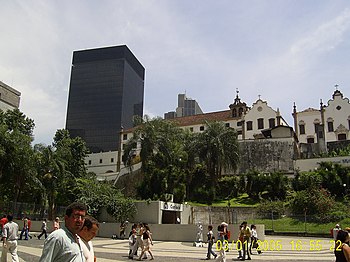
When shopping in street commerce, always bargain; this can lower prices considerably. Bargaining in stores and malls, though, is not welcome. But naturally merchants won't bargain unless you ask, especially if you are clearly a tourist. To tourists, items can easily be overpriced by a factor of 20% especially in highly informal markets such as Saara or on the beach.
For trinkets, your best bet is the "hippie fair" in Praça General Osório in Ipanema every Sunday.
Great bargains can be had on Brazilian-made clothing, as well as some European imports. Most imported items, however, such as electronics, tend to be insanely expensive due to protective import duties. For example, you will find digital cameras sell for about twice what they sell for in Europe or the U.S.
Store managers in Rio often speak some English, as this gains employees an almost-automatic promotion. But "some" can be very little, so it is useful to learn at least some very basic Portuguese. Just knowing basic greetings, numbers, and how to ask directions and prices will get you at least a "B" for effort, and despite finding that store clerks may know more English than you Portuguese, it can still come in handy to know a bit of the language. Don't be afraid to resort to writing numbers, pictures, or resorting to pantomime. Shop assistants will often tap out prices for you on a calculator. Visa and MasterCard are widely accepted in Brazil, with American Express to a slightly lower degree but this have been improving.
A great choice of gift, since they do not take much space in the suitcase back home, are bikinis, a trademark from Rio for its quality and fashion style.
Shopping malls can be found all over town, with the cheaper ones in the Zona Norte like Shopping Tijuca and Shopping Iguatemi and popular upscale shopping malls concentrated in the Zona Sul like Shopping Rio Sul and Shopping Leblon and São Conrado Fashion Mall and BarraShopping in Zona Oeste .
Organic Food
Organic food arrived in the Brazilian supermarkets but if you want to support local small scale farmers you might consider the following fairs of Circuito Feiras Organicas Carioca :
Ipanema, Praça Nossa Senhora da Paz, from 7h to 13h
Tijuca, Praça Afonso Pena, from 7h to 13h | LEBLON, Praça Antero de Quental, from 7h to 13h
Bairro Peixoto, Praça Edmundo Bittencourt, from 8h to 13h | GLÓRIA, Rua do Russel, from 7h to 13h | JARDIM BOTÂNICO, Praça da Igreja São José da Lagoa, from 7h to 13h
In Rio de Janeiro you can probably find something to fit any craving. A good approach to local food is "comida a kilo" - buffet style restaurants where you pay by the weight of the food on your plate. An excellent place to go with your friend or even with your partner is the Fellini restaurant. Located in Leblon, the place has a "pay for what you eat" buffet, with really good and beautiful food. Great for all tastes, it has even Asian food on the menu. Another one is Ming Yue, Rue do Lavradio 106, near Lapa. Ming Ye offers a wide range of Chinese stir-fry and delicious sushi, as well as Brazilian dishes for cheaper prices.
Don't miss the most famous Brazilian dish, feijoada (fay-zho-AH-da), a black bean stew filled with big chunks of meat, like sausage, pork and beef. Along with the "feijoada", you also get some colorful side dishes that come with it, such as rice, cassava (roasted manioc), collard greens, fried pork rinds, and some orange slices, to sweeten things up a bit. This is bonafide, authentic carioca culinary excellence, almost worth the trip alone! Best while sipping down a "caipirinha".
For the hungry, nothing beats a good rodízio (all-you-can-eat service). These are available in numerous types, although the most well-known are the churrascaria , all-you-can-eat grilled meats. Marius , in Leme has arguably the best churrascaria in town. Carretão has a good and cheap(er) rodizio. At various restaurants around town, you can also find rodízio style dining featuring seafood, pizza, or various appetizer-style snacks. The defining element of rodízio is that unlike an all-you-can-eat buffet, the servers continuously bring skewers of various meats.
If you like meat but want an alternative to the rodizios, a good place to eat at is Filé de Ouro (Rua Jardim Botânico, 731, Jardim Botânico; ☏ +55 21 2259-2396 ; see Google Maps for directions). The place is simple and cozy. During the weekends there are usually big lines, but the steak is delicious. Try "Filé à Oswaldo Aranha", with toasted garlic.
Brazil has the largest population of Japanese outside of Japan , and sushi has become widely popular in Rio too. If you are a sashimi and sushi lover, you will find a great deal of options in Rio de Janeiro. If you are in Ipanema or nearby, a great tip is Benkei [ dead link ] , that has an "all you can eat" buffet, with high quality products, great environment and staff for nice prices.
As a former ex Portugal colony, Brasil has maintained many influences of this country on its culinary. Therefore, you will find great authentic Portuguese restaurants in Rio. A good option, from the localization to the ambiance, and naturally the food, is the CBF Restaurant , in the Tiradentes Square, a lovely area full of antique architecture.
In Ipanema, Zazá Bistrô [ dead link ] is a trendy, sexy and exotic place with great South Asian dishes. Good to go as a couple.
Because its huge coast, many Brazilian specialties are in the seafood area. They are very rich in shrimps, lobster, calamaris, shellfish, clams, mollusks and many other tasty fishes. So, once in this land, don't miss the opportunity to order those lovely dishes.
The highest recommendation for a decently priced superb meal is at Sobrenatural , that has the some of the freshest fish in Rio. Go on Monday, Wednesday or Friday, when they have live samba and chorinho music by renowned artists. Try their moqueca dishes. It is located at Rua Almirante Alexandrino, 432 Santa Teresa.
For sophisticated people who enjoy simple life, Via Sete is in the heart of Ipanema, on Garcia D'Ávila. This grill restaurant offers a great bang for the buck: from their veranda you get to people-watch pretty Brazilians. There you can enjoy tasty wraps and sandwiches.
Travellers with fatter pockets may also splash out a bit at the Dias Ferreira street in Leblon, Rio's up-and-coming restaurant row.
There are many places to get pizza and lots of restaurants also offer pasta.
Rio is also famous for its pastries and street food, heritage from Portuguese and old European culture. In most cafeterias ( lanchonete ; lun-sho-NETCH) you can have a pastel (pahs-TELL) or salgado (saw-GAH-do; local pastry). Typical pastries are coxinha (ko-SHEEN-ya; chicken nugget shaped like a chicken leg), and unique Rio's joelho (zho-EH-lyo; rolled dough filled with ham and cheese). Also try pão de queijo (pawn-deh-KAY-zho; cheese baked dough), typical from Minas Gerais but very common in Rio as well, and tapioca (typical from Bahia ), a kind of crepe made out of manioca flour.
For drinking, ask for guaraná (gwa-ra-NAH; soda made from the seed of an Amazon fruit, also available as a strong drink), mate (MAHTCH; sweet ice tea; not like Rio Grande do Sul or Argentina 's hot and sour mate ), água de coco (ah-gwa-djee-KOH-ku; natural coconut water) or caldo de cana (caw-do-djee-KAH-na; sugarcane juice). There is also a common fruit called açaí (ah-sah-EEH), with a dark-purple pulp out of which are made juices, and ice-creams. Typical cariocas eat it like cream in cups or glasses, mixed with granola , oats or other flakes. The best place for such drinks are one of a number of Rio's open juice bars. Very often, these are located on street corners and have long, curved bars offering you juices from pretty much every fruit you can imagine. The best option is a small chain of juice bars called "Big Bi's" . The juices are astounding value alongside their good selection of salgados and sandwiches. Their açaí is one of the best in terms of value and taste and the staff are excellent. On top of all this, if you leave a tip, you get a big " Obrigado " from all the staff. For the best Big Bi's experience, try the Tangerina ao Limão juice along with the famous Bauru sandwich. Finish it all off with an açaí to go. Perfect. Big Bi's has a few branches dotted around Copacabana and Ipanema, one of which is on the corner of Rua Santa Clara and Rua Barata Ribeiro in Copacabana. If you then cross the road of Rua Barata Ribeiro, you will land at an exquisite ice cream parlour.
There are many specialized "health food" shops that offer an incredible variety of rich meat and vegetable sandwiches, plus an awesome variety of fruit juices, many of them delicious and usually unknown by foreigners. Among them are graviola, fruta do conde, jaca, açaí, guaraná, pitomba, mango, coconut, orange, lemon, papaya, melon, etc. (they make it as you ask and all food is 100% organic and fresh. The meal is often prepared as you wait, so you can ask them to mix whatever fruit you want and create a customized mix if you like). You must try açaí and guaraná, Amazon fruits which are famous to be the strongest energizers and anti-oxidants of the world. They also offer Brazilian snacks (including many Italian and Oriental delicacies), and other simple but delicious things to eat. I never got enough of them! These shops usually are cheap and hang many fruits at the entrance or somewhere visible to display their quality.
Warning: look for clean places, as hygiene can be poor in many street shops.
If your palate is homesick for more familiar tastes, Rio has most of the fast-food chains found around the world (McDonald's, KFC, Domino's, Outback, Subway, Pizza Hut and Burger King). Bob's and Habib's are the biggest national fast food chains.
Many foods that in other countries are simply picked up in the hands and eaten, are either eaten with knife and fork (such as pizza) or are picked up by wrapping a napkin around the food so that it is not touched with the hands (such as sandwiches). You will undoubtedly notice napkin dispensers on the tables in most restaurants for this purpose.
After Hours
Leaving a club or a bar, late in the night? The best option is Cervantes in Prado Júnior Street, in Copacabana. It closes only with the sun raising. The menu is composed by big sandwiches, with whatever you want: ham, salami, cheese, tenderloin and so on, with one home special ingredient: a big pineapple slice. It's a tropical taste to the end of your night. Look out for the legendary "Penguin Waiter", who've been working there forever. You won't have a problem to find out who he is.
- Botequim (pronounced 'boo-chi-KEEN') also well known as boteco - These quite unpretentious bars with simple appetizers and lots of ice-cold chope (draft beer) are everywhere and are almost inseparable from the carioca lifestyle. Try Bracarense ( 85, José Linhares street, Leblon ), one of the most traditional.
- Juice bars - Of particular note for an often hot and muggy city are the refreshing juice bars, found on nearly every corner in the city. Choose from dozens of freshly squeezed fruit juices - mix two or three fruits together or simply try the freshly squeezed orange juice. For a delicious Brazilian special try the açaí , a smoothie made from a deep purple fruit from the Amazon.
- Caipirinha , a drink made of cachaça (a Brazilian liquor made of sugarcane juice), lime, sugar and ice cubes.
- Kiosks along the boardwalk at Copacabana and Ipanema beach stay open all night.
- Devassa . Nine locations in Rio (and one in São Paulo), including Leblon (Rua General San Martin 1241, +55 21 2540-6087) and Jardim Botânico (Av. Lineu de Paula Machado 696, 021-2294-2915). Well-crafted microbrews, a tropical take of English ale styles.
Neighborhoods:
- Lapa - A good bet for Thursdays, several bars and clubs, but the party is in the street. There you will find people dancing and playing Samba, Choro (soft rhythm with flutes and mandolin), Reggae and Hip Hop, as well as ballroom dancing ( gafieira ), but no Rock (except for some underground, which doesn't happen often or in the same place, but usually in some less known places of Lapa) or Pop music. While drinks are sold in the bars and clubs, vendors also roam the streets wearing coolers full of beer for even cheaper prices. It can also be a very exciting and packed place on Friday and Saturday nights. Be sure not to bring valuables, as there are a lot of pick-pockets operating in the area. Don't take it for the neighborhood with the same name in São Paulo , which is totally different.
Samba clubs
Being in Rio and not going to one of the countless samba live music bars, certainly you've missed a lot on your trip. In Lapa , the nightlife district of Rio, there are many nice bars with great atmosphere where locals go for dancing and meeting people. There are a couple of them in the Zona Sul as well. Most of these bars work with a kind of consumption card, which is handed to you when you enter. Everything you consume is marked on this card, and losing it means you'll have to pay a really high fee! So take good care of it.
For those who like to go clubbing, Rio has some good options. You'll be seeing lots of flyers and talk about "raves" Usually Rio's raves are devoted to trance, which is pretty popular, especially with the upper-class youngsters, though some electronic parties do have good djs and live acts from around the world. The night in Rio is pretty much divided between mainstream and underground.
Mainstream would be such "raves" and big electronic festivals, as well a nightclubs like Zax Club (Barra da Tijuca), Baronetti (Ipanema) and Boate Praia (Lagoa) that are devoted to pop, dance and variations of house and trance. Those are not, however, places you go for the music. They are usually packed with "patricinhas" (tanned, long soft-haired girls with gym-built bodies) and specially "pitboys" (upper/middle-class boys, known for having various degrees of martial arts training and a certain tendency for violence). Yes, fights are one of the major problems with the mainstream clubbing scene in Rio. It's also fairly expensive.
Though with far less options, the underground clubbing scene is more available and interesting than the mainstream. Most of the underground clubs are on Zona Sul and offer different parties for each day of the week. The underground club scene has a more diverse public, from goths to punks also with strong hedonistic tints. It's very gay-friendly and most of the parties and clubs have almost the same m/f proportion. It is also far cheaper than the mainstream clubs. Some good alternative clubs are Fosfobox (Copacabana), Dama de Ferro (Ipanema) and Casa da Matriz (Botafogo).
For a real "carioca" experience, try Mariuzinn Copacabana. Brazilian Funk and electronic music, with an eccentric crowd. It just finishes when the last dancer gives up. Which means early in the morning. It will be an unforgettable experience.

In the Zona Sul , you will find Rio's fanciest and most popular hotels along the beaches of Ipanema and Copacabana, but there are lots of small, cheap, clean hotels around Flamengo and Catete. The street in front of the strip of tourist hotels in Copacabana can be seedy, due to both garishly-dressed tourists, and a few opportunistic locals ready to take advantage of them. The apart-hotels in Ipanema are a much more pleasant alternative, being both better appointed and in a nicer neighborhood with fewer tourists.
Accommodation in the lower Centro can be convenient for business travellers. The surrounding areas, however, are far from pleasant at night, being nearly deserted and lacking decent restaurants and leisure options. The central Santa Teresa neighbourhood, however, is quite departed from the city centre life and has plenty of pleasant bed and breakfasts and a significant nightlife.
Given Rio's rise as a fashionable destination with creative and fashion people, some hotels that cater to the design-conscious crowd have also been popping up at the most upscale neighborhoods. The city also has a large selection of apart-hotels , which provide apartment-style accommodations with kitchen facilities. Private condominium apartments can also be rented short-term at reasonable rates, and can be found on the internet. This is probably a preferable means of finding one of these than the notes that will be passed to you by anonymous persons on the street. These apartments generally have a one-week minimum, or two weeks during Carnaval or New Years holidays.
Accommodation in Rio is probably Brazil's most expensive . There is a relative shortage of hotel rooms on the cheaper range and booking in advance is recommended. Moreover, prices for most accommodation can more than triple during New Year's and Carnaval. Those are very busy periods and booking well in advance is recommended. Most hotels in tourist areas will only sell 4-day packages and charge in advance - even if you want to stay only for a couple of days during those events. Other than those, the busiest month is January - summer holidays in Brazil.
Motels, that you will see mainly on the outskirts of the city, are not motels in the North American sense. Rather, they are places you go with your lover for a few hours. One famous motel, overlooking the Sheraton in Leblon, was taken over by the US Secret Service when George Bush Sr stayed at the Sheraton. It is not recorded whether heart-shaped beds, mirrors on the ceiling and on-tap porno movies affected their work!
If hostel life is more your style, they are easy to find in Rio. The more expensive ones boast locations that are short walking distance to either Ipanema or Copacabana beach. However, if you prefer to stay in Lapa, Glória, Catete, and Botafogo, there are many other choices available. Hostelling has become increasingly popular in Brazil, and many of them are located at walking distance from hot spots. Beware, however, not to be taken to any fraudulent scheme - you might end up being robbed. Look for accredited places with Youth Hostelling International and similar franchises.
To experience Rio from another point of view, there's also the opportunity to stay in various hostels in one of the favelas. Due to presence of many police units (called Unidade de Polícia Pacificadora, UPP), it is reasonably safe to stay in some favelas. Ask your hosts about the actual situation, though. See for example Zona Norte for a stay in the Complexo do Alemão .
Stay healthy
Rio is vulnerable to epidemics of dengue fever , particularly during the late summer months of February and March. If an epidemic occurs, be sure to take the appropriate precautions by using insect repellant and, if you happen to be staying at a place with a balcony, make sure there is no standing water around.
As elsewhere in Brazil, some beaches in Rio are not suitable for bathing, and conditions can change from day to day. On the day of your visit, check the latest weekly bathing bulletin (in Portuguese, boletim de balneabilidade ) of the state's Environment Department (INEA). At the bottom of the page, there is a large ad for a mobile app called Partiu Praia Inea that provides you an up-to-date map of bathing conditions.
Use sunscreen, especially in your face and shoulders, to avoid having a bad experience with sunburns. Any common drug store sells a variety of sunscreen products, and even cocoa butter lip sticks, to avoid having little cuts after dry lips.
Here is a list of medical clinics and hospitals in Rio de Janeiro:
- Hospital Copa D’Or - Address: Rua Figueiredo de Magalhães, 875 – Copacabana, Rio de Janeiro – RJ, 22031-011 - Phone: +55 (21) 2545-3600
- Hospital Rio Laranjeiras - Address: R. das Laranjeiras, 72 – Laranjeiras, Rio de Janeiro – RJ, 22240-000 - Phone: +55 (21) 2555-2000
- Hospital Israelita Albert Sabin - Address: Rua Professor Gabizo, 319 – Maracanã, Rio de Janeiro – RJ, 20271-065 - Phone: +55 (21) 2176-8800
- São Lucas Hospital-Copacabana - Address: Condomínio de Hemodinamica – Tv. Frederico Pamplona, 32 – Copacabana, Rio de Janeiro – RJ, 22061-080 - Phone: +55 (21) 2545-4000
- Hospital Samaritano Barra - Address: Av. Jorge Curi, 550 – Barra da Tijuca, Rio de Janeiro – RJ, 22775-001 - Phone: +55 (21) 3263-1000
- Ibogaina Rio de Janeiro - Address: R. Bom Pastor, 295 – Tijuca, Rio de Janeiro – RJ, 20521-060 - Phone: +55 (21) 2159-2300
- Hospital Unimed Rio - Address: Av. Ayrton Senna, 2550 – Barra da Tijuca, Rio de Janeiro – RJ, 22775-003 - Phone: 0800 031 3861
Public Hospitals of the State of Rio de Janeiro
- Hospital Estadual Getúlio Vargas - Address: Av. Lobo Júnior, 2293 – Penha Circular, Rio de Janeiro – RJ, 21070-061 - Phone: +55 (21) 2334-7856
- Hospital Universitário Pedro Ernesto - Address: Boulevard 28 de Setembro, 77 – Vila Isabel, Rio de Janeiro – RJ, 20551-030 - Phone: +55 (21) 2868-8000

Rio De Janeiro's reputation as a dangerous city was cemented internationally by the critically acclaimed movie Cidade de Deus — a reputation that's not entirely unwarranted, but most visitors to the city have a great time with no incidents.
Still, Rio can be dangerous . As a traveler, even if you don't leave the "Zona Sul" (which includes Copacabana, Ipanema, Leblon, Gávea, Jardim Botânico, Flamengo, Laranjeiras, Botafogo, Urca) or Western Suburbs (Barra, Recreio), you may experience a palpable tension over security.
Generally, tourists (also called "gringos," which is not derogatory but means "outsiders") and teenagers are considered "easy" targets for criminals. Day-to-day living has also been affected by this. For example, regular banks all have fortress style security doors and armed security men. Rio can be a dangerous city and it is wise to follow these rules even if they seem exaggerated.
In order to fully enjoy your trip the traveler should pay attention to simple things. Avoid the downtown area, especially Saara , after dark. Although downtown is a relatively safe place during the day, after-dark all the people who work there have already gone home. If you are going to a theater or a show, it's all right; but do not wander in those dark streets by night. It is better to take a taxi/Uber direct from your hotel to your final destination and back rather than go around seeking for public transport. Go to Ipanema beach, which is relatively safe at night as long as you don't stand out as an obvious tourist. In general, crowded areas with good lighting are safer, and you should avoid dark, empty places.
On Sunday, most shops are closed and their security guards are absent, so the neighbourhood Centro is not safe in the daytime. Also, even the bigger streets in Copacabana are less safe after dark so the beach walk is probably the best option.
Should you find yourself being mugged, the normal advice applies:
Don't resist or do anything to aggravate the muggers. Try not to stare in their faces as they might think you are memorizing their appearance. Eyes to the ground is probably your best bet. Let them take anything they want (keep your arms limp). Afterwards, leave the scene quickly but calmly (don't run in panic screaming for the police).
In the morning, especially before the police arrive, if you are walking or jogging on, Copacabana should be considered unsafe. Even with people around, joggers are popular targets for mugging. If you plan on jogging make sure not to wear anything that may tempt a mugger (watch, iPod etc.) and if you can, wait until after 10AM.
Don't walk along the banks of the Rodrigo de Freitas Lagoon (South Zone) after dark, you might get robbed.
When in downtown during the rush hour, be aware of pickpockets as in any other big city centre. The difference in Rio is that the pickpocket can often be a bit violent: one of them pushing you forward in the bus or to the ground in the street while another one takes your wallet and runs away. It's not that usual or as bad as it sounds, but try to avoid being in real danger by reacting strongly as these guys often operate in armed groups (2-5 people), some unnoticed by you.

In the area around Copacabana beach (and maybe in the city centre), the tourist should be aware of a shoe shining scam. The tourist will be approached by a shoeshiner and to his astonishment discover a large, dirty blot on his shoes (which is actually shoe polish or mustard but looks like quite something else). The tourist is typically shown to a chair and has his shoes or sandals cleaned in the best manner. Only after this service is rendered, the outrageous price of somewhere around R$1000 or more is revealed. At this point, muscular friends of the shoeshiner typically appear to "oversee" the completion of the transaction.
The subway is very safe, so it is recommended to use it if you want to go from one place to another.
The suburban rail is generally not useful for tourists. If you do take it, note that trains may not come all that frequently, especially on weekends, and they tend to be filled with hawkers selling various cheap goods and sometimes evangelical preachers. Although the trains themselves are generally safe, a lot of the stations aren't, especially on the Belford Roxo (purple) line. Avoid photography on the suburban rail system.
Buses on the South Zone are fairly safe as well, but they can be quite crowded. Inside a bus, being mugged is always a threat: less so but still possible in the South and tourist zones. Don't use a phone while sat next to an open window since it can get snatched from your hand. Remember that Bus 174 movie. It happens so often that they don't even go to the news (only homicides or big cases where the police got involved such as this Bus 174 go to the news). In the subway, it is very unlikely though, which is one extra point to the subway!
Don't walk around with lots of money in your pocket. ATM's are everywhere (prefer the ones inside shopping centres) and credit/debit cards are widely accepted. But don't walk around without any money: you may need something to give to the bad guys in case you are mugged. Not having money to give a mugger can be dangerous as they may get angry and resort to violence. An excellent idea is to buy a "capanga" (literally meaning bodyguard), that is, a small frontal unisex pouch, normally used to carry your wallet, checks, money and car keys.
Avoid wearing jewelry or other signs of wealth (iPods, fancy cell phones/mobiles, digital cameras, etc.) if possible, at any time of the day, as these attract attention. Thieves have been known to run past targets and tear off necklaces, rings, and earrings without stopping. Earrings are particularly dangerous as tearing them off often harms the owner.
There are around 700 favelas in the city and some of them can potentially be unsafe in Rio: and there is always one near you (by a couple of miles or just a few yards). These are easily recognized by their expansive brick walls, and are often on a hillside. The slums grew from being impoverished neighborhoods. They were known for being ruled by drug lords prior to a concerted effort to retake them by the police. For the more adventurous, some favelas are amazingly huge, and a new experience for some—there are some travel agencies who take people on tours there. The tour operators have "safe-conduct pacts" with the local drug dealers. If you try to get a tour without using one of those agencies think carefully about whether your guide is reputable. Despite the pacifying efforts, most favelas do not have a permanent police presence, so there is often no recourse for a traveller who is ambushed by a drug baron's guards.
In Brazil, every state has two police forces: the Civil ( Polícia Civil ) and Military ( Polícia Militar ). Only the latter wear uniform (in Rio, it is navy blue). The city of Rio also has an unarmed Civil Guard, dressed in khaki. Policemen can usually be trusted, but corruption in Brazil is still rampant and a few officers may try to extort you or demand a little bribe. When this happens, it is usually very subtle, and the officer may typically say something about "some for the beer" ( cervejinha ). If you are not willing, refuse and ask for another officer. Don't ever try to bribe a policeman on your own—most of them are honest and you might end up in jail.
The local emergency dial number is 190 .
At night, especially after traffic has died down, you may hear what sounds like fireworks and explosions. This is not as menacing as it sounds, though it is still indicative of somebody up to no good. These are often firecrackers set-off as signals in the favelas. It might mean that a drug shipment has arrived and is in-transit or that the police are making a raid into the favela. It is a signal to gang operatives who act as lookouts and surrogate police to be extra-vigilant. However, real shoot-outs may occur, especially on weekends. If you are on the street and you hear a shooting, find shelter in the nearest shop or restaurant.
For your safety, cross at the crosswalks, not closer to the corner, and watch for cars regardless of traffic lights.
Carjacking can be a threat too, especially if you are outside the tourist areas and after dark. It is perfectly acceptable (even if not exactly legal) not to stop at the traffic lights if there is nobody else on the street and you feel it's okay to go (if there are no other cars). You will see even police doing this. Some major motorways such as Linha Amarela (Yellow Line: connects the west zone( Barra da Tijuca ) to the north zone - may be your way to Norte Shopping for example) and Linha Vermelha (Red Line - the main connection from the International Airport) are strongly avoided late at night. Both motorways are surrounded by favelas, so carjacking is usual and shoot-outs may occur between rival drug lords or between drug lords and the police. If you rent a car, be aware of all these issues. As a tourist, it may be better not to rent one anyway, as if you get lost and go to a bad neighbourhood (and again, there will always be one near you), you will most likely be in trouble.
If you want to go to a traditional escola de samba (samba school), Mangueira is a good place. This is close to a favela, so you should go with a guide accordingly. If you do have a trustful Brazilian friend that can take you, that's excellent. Ask the friend to take you to Maracanã as well to watch a football (soccer) match! Yet exercise great caution if you go by yourself especially if two of the local Rio teams are playing (Flamengo, Fluminense, Botafogo, and Vasco). These matches can be very exciting but also very dangerous especially if between Flamengo and Botafogo or Vasco. If it looks like the team for which the fans around you are cheering is losing, it is wise to leave the stadium before the match ends. You don't want to be in the middle of a very angry bunch of football fans when they all cram out of the stadium.
The Rio Times is the only English language news publication dedicated to the English speaking foreign community living and traveling in Rio de Janeiro, Brazil. They have been publishing weekly online since March 2009, covering Rio Politics, Business, Real Estate, Sports, Entertainment, Travel, as well as offer Classifieds and a daily Rio Nightlife Guide.
- Lavamaq's , Praia do Flamengo, 118 - Flamengo ( two blocks south of Metro Catete ), 21 2557–5965. Self-service laundry, R$25 wash and dry.
Consulates General
- Niterói – 15 km from downtown . It has a wonderful unique view of Rio and an intriguing contemporary art museum, which looks like an UFO (designed by famous architect Oscar Niemeyer). Also, it has one of the state's most beautiful beaches, Itacoatiara, which can be reached by the bus # 38. From Rio to Niterói it's a short ferry ride or you go by bus.
- São Gonçalo – 25 km from downtown. The biggest city of the Leste Metropolitano region, with the second largest population in the state .
- Duque de Caxias – 20 km from downtown. The largest city of Baixada Fluminense , neighboring to the Rio de Janeiro's North Zone.
- Maricá – 55 km from downtown. The last municipality on the sea coast of Grande Rio to the east. It has several lagoons and a single strip of sand that extends along almost the entire shoreline of the municipality.
- Rio Bonito – 75 km from downtown. A peripheral municipality, with a small population and wide rural areas with lots of nature. It is the easternmost municipality in the metropolitan area of Rio de Janeiro.
- Cachoeiras de Macacu – 90 km from downtown. The most northeastern municipality of Rio metropolitan area, it is another peripheral municipality which has become an attraction for trekking, mountaineering, rappelling and other types of extreme sports and ecotourism. Part of the Três Picos State Park is in the municipality. There are dozens of waterfalls of extraordinary beauty. The bus company 1001 goes for around R$45.00 (Sep 2023), departing from the Rio's long-distance bus station ( Rodoviária Novo Rio ).
- Guapimirim – 75 km from downtown. The most northeastern municipality in Baixada Fluminense, at the foot of the mountain range known as Serra dos Órgãos , a section of a longer mountain range called Serra do Mar .
- Paracambi – 70 km from downtown by railway (80 km by road). The most northwestern municipality of Baixada Fluminense and of the metropolitan area, at the foot of Serra das Araras , a more western section of Serra do Mar . The bus company UTIL has a route to the municipality for around R$40,00 (Sep 2023) departing from Rodoviária Novo Rio .
- Itaguaí – 70 km from downtown. Another peripheral municipality, bathed by the Sepetiba Bay, it is the last coastal municipality of the metropolitan agglomeration of Rio to the west.
On the southeastern coast of Rio State
- Saquarema – 110 km. A predominantly tourist city with beautiful beaches, in the lakes region. It is known as "The national surfing capital". Further attractions are waterfalls, cascades, mountains and an archaeological site.
- Búzios – 170 km. It's a small peninsula with several nice beaches, an abundance of night clubs and the lowest rainfall in the state of Rio. It's nickname is "Saint-Brazilian Tropez".
- Cabo Frio – 170 km. A popular tourist destination. It's famous for its beautiful beaches with fine white sand and crystal clear waters.
- Arraial do Cabo – 170 km. It's a small town near Búzios. Its beaches have the most beautiful turquoise waters of Rio de Janeiro state. Beaches like Forno and Prainhas do Atalaia are surrounded by virgin lush green coastal vegetation and have clear blue waters similar to the Caribbean ones.
In the northwest
- Miguel Pereira – 120 km. It's famous for its exuberant nature, cool climate and tranquility, for those who want to escape the hussle of big cities. One of the most visited spots is Lake Javary, where you can ride a pedal boat and breathe the fresh mountain air. The intercity buses of Util have rides for around R$40 (Dec 2021).
In the north
- Petrópolis – 70 km. In the mountains outside and a good place to cool down when Rio becomes too hot. It's known as an "Imperial City", the place chosen by Brazil's Royalty to spend the summer. There's a nice imperial museum. The city also hosts one of Brazil's first breweries which can be visited.
- Serra dos Órgãos National Park , Parque Nacional da Serra dos Órgãos — National park in the mountains.
- Teresópolis — Another mountain town, near Petrópolis.
In the west
- Ilha Grande – 180 km. It's noted for its scenic beauty, unspoilt tropical beaches, luxuriant vegetation and rugged landscape. You will enjoy hiking.
- Has custom banner
- Huge city articles
- Has mapframe
- Maps with non-default size
- Airport listing
- Listing without plain text name
- Has map markers
- Articles with dead external links
- Move listings to districts
- See listing with no coordinates
- Do listing with no coordinates
- Drink listing with no coordinates
- Has caution box
- Has caution box with out of date warning
- Listing with multiple email addresses
- Has routebox
- Usable cities
- Usable articles
- City articles
- Cities with categories
- Has Geo parameter
- All destination articles
- Pages using the Kartographer extension
Navigation menu
- South Africa
- Afghanistan
- North Korea
- Adventure + Outdoors
- Amusement Parks
- Backpacking Trips
- Boating + Cruises
- Budget Travel
- Bus + Train Travel
- Coasts + Islands
- Country Trips
- Fall Vacations
- Family Vacations
- Green Travel
- Heritage + History
- Honeymoons + Romance
- Inspiration + Guide
- Landmarks + Attractions
- LGBT Travel
- Markets + Bazaars
- National Parks + Reserves
- Nature + Wildlife
- Parks + Gardens
- Pets + Animals
- Photography
- Airlines + Airports
- Budgeting + Currency
- Business Travel
- Celebrity Travel
- Customs + Immigration
- Deals + Rewards
- Family Travel
- Hotels + Resorts
- Luggage + Packing Tips
- Offbeat News
- Photography Tips
- Responsible Travel
- Solo Travel
- Tech + Gear
- Travel Etiquette
- Travel Warnings
- Bars + Clubs
- Celebrity Chefs
- Restaurants + Cafés
- Wine + Vineyards
- Beach Hotels
- Boutique Hotels
- Hotel Openings
- Hotel Reviews
- Luxury Hotels
- Mountain + Ski Resorts
- Spa Resorts
- Vacation Rentals
- Asia Cruises
- European Cruises
- Festivals + Events
- Museums + Galleries
- Style + Design
- Travel’s Best
- Hotel with Agoda.com
- Hotel with Booking.com

19+ must-see & best places to visit in Hokkaido

Bohol blog. The ultimate guide to the island of Bohol

Suggested Tokyo travel itinerary 3 days. How to spend 3 days…

Bohol travel blog — The fullest Bohol travel guide for first-timers

The complete Seoul subway guide: How to use, lines, fares for…

How much does it cost to travel to Korea? Tips on…

The ultimate guide to NETS FlashPay Card: What is it, how…

How much will it cost to go to Singapore? Tips on…

13 best, most famous & popular bubble tea in Taiwan

Where to eat in Penang? 17 best places to eat &…

Best bubble tea in Taiwan — Top 11 most famous &…

29+ must-try foods in Thailand

11+ best homestays in Kuala Lumpur near famous tourist attractions

Mövenpick Resort Kuredhivaru Maldives reviews. The detailed review of my vacation…

Hyatt Regency Danang Resort and Spa reviews. The resort is highly…

+7 luxury resorts you must stay in Danang, Vietnam

10 must-know things for your best first time European river cruise

Top 3 best luxury cruises in Halong Bay, Vietnam

Cherry blossom festival Korea 2024 — Top 5 cherry blossom festivals…

Ghibli museum blog — The fullest Ghibli museum guide for first-timers

Kyoto festival — Top 10 best events & most famous festivals…

National Palace Museum Taipei blog — What to see in National…

Japanese waterfall — Top 10 most beautiful waterfalls in Japan in…

19+ most beautiful towns in Europe every tourist need to visit…

Georgia travel photos — 20+ captivating photos show Georgia is heaven…

Explore Damnoen Floating Market — The oldest floating market of Thailand

Visiting Fenghuang Ancient Town — One of the most charming ancient…

Mekong Delta travel blog — Beyond rivers of Southwestern Vietnam

14 reasons why you should travel when you are young

Shigaraki Tanuki – An animal symbol of good luck in Japan

Living in the charms of cave houses in Andalucia, Southern Spain

20+ jaw-dropping tiny homes around the world
Rio de janeiro travel blog — the fullest rio de janeiro travel guide for first-timers.

Rio de Janeiro has beautiful natural scenery, stunning tropical beaches with fine white sand and warm waters, sparkling golden sunshine. Rio de Janeiro also has a unique culture, vibrant festivals, laidback and friendly people. Tourists also call the city’s name Rio for short. With a typical tropical climate, wonderful landscapes, vibrant street festivals and top-notch matches, etc., Rio de Janeiro is one of the most famous and attractive tourist destinations in Brazil as well as around the world. So, is Rio de Janeiro worth visiting, what to do and how to plan a perfect budget trip to Rio de Janeiro for the first-time? Let’s check out our Rio de Janeiro travel blog (Rio de Janeiro blog, Rio travel blog, Rio blog) with the fullest Rio de Janeiro travel guide (Rio de Janeiro guide, Rio travel guide, Rio de Janeiro tourist guide, guide to Rio de Janeiro) from how to get there, best time to come, where to stay, best places to visit, what to eat and top things to do to find out the answer!
- What to buy in Brazil? — 18+ must-buy souvenirs & best things to buy in Brazil
- Exploring Recife — The “Venice” of Brazil
- 10 best places to visit in Rio de Janeiro Brazil

Rio de Janeiro travel blog: Overview of Rio de Janeiro
Rio de Janeiro is a city in the south of Brazil. Traveling to Brazil without visiting this magical city is not complete. Rio de Janeiro covers an area of about 1,200 km² km2 with the current metro area population of nearly 13.7 millions people (2022), famous for its magnificent scenery, carnival festivals, samba and other unique types of music.
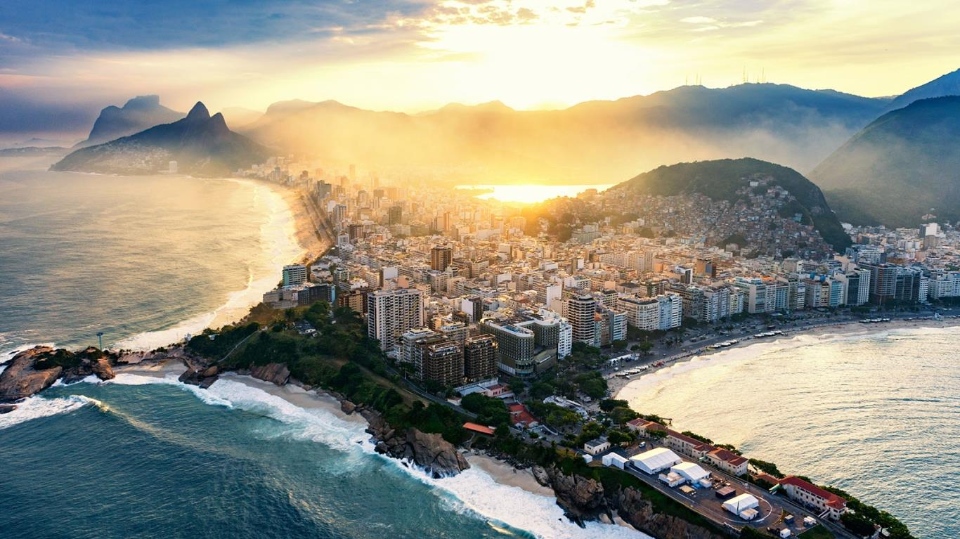
The name Rio de Janeiro in Portuguese means “River of January” and is often referred to as Rio. This city was once the capital of Brazil in the period of 1763 – 1960 and of the Portuguese Empire from 1808 – 1821. Referring to tourism in Rio, people often remember the vibrant samba dances, colorful and vivid carnival festivals, romantic stretches of beach. There is a statue of Jesus standing on the top of a mountain facing the sea that has become the symbol of the city of Rio.

In the early 19th century, Rio was once a city of slaves. In 1840, the number of African slaves who arrived in Rio was 220,000. The port of Rio de Janeiro was also the largest slave port in the Americas. Since Brazil’s independence in 1822, people in Rio de Janeiro have lived mainly on sugar cane farming and coffee farming in the valleys. The population that immigrated to Rio was mainly the poor of the empire, who later got rich quickly through industry and small business in Rio de Janeiro.
As a political center of Brazil, Rio de Janeiro has witnessed many historical periods and the heroic past of its nation and country. UNESCO recognized Rio de Janeiro as a world heritage site in 2012 (Exactly for a Carioca landscape area between the mountains and the sea). Today, Rio is a must-visit destination of any visitor when they traveling to Brazil.

Rio de Janeiro blog: When is the best time to visit Rio de Janeiro?

Rio is located on a stretch of the Atlantic coast, belongs to a tropical savanna climate, so the rainy season lasts from December to March next year, the temperature sometimes reaches the peak of 40 degrees Celsius in the summer, however, the annual average temperature ranges from 21 to 27 degrees Celsius. Rio often effected by cold air waves from Antarctica, so the autumn and winter weather is also colder, but compared to other European and Northern America countries, it is insignificant.
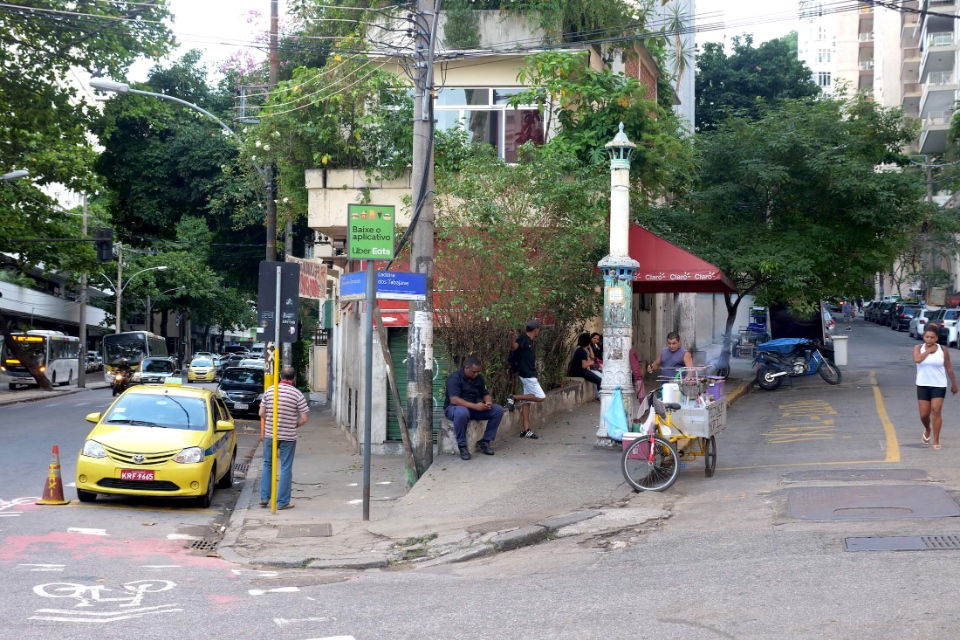
In inland areas, the temperature on summer days is usually above 40 degrees Celsius although it is rare for long periods, there are days when the temperature is just above 27 degrees Celsius. In general, the climate in Rio de Janeiro is quite dry and hot all year round. Therefore, if you plan to travel to Rio de Janeiro, do not forget to bring sunscreen.
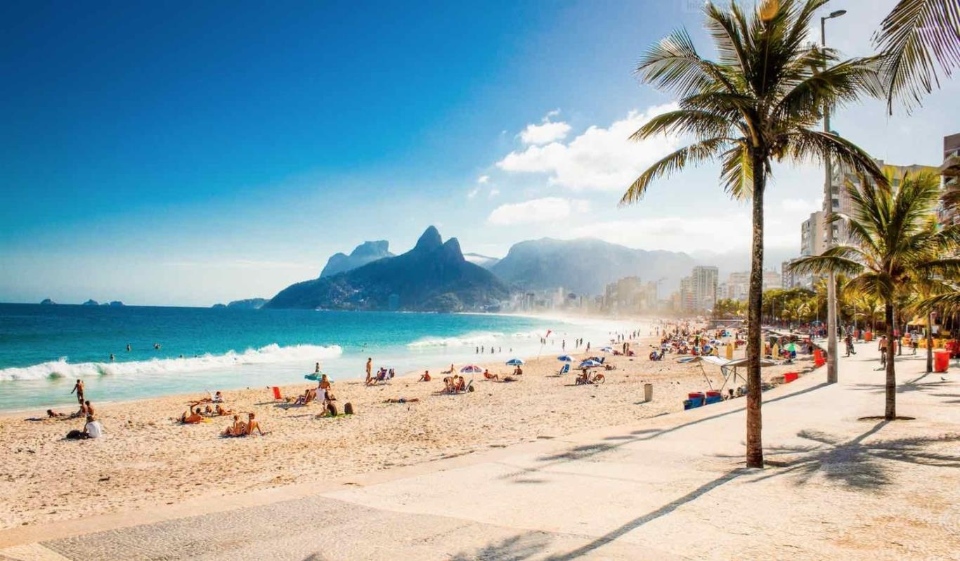
The most ideal time to travel to Rio de Janeiro is during the Carnival season in February every year, when the weather is quite cool, pleasant, convenient for walking, sightseeing and participating in outdoor activities. This is also the time when the very fascinating and exciting Carnival festival will take place in Rio, attracting hundreds of thousands of people from all over the world to participate. This is the most attractive carnival of the year, also known as the festival of love. When participating in the Rio Carnival, people will dress up in splendid and colorful costumes, especially colorful feather headdress. It will not be difficult for you to join the parade dancing around the streets with fiery dancers in a colorful space and vibrant, bustling atmosphere.

Rio de Janeiro travel guide: How to get to Rio de Janeiro?
Currently, to getting to Rio de Janeiro, the best way is travel by plane. However, currently from Vietnam, there are no airlines that open direct flights to Rio de Janeiro. You are forced to transit at 1 or 2 locations. There are many airlines to choose from such as Qatar Airways, Hong Kong Airlines, Vietnam Airlines. However, to save traveling costs, you can choose 1 of 2 low-cost carriers: Iberia (transit in Madrid) or TAP (transit in Lisbon) and land at Galeão International Airport (IATA: GIG, ICAO: SBGL).
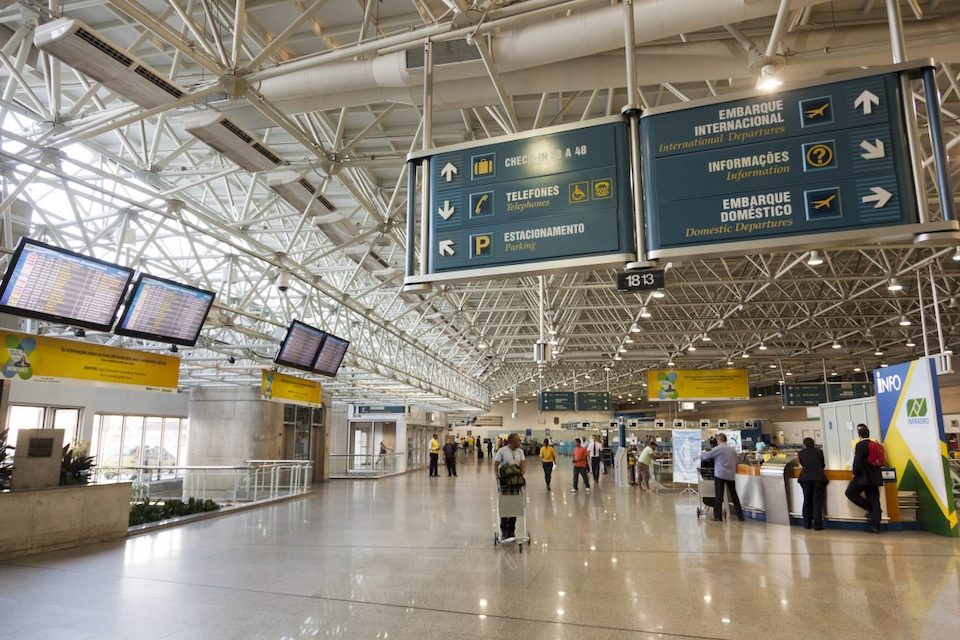
For visitors which depart from other cities around the world, you can access Google Flights , SkyScanner or Kayak to find best flights with suitable routes and cheap airfares.
For other ways to get to Rio, you can refer here .
Rio de Janeiro guide: Getting around Rio de Janeiro
When you arrive at the airport, you can take a taxi or take the subway to get to the city center. However, to save money you should go by subway because the taxi cost here is quite expensive. In Rio de Janeiro, traveling by subway is safe, convenient and clean. Train ticket price is only around 3.2 Reais (equivalent to about $0.61).
The subway is very safe, clean and fast, and the fare is also cheap, saving you money.

Traveling between famous attractions, you can use a bus, rent a bicycle, a long-distance taxi or a kombi (the Volkswagen Microbus). There are more than 60 bicycle rental stations in Rio de Janeiro, so you don’t have to worry about not knowing where to rent a bike. As for remote destinations, you should use a kombi because this vehicle is small, cheap and going faster than a bus.
If you want to visit places to visit, you can go by bus, or rent a bicycle or motorbike taxi. A type of vehicle commonly used by tourists in Rio de Janeiro is a bicycle and it is not difficult to rent.

Rio de Janeiro travel blog: Where to go, what to do in Rio de Janeiro?
Statue of christ the redeemer.
Address: Parque Nacional da Tijuca – Alto da Boa Vista, Rio de Janeiro – RJ, Brazil Hours: 8AM–7PM

Statue of Christ the Redeemer is a famous religious symbol of the city of Rio, located on the top of the mount Corcovado with 700m high, facing Guanabara Bay. The statue was recognized one of the new 7 wonders of the world and is known as the world’s most famous statue of Christ. The statue is 30m high, placed on an 8m high pedestal, has a 28m arm span, weighs about 635 tons, is the world’s 5th largest statue of Christ. The statue is made of reinforced concrete and metamorphic rock (steatite or soaprock), construction started in 1922 and completed in 1931.

The statue of Christ the Redeemer, designed with open arms, is a symbol of peace, becoming a cultural icon for the whole city of Rio de Janeiro in particular and Brazil in general. The statue of Christ is made of reinforced concrete and metamorphic steatite, the largest art deco style ever.
Visitors can take the train, car, taxi or cable car to reach the top. However, you should experience with train to admire the heavenly landscape of Tijuca National Park. In 2007, the statue of God was honored as one of the new 7 wonders of the world by the New7Wonders organization.
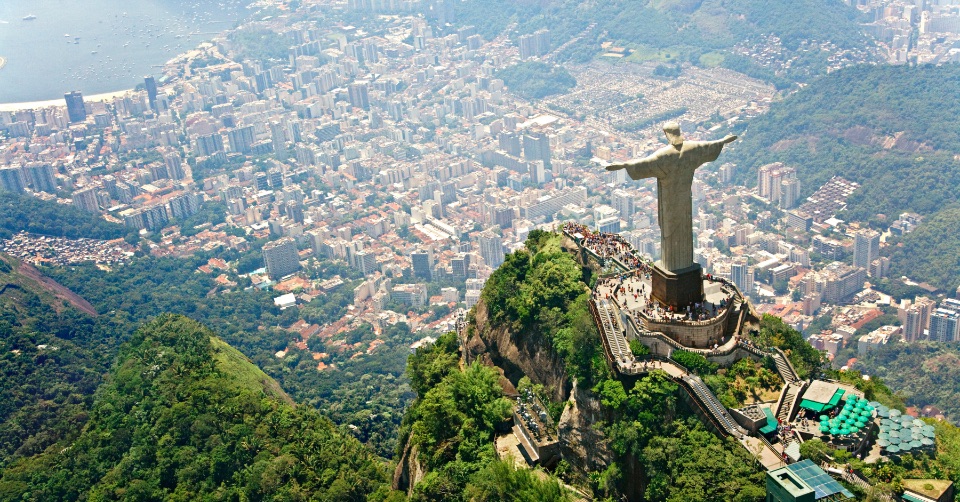
Paradise Beaches
Rio De Janeiro owns 80 km of coastline with warm water all year round. With an average temperature of 21 degrees Celsius, Rio de Janeiro is an ideal destination for those who love to relax on the beaches at any time of the year.

The beaches in Rio are clean, beautiful, the water is clear and quite warm. In particular, Copacabana is the most famous beach of this city. Copacabana stretching about 4.5 km, surrounded on both ends by towering mountains. This is also considered the most luxurious resort paradise in Rio city.
Along the beach is Atlantic Avenue running along the coast, between the avenue and the beach is a great seaside promenade, where you can go for a relaxing walk here. The beach area of Rio is very bustling all year round, you can see many tourists coming to swim, sunbathe, participate in beach sports activities, go for a walk or shop, watch movies, eat and drink…

Another beach that is as famous as Copacabana is Ipanema. Ipanema is a gathering place with the most young visitors. Coming here, you will join the local people to participate in beach sports activities such as swimming, surfing, paragliding, canoeing, soccer, volleyball, futevolei, to sports that combine volleyball and soccer…

The Grumari beach is the best windsurfing spot in Rio De Janeiro. Grumari has big waves that are most suitable for windsurfing. This beach with golden sand is surrounded by rocky mountains, located almost isolated, giving visitors a very interesting rural experience.
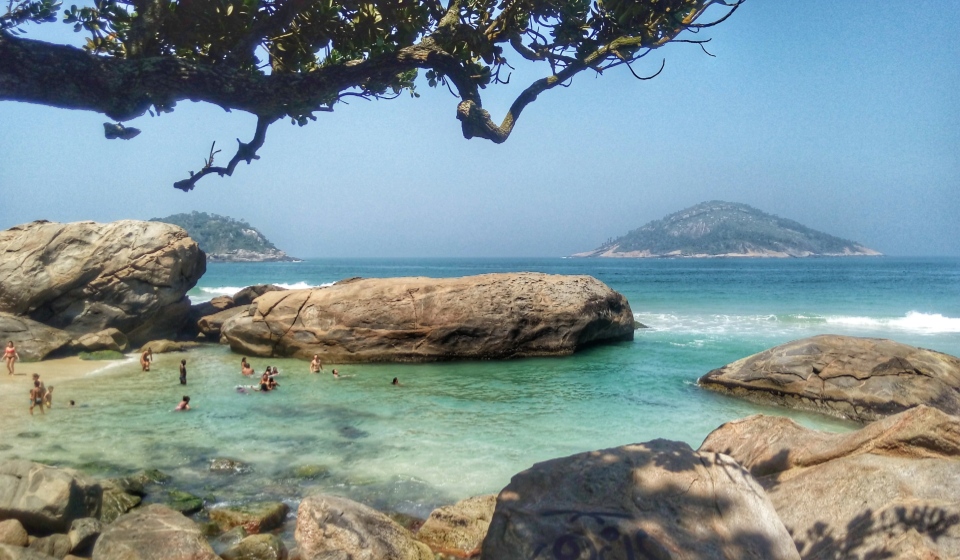
Located between Copacabana and Ipanema, this is the best place to watch the sunset over the cloud-covered mountains along the Arpoador coast. The scene will become fanciful and magnificent when the sun has just disappeared behind the peaks, leaving red streaks on the white clouds. At this moment, you can see surfers lounging on the beach resting while enjoying the picturesque scenery of Arpoador.

Prainha’s crescent-shaped sandy beach surrounded by mountains with crystal-clear blue sea water will captivate any visitor coming here from surfers, to families who want to enjoy the poetic beach, private and quiet. Here, there are many convenient stores selling food and drinks.

Barra Da Tijuca
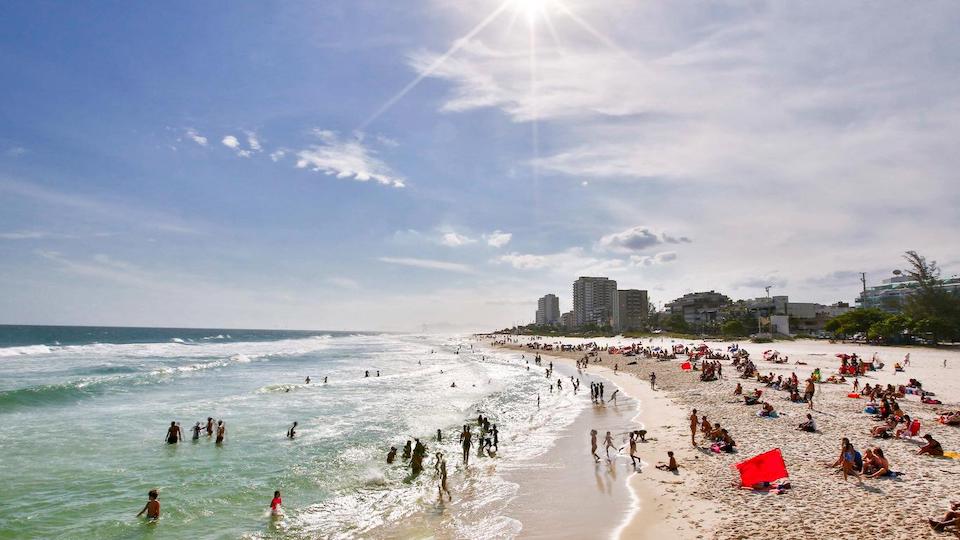
The longest beach in Brazil, Barra Da Tijuca is nearly 18km long. During the 2016 Olympic Games, the Barra Da Tijuca beach was the venue for many sports events such as longboarding, shortboarding, windsurfing, kitesurfing, windsurfing, etc. due to the weather and water conditions here very favorable for these sports. Along the coast there are quite a few schools that teach these sports for you to join.
Rio Carnival

Rio Carnival is the most famous street festival in Brazil, held annually in the Sambodromo neighborhood, with the focus of samba parades of famous dance schools in Brazil. Participating in the carnival, people will dress up in splendid costumes and accessories, join the street parade, admire the fiery performances of dancers, dance to samba tunes. Busy and immersed in the colorful space in the city of Rio de Janeiro.

The Rio Carnival event held at the Sambadrome streets with many parades of famous dancers has attracted millions of domestic and foreign visitors.
The Metropolitan Cathedral of Saint Sebastian

This church has a strange but modern architecture, designed by architect Edgar Fonceca, built from 1964 to 1979. This church has 4 huge doors, about 64 m long and hundreds of stained glass mosaic windows. Located in the heart of Rio, Metropolitan Cathedral of Saint Sebastian has the architecture like a pyramid in Egypt. The church can accommodate up to 20,000 people and is a religious site that attracts foreign tourists when visiting the city of Rio.
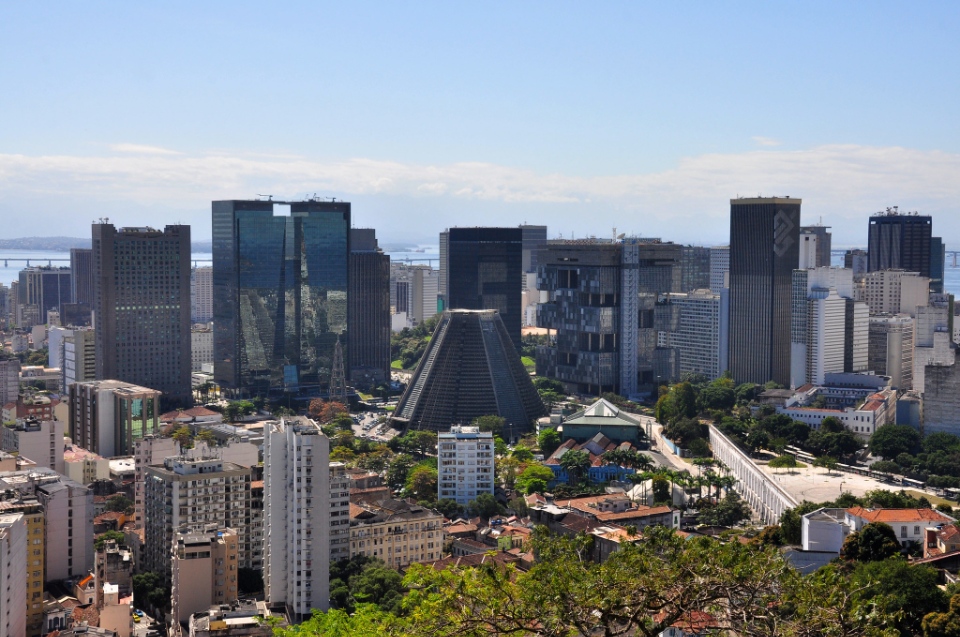
Maracana Stadium
Address: Av. Pres. Castelo Branco, Portão 3 – Maracanã, Rio de Janeiro – RJ, 20271-130, Brazil
Maracana is a major stadium and the venue for important sporting events in the world. This place stores images of Brazilian football talents through the ages, as well as a place to honor the country’s illustrious football background. This is the mecca of “soccer” in the world as well as in Brazil. The stadium is not only the largest in the world, but also a place to save unforgettable memories for Brazilian football when the national team lost to Uruguay in the 1950 World Cup final.
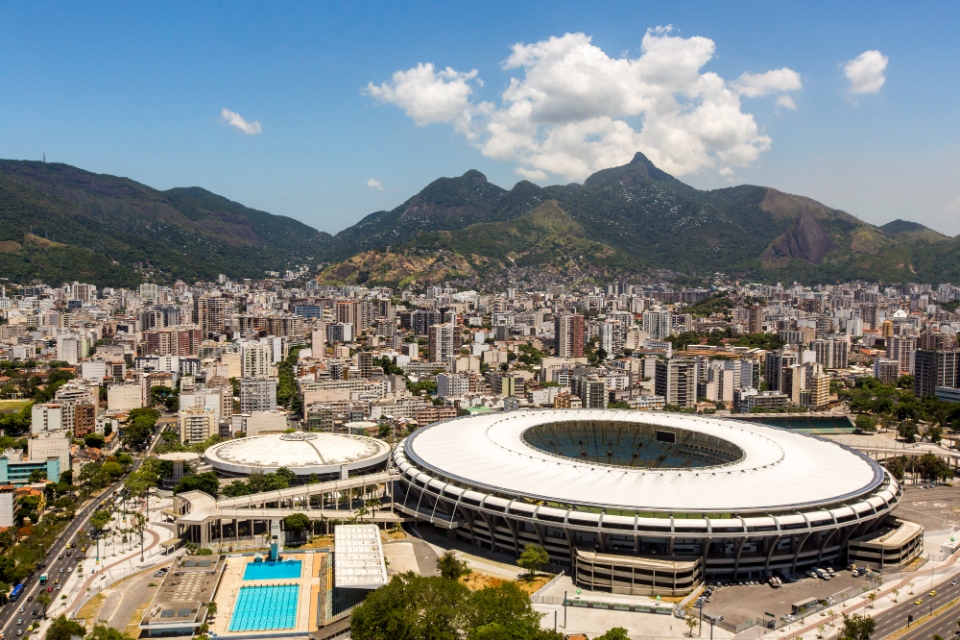
Inaugurated in 1950 when the 4th World Cup was held in Brazil, Maracana is the pride of Brazilian people in general and Rio de Janeiro in particular. This stadium has a capacity of nearly 200,000 people, but after many renovations, that number has been reduced to half. Currently, Maracana is mainly used for football matches between major football clubs in Rio de Janeiro.

Experience the cable car ride up Sugarloaf Mountain

You can take a cable car ride to go up the mountain, enjoy the panoramic view of the city located on the coast, surrounded by romantic green mountains. At the top of the mountain there are many restaurants, cafes, souvenir shops, and many benches for visitors to enjoy the views and relaxing. This is where you can watch the spectacular sunset over Guanabara Bay.

Santa Teresa Old Quarter
Peace and joy are the first impressions that visitors will feel when coming to this old quarter. At the same time, visitors will also encounter ancient churches standing firmly on high mounds, imbued with the culture of the people here.
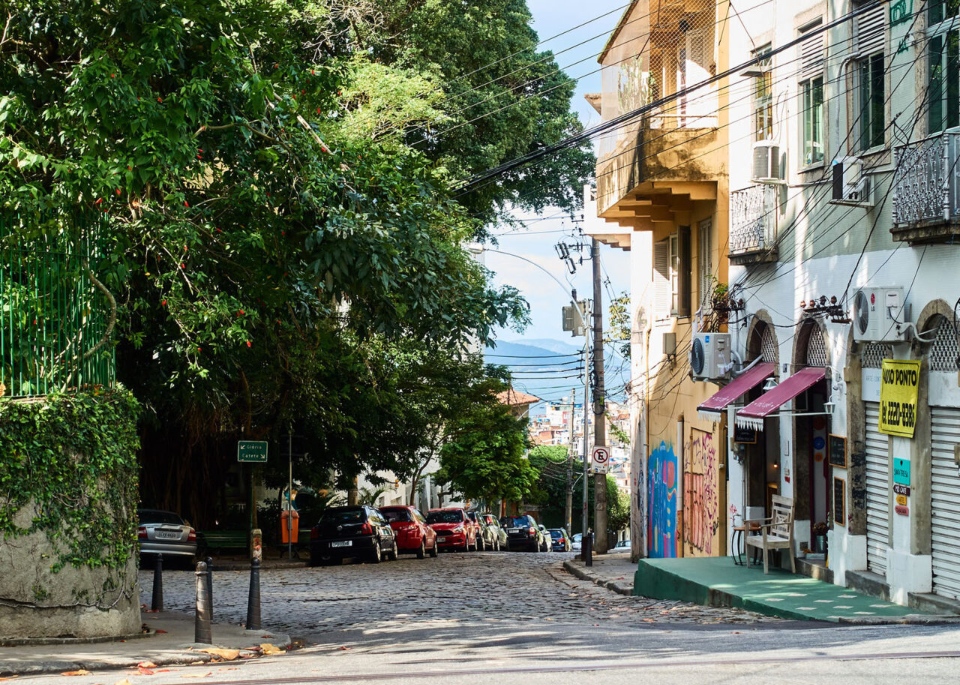
The pretty little streets paved with crushed stone or cobblestoned roads will lead visitors to the lovely old houses that are winding gently along the hillside. Most of these houses were built in the 19th century, so it always evokes a very unique nostalgia about a land rich with unique cultural features. This is also one of the place for festival lovers because the great festivals of Brazil are often held here.
Escadaria Selaron
Address: R. Manuel Carneiro – Santa Teresa, Rio de Janeiro – RJ, 20241-120, Brazil
The project started construction in 1990 with the original name of Rua Manuel Carneiro. The work is a staircase consisting of 250 steps and 125 m high. Originally, Escadaria Selarón was built by a painter and sculptor who came to live in Rio de Janeiro in 1983. He created colorful paths with ceramic tiles right in front of his house.
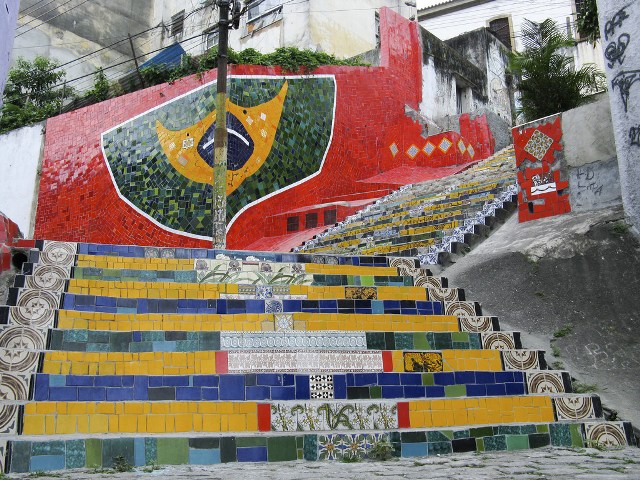
Because the neighborhood is located on a hill, most of the roads here are quite steep. Some small paths are only for walkers, so they are mainly built in the form of steps. He got money by selling his paintings and works to collect thousands of ceramic tiles from more than 60 countries around the world, mosaic for Escadaria Selarón into one giant picture.
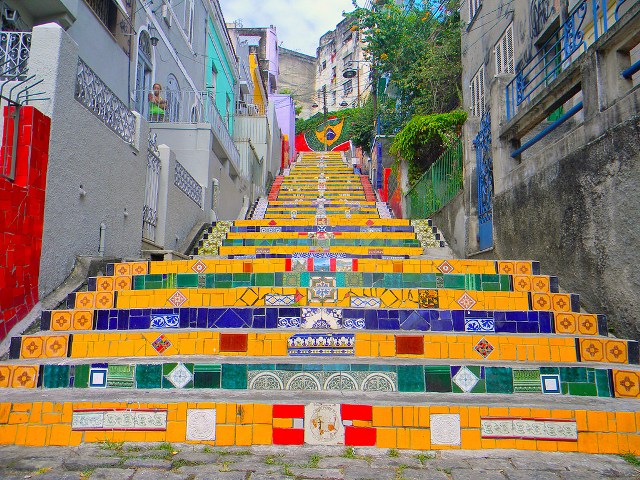
Since its completion in the early 2000s, the Escadaria Selarón steps has captured the world’s attention, appearing on the covers of famous international magazines such as National Geographic and Time. Escadaria Selarón today has become a tourist attraction, especially for photographers who are passionate about colorful, hot colors.
Rio de Janeiro Botanical Garden or Jardim Botânico
Address: R. Jardim Botânico, 1008 – Jardim Botânico, Rio de Janeiro – RJ, 22460-030, Brazil Hours: 8AM–5PM

If you are a nature lover, when coming to Rio de Janeiro, you should not miss the opportunity to come to the Jardim Botanico garden. Here, visitors will admire the wonderful natural scenery with more than 5,000 rich plant species, including those dating back to the Jurassic period. Besides, Tijuca Forest is one of the city’s largest forests in the world.
Tijuca National Park
Address: Estr. da Cascatinha, 850 – Alto da Boa Vista, Rio de Janeiro – RJ, 20531-590, Brazil Hours: 8AM–5PM
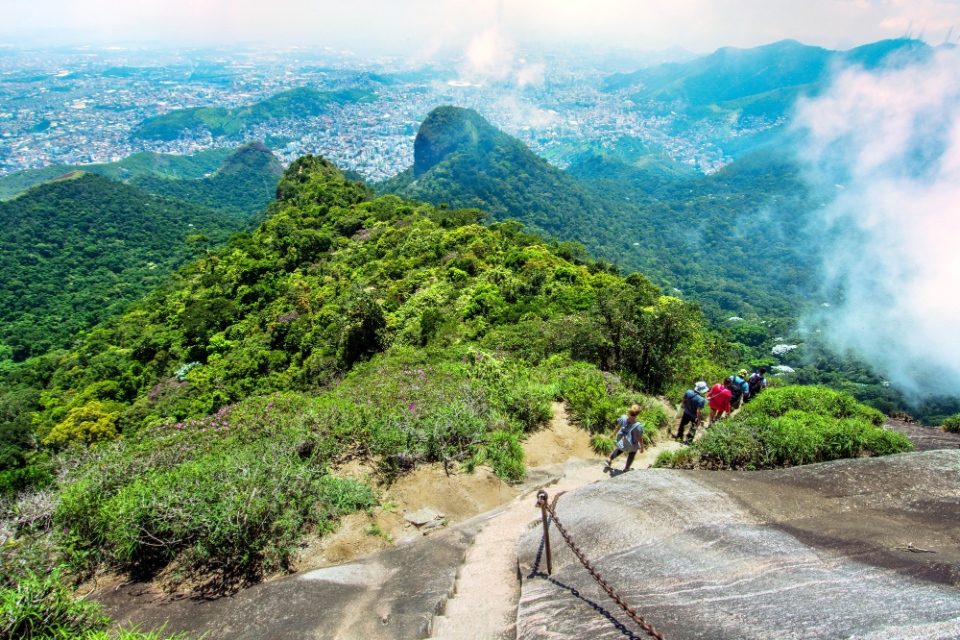
Tijuca forest is a primeval forest in the heart of the city of Rio De Janeiro and is the largest forest in the heart of the city in the world. Tijuca forest is about 120km2 wide, it will be an interesting place for those who like to walk under the jungle canopy, enjoy adventure when crossing bumpy paths, majestic waterfalls and mingle with animals…
Fort Copacabana and enjoy a cup of Brazilian coffee
Address: Praça Cel. Eugênio Franco, 1, Posto 6 – Copacabana, Rio de Janeiro – RJ, 22070-020, Brazil Hours: 10AM–7PM/Monday: Closed
Located south of Copacabana beach, the fortress is a military base built on an excess of Copacabana beach. In 1908, the Brazilian military began construction of a modern coastal defense fortress to protect Copacabana beach and the entrance to the city’s harbor.
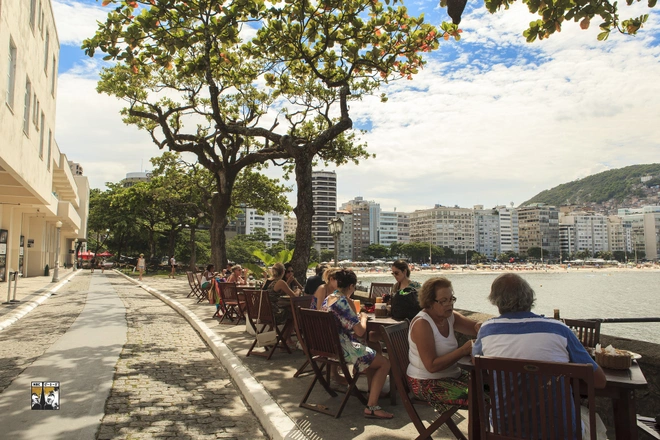
Today, visitors often come to the fortress, in addition to visiting the Brazilian military history museum, and also enjoy a romantic sunset at the beach with a cup of Brazilian coffee with a characteristic aroma. Summer 2016 Olympic Games hosted 2 long distance swimming and triathlon starting at this fortress.
Cruising around Guanabara Bay

In 1502, Portuguese explorers landed at Guanabara Bay. They mistook this for a river. It was January, so they took the name Rio (river) and Janeiro (January) to put together Rio de Janeiro for the city name. The name of Guanabara Bay is translated quite poetically: “the breast of the sea”. In addition, Rio is also nicknamed Cidade Maravilhosa – the marvelous city. Taking a cruise on the bay, visitors will immerse themselves in the modern works of Rio city such as the 13.2 km long Rio-Niterói sea bridge, Santa Cruz fortress and panoramic view of Santos Dumont airport located in the heart of the city. city.
Rio-Niterói Bridge

The longest bridge in the southern hemisphere is the Rio-Niterói, connecting Rio de Janeiro and Niteroi in Brazil, with a length of more than 13.3 km. The bridge is a typical Brazilian architecture that is ranked in the top of the most magnificent bridges in the world.
Rio de Janeiro travel blog: What to eat?
In addition to famous tourist attractions, the great food in Rio de Janeiro is also something you should not miss. The cuisine here is a unique combination of the cuisines of many famous countries such as Japan, Chile, and Spain. You can even find Vietnamese dishes such as Pho (beef noodle soup), spring rolls, braised fish…

Coming to Rio de Janeiro, you can try to enjoy dishes like Feijoada, a signature traditional Brazilian dish made from black beans stewed with meat.

Churrasco barbecue is one of the most typical dishes of this South American country. The type of meat to grill can use beef, pork, chicken marinated in spices and skewered on each skewer. You will come across grilled meat skewers stalls right on the streets, the sweet aroma seducing all visitors.
Pao de Queijo

This is a cake with a crispy golden outer shell combined with a soft inner filling made of greasy butter, condensed milk and guava powder. Pao de queijo is a very popular snack in Brazil.
Tapioca crepe
This is a popular breakfast in Brazil made from pancake shells and sandwiched inside sweet, fatty avocado and banana slices.

Some other unique and famous dishes you should try such as: Acai, Coxinhas, Brigadeiro, Pastel Frito de Frango, Feijoada, Beijinho de Coco, Creme de Papaya, Empadão, Churros, Empanada…
Rio de Janeiro blog: What to buy?
Coming to Rio de Janeiro, visitors can shop for souvenirs very typical of a South American country. Some items you should buy as a gift when traveling in Rio de Janeiro are sarongs, goiabada (guava paste) which is a preserve made simply from guava and sugar), Sugar Loaf mountain miniature souvenirs, small statues of Christ the Redeemer, “I Love Rio de Janeiro” t-shirts, a pair of authentic Havaianas Flip Flops…

Visitors can also go to the Hippie fair in Ipanema to choose from creative and unique gifts for loved ones or simply a souvenir for yourself. You can wander around the market and pick up beautiful handcrafted jewelry, clothes or bags. Be sure to look out for the weekly stalls that sell handmade boxes with wooden linings or the stalls that sell bowls and coasters made of dried beans and plastic. These will be very unique gifts!

Read more: What to buy in Brazil? — 18+ must buy, top Brazilian souvenirs & best things to buy in Brazil .
Rio travel blog: Where to stay?
Below we recommend more best budget, mid-range and upscale hotels with good ratings and reviews you can refer to.
- Riale Brisa Barra Hotel ( Agoda , Booking )
- Rio Othon Palace Hotel ( Agoda , Booking )
- Miramar Hotel by Windsor ( Agoda , Booking )
- Ibis Rio de Janeiro Santos Dumont ( Agoda , Booking )
- Orla Copacabana Hotel ( Agoda , Booking )
- Hilton Barra Rio de Janeiro ( Agoda , Booking )
- Sheraton Grand Rio Hotel & Resort ( Agoda , Booking )
- LSH By OWN ( Agoda , Booking )

Check out more top and best hotels in Rio via Agoda.com or Booking.com .
Rio de Janeiro guide: Some things to note before traveling to Rio de Janeiro
- If possible, learn some basic Portuguese words and phrases to communicate when needed because the Rio people speak English with a bit difficult to understand. In your luggage, remember to prepare a pair of slippers or spacious shoes for comfort when walking.
- The slums in Rio de Janeiro, Brazil are also one of the interesting places to visit once when coming to Rio. However, you should be guided by a local and should not bring valuables.
- Be careful with money and personal belongings when going out on the street or in crowded places, because pickpocketing in Rio de Janeiro is quite serious.
- Copacabana has a separate bike path. If walking, you should follow the right footpath, because driving in Rio de Janeiro is quite reckless.
Some best day tours, trips, activities and transfer services, tickets in, from and to Rio de Janeiro you can refer to
- Rio: Christ the Redeemer Official Ticket by Cog Train
- Rio de Janeiro: Sugarloaf Cable Car Official Ticket
- Rio: Maracanã Stadium Official Entrance Ticket
- From Rio de Janeiro: Angra dos Reis Boat Trip with Lunch
- Rio: Christ the Redeemer, Sugarloaf, & Selaron Day Tour
- Rio De Janeiro: Half-Day Rocinha Favela Walking Tour
- Rio de Janeiro: Sunset Sailing Tour
- Rio de Janeiro: Favela Santa Marta Tour with a Local Guide
- Rio de Janeiro Hang Gliding Adventure
- Rio de Janeiro: 30 or 60-Minute Highlights Helicopter Tour
- Rio de Janeiro: Carnival 2023 Samba School Parade Ticket

Happy traveling! Read more Brazil guide here .

Related articles
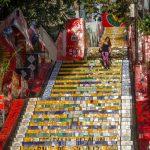
RELATED ARTICLES MORE FROM AUTHOR
Suggested tokyo travel itinerary 3 days. how to spend 3 days in tokyo on a budget.

Where to go in Hsinchu? 14 famous attractions, best places to visit in Hsinchu

21+ best places to visit Korea in autumn
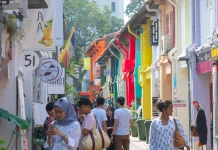
Suggested Singapore Malaysia itinerary 6 days to visit Singapore & Kuala Lumpur

Singapore Malaysia itinerary 5 days — What to do & suggested 5 days 4 nights Singapore Malaysia itinerary
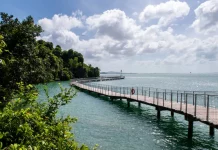
Pulau Ubin travel guide. The ultimate guide to the green island of Singapore

Pulau Ubin blog — The guide to Pulau Ubin & suggested perfect Pulau Ubin one day trip
Editor picks.

Suggested Tokyo travel itinerary 3 days. How to spend 3 days...
Popular posts.

What to buy in USA? — 17+ must buy in USA...

What to buy in Korea? — Top +23 cheap, famous &...

Must buy souvenir in Taiwan — Top 17+ most famous, cheap...
Popular category.
- Inspiration + Guide 1523
- Trip Inspiration 468
- Food + Drink 223
- Thailand 216
- Coasts + Islands 199
- South Korea 179
- Vietnam 172
- Travel Photos 144
- Work for Us
- Terms & Conditions
- Privacy Policy
- Search Please fill out this field.
- Manage Your Subscription
- Give a Gift Subscription
- Newsletters
- Sweepstakes
- Travel Destinations A-Z
Rio de Janeiro Travel Guide
:max_bytes(150000):strip_icc():format(webp)/megan-wood-6806d519c0a24609b8841ef4ac685e94.jpg)
In Rio de Janeiro, every day is a party. Rio, as it's usually called, is a place like absolutely no other in the world. The jet set and glitterati descend here year-round for the white-sand beaches, bass-forward nightlife, and five heady days of Carnival bacchanal celebrations in February or March. But you don't have to be a thong-clad party seeker to appreciate the literal highs of mountainous Rio. The breathtakingly beautiful city is home to landmark sites like the Christ the Redeemer statue and world-class art museums. Sprinkle in beach volleyball matches, samba dancing, and stunning tropical mountains meet azure sea scenery you won't find anywhere else. But there are a few things to keep in mind: Brazil no longer requires a visa for American visitors (you'll pay an airport departure tax instead); the language is Portuguese, not Spanish; and the drug-trafficked favelas are a harsh reality. This Rio de Janeiro travel guide has everything you need to get started planning an unforgettable trip. Ready, set, Rio!
Brasilia Standard Time
Best Time to Go
Rio de Janeiro is a bustling and modern beachfront city, with something for tourists to see and do on and off the sand 12 months out of the year. Weather wise, December through March (Brazil's summer months) and September through November (spring in Brazil) means temperatures in the 70s to 90s and little rain. With Carnival comes crowds in February or March, but that's half the fun. It's no surprise New Year's Eve is another epically popular time to party in Rio.
Things to Know
Currency: Brazilian Real (R$)
Language: Brazilian Portuguese
I don't speak Portuguese: Nao falo portugues.
I'm lost: Estou perdido.
I would like…: eu gostaria
Learn more helpful phrases here.
Calling Code: +55 (Brazil) + 21 (Rio)
Capital City of Brazil: Brasilia
How to Get Around
Trains: The three-line subway system, called MetroRIo, is clean, convenient, and safe. This is the best way to get around the city and avoid traffic.
Buses: Cheaper than taxis and trains, but the buses in Rio are crowded and slow.
Taxis: Yellow taxis are widely available—insist the driver turn on the meter instead of haggling over the fare.
Car service: Uber is available in Rio. You'll need internet access on your phone to use the app. From Galeao Airport, Uber departs on the second level.
Best Hotels
Hotel fasano rio de janeiro.
Address: Avenida Vieira Souto, 80 - Ipanema, Rio de Janeiro - RJ, 22420-002, Brazil Phone: 55 21 3202 4000 Website
When famous hotelier Phillipe Starck brought a luxury boutique hotel to the Ipanema waterfront, he smartly designed much of the hotel (including the infinity pool) to overlook the beach. Apart from the vistas, the property pays homage to the glamorous era of Bossa Nova in the 1950s and 60s. The rooftop bar draws beautiful people for beautiful views of Sugarloaf Mountain.
Copacabana Palace, A Belmond Hotel
Address: Av. Atlântica, 1702 - Copacabana, Rio de Janeiro - RJ, 22021-001, Brazil Phone: 55 21 2548 7070 Website
Looking for a taste of the French Riviera on Copacabana Beach? The Copacabana Palace was built in 1923 and still retains much of its original architecture and retro art deco glamour. The 239 rooms mostly overlook the beach. The three restaurants and piano bar are highlights, but the real star of the show is the private beach—complete with attendants to watch your belongings while you frolic.
Santa Teresa Hotel RJ - MGallery by Sofitel
Address: Rua Almirante Alexandrino, 660 Santa Teresa, , Rio de Janeiro - RJ, 20241-260, Brazil Phone: 55 21 3380 0200 Website
Swap the beach for the mountains at Santa Teresa Hotel RJ. Once an 18th-century coffee plantation, the building is now a chic boutique hotel with unbeatable views of the city and Bay of Rio below. It's literally above the scene, but still very much a part of it—the onsite restaurant, Tereze, is considered one of the best in Rio.
Janeiro Hotel
Address: Avenida Delfim Moreira, 696 - Leblon, Rio de Janeiro - RJ, 22441-000, Brazil Phone: 55 21 2172 1100 Website
Style and eco-consciousness go hand in hand at the Janeiro Hotel. It's located in the glamorous Leblon neighborhood and across the street from Ipanema-Leblon Beach. Each of the 51 apartment-style suites has sea and Cagarras Islands views...some of the showers do too.
Best Restaurants
Address: Av. Afranio de Melo Franco, 290-406 A Phone: 55 21 3875 1830 Website
When it's too hot for a full meal, head to Mil Frutas (a thousand fruits) for a frozen treat. This sorbet shop makes close to 100 handmade flavors using fresh ingredients, including native fruits like araca, acai, and umbu.
Zaza Bistro Tropical
Address: Joana Angelica 40 Phone: 55 21 2247 9101 Website
Tropical flavors with Asian accents and organic ingredients are only part of what draws customers to Zaza. The restaurant is filled with art and upstairs you can kick your shoes off for a laidback dinner on throw pillows. Outdoor dining available.
Address: Av. Gen. San Martin, 889 Phone: 55 21 2540 8767 Website
Oro has been a darling on the Rio restaurant scene since it opened in 2010, winning two Michelin stars in 2018. Celebrity Chef Felipe Bronze combines a grill and creativity to create rustic dishes cooked on live fire. Reservations recommended.
Address: R. Barao da Torre, 538 Phone: 55 21 3202 2884 Website
Bazzar serves wild fish, sustainable seafood, and organic vegetables in modern presentations by chef Lira Muller. Global trends and vegetarian dishes are well represented. Psst, Bazzar is open for lunch and the front area is laid-back enough to visit looking salty after the beach.
Things to Do
Christ the redeemer.
Address: Parque Nacional da Tijuca - Alto da Boa Vista
The Christ the Redeemer statue is the undisputed symbol of Rio. The art deco-statue was built by a French sculptor in 1931, and the statue's arms stretch out a massive 92 feet wide. You can see the statue from multiple vantage points in Rio, but it's worth the cable ride up the mountain to see it up close.
Ipanema Beach
Address: Posto 8 through Posto 12 on the beach
A close second only to Copacabana Beach in popularity, Ipanema Beach has been a locals' and tourist favorite since at least the '60s. The two-mile stretch of sand features mountain views and cobalt water. The people watching isn't bad either.
Bar hop through Lapa
Address: Avenida Mem de Sa
A visit to the Lapa neighborhood is lovely in the day, but visit after dark for an unforgettable nightlife scene. The neighborhood overflows with samba music and revelers. Rio Scenarium is three stories of music and dancing. Also check out Lapa 40 Graus and Clube Dos Democraticos, where locals have been cutting a rug since 1867.
Ilha Fiscal
Address: Avenida Alfredo Agache
Check out the unexpected: a green neo-gothic 19th-century palace, which sits on its own miniature island in the city. Ilha Fiscal is a stylish reminder of when Rio was the capital of the Brazilian Empire.
Best Shopping
Tropicalia discos.
Address: Praca Olavo Bilac, 28 Phone: 55 21 2224 9215 Website
Located on the second floor of a nondescript building, Tropicalia Discos is a vinyl goldmine. This is the go-to for Brazilian music, with records from Bossa nova to samba to jazz.
Address: Av. Ataulfo de Paiva, 270 Phone: 55 21 2274 7808 Website
Rio's laidback and colorful street style is inspired by the beach and tropical climate. Dress the part with floral bikinis and flowing dresses from Osklen.
Granado Pharmacies
Address: Av. Barao de Tefe, 3 Phone: 55 21 3231 6700 Website
Shopping at local pharmacies is the beauty secret to sourcing local soaps, perfume, and toiletries. There are multiple Granado Pharmacies in Rio. Stop in and nose out your favorite scents. Pro tip: the pretty packaging makes for perfect gifts.
Address: Paschoal Carlos Magno 100 Phone: 55 21 99640 1710 Website
Support the Amazonian community by shopping for handmade goods at Tucum. This small shop exclusively carries woven baskets, jewelry, pottery, and wall hangings made with Amazonian seeds and fibers.
Neighborhoods to Know
Rio is a sprawling city, but each neighborhood has a distinct vibe. Think of Rio more like a collection of small beach and mountain towns, and it's less overwhelming. Copacabana and Ipanema are obvious beach neighborhoods, but a tram ride up to Santa Teresa is worth it for the boho vibe, ocean views, and samba clubs. Leblon is the neighborhood for pure glitz and glamour and the small footprint means you can check out most of the high end boutiques and chi-chi wine bars in one visit.
Rio is known for its beaches, and thankfully the weather usually cooperates enough to enjoy them year round. January through March sees temperatures in the low 90s—it's too hot to do much of anything besides swim. July, August, and September are the coolest months with lows in the mid 60s, but also the driest. Hurricanes are a rarity in Rio de Janeiro.
Apps to Download
WhatsApp : Free messaging, video calls, making dinner reservations Android | iOs
ChefsClub : Find restaurants, bars, and make reservations Android (not on Android) | iOs
Bravolol Limited : Look up words and sentences in Portuguese, translate Android | iOs
Related Articles

LAISSEZ-VOUS GUIDER POUR DÉCOUVRIR LA VILLE AUTREMENT !

Bonjour Rio est recommandé par :

Johanna, une française folle amoureuse du Brésil depuis toujours, a tout plaqué en 2017 pour suivre son rêve et s'installer à Rio de Janeiro. Depuis, elle parcours la "Cidade Maravilhosa" , la ville merveilleuse, de long en large pour en découvrir tous les secrets et endroits insolites. Elle a toujours aimé tester et dénicher de nouveaux endroits pour trouver LE spot parfait.
De cette passion, elle a souhaité proposer un concept novateur et décalé pour aller au delà des visites guidées classiques et parfois ennuyeuses dans lesquelles elle ne s'identifiait pas. Constatant également que bien souvent, les voyages organisés sont programmés à la minute près et laisse peu de place à la personnalisation, c'est donc tout naturellement qu'elle a imaginé et créé Bonjour Rio , afin de proposer des visites guidées et expériences uniques, basées sur l'envie de vous faire découvrir cette ville comme elle l'aime, comme les Cariocas l'aiment !
Rio de Janeiro c'est le Christ Rédempteur, les plages de Copacabana et Ipanema, le Pain de Sucre, la samba et les caipirinhas, ... mais pas seulement ! Cette ville possède une énergie incroyable et recèle de trésors méconnus comme le parque Lage, les marchés colorés de rues, les petits bars et restaurants atypiques, des ateliers d'artistes locaux, ...
Bonjour Rio c'est aujourd'hui une équipe de 3 femme s passionnées et passionnantes, Johanna, Charlotte et Alysse , qui ont à coeur de vous proposer des expériences et visites guidées originales et en français. Ici, "authenticité" et "laisser-aller" sont les maîtres-mots afin de vous faire découvrir cette ville différemment et apprécier le "Rio des Cariocas" !
Laissez-vous guider, vous n'aurez qu'a profiter !
et visites guidées pour découvrir Rio de Janeiro autrement !
Les experiences.

Au sommet de Rio
Enfilez vos baskets et montez au sommet des Dois Irmãos, montagne iconique de Rio, pour une vue à couper le souffle !

Tickets pour le Carnaval
Prenez vos places pour assister, en première loge, à l'incroyable défilé du Carnaval de Rio !

Samba et Caipirinha
Découvrez les origines de la Samba et son rythme entrainant lors d'une soirée typiquement brésilienne.

Planez au dessus de Rio
En deltaplane ou en parapente, décollez depuis la forêt tropicale, survolez Rio de et atterrissez sur la plage !

La beauté de Santa Teresa
Des rues pavées de Santa Teresa aux très colorés escaliers Selaron, percez les secrets de ce quartier historique.

Défilez au Carnaval de Rio
Vivez une expérience unique et inoubliable en défilant au Sambodrome, pour le Carnaval de Rio !

Rio vue du ciel
Décollage immédiat pour un vol au dessus de Rio unique en son genre. Admirez la ville sous un autre angle !

Escaladez le Pain de Sucre
Pourquoi se contenter de monter au Pain de Sucre en téléphérique
quand on peut l'escalader ?!

Favela Expérience
Visitez la favela de Vidigal et découvrez l'autre réalité de Rio de Janeiro, bien loin des clichés médiatiques.

Les coulisses du Carnaval
Costumes, chars, musiques, ... découvrez l'envers du décors du plus grand carnaval du monde !

Le foot à la brésilienne
Assistez à un match de foot au cœur du fameux stade Maracana et vibrez avec les supporters brésiliens !

Street food Brésilienne
Jus de caju pressé minute, pasteis à la viande, tapioca à la banane ... Découvrez les saveurs Carioca !
AVIS CLIENTS

Marine et Vanessa, Marseille
Bonjour Rio est la rencontre d’une vie !
Chaque expérience (helicoptère, visite de Santa Teresa, Samba et Caipi, match au Maracana, rando + favéla expérience …) a été des souvenirs incroyables. Johanna est passionnée, humble, bienveillante. Au delà de tout, nous n’avons pas partagé des moments avec une « guide » mais avec "une copine" brésilienne dans l’âme. Merci de nous avoir permis de faire des rencontres exceptionnelles et merci pour toutes ses émotions. A travers les yeux de Johanna, on ne peut que tomber amoureux de Rio et la première pensée au retour : je veux revenir Je conseille vivement de passer par Bonjour.Rio partage, astuces, conseils et découvertes atypiques.

Margot, Paris
Grâce à Bonjour Rio, j'ai réalisé un rêve !!! J'ai pu défiler avec une école de Samba pour carnaval de Rio et le jour de mon anniversaire ! Que demander de plus ? Merci infiniment pour ces moments magique et inoubliables, et trop je suis contente : mon costume rentre en France avec moi!! Je vous recommande vivement de passer par Bonjour Rio, Johanna est douce et vraiment à l'écoute de nos attentes. A l'année prochaine !

Michel, Catherine et Pauline, Aix en Provence
Nous avons été conquis par le dynamisme, la gentillesse et la bonne humeur de Johanna mis au service d’une excellente connaissance des lieux, des mœurs et de la culture Brésilienne. Très vite nous avons eu en notre compagnie non seulement une guide compétente et à notre écoute mais aussi une amie sur qui nous pouvions compter en toutes situations et qui nous a fait découvrir la ville sous un aspect différent et plus intimiste que quelque guide que ce soit. A Rio nous avons fait deux belles rencontres ; la ville et Johanna !

Tous ce que vous souhaitez savoir pour préparer votre voyage à Rio de Janeiro

Une réservation, une question ou simplement envie de dire Bonjour ?
Ecrivez-nous via e-mail, via Whatsapp ou
en remplissant directement le formulaire ci-dessous.
Nous nous ferons un plaisir de vous ré pondre.
bonjour@bonjour rio.com
Tel: +55 21 995 044 504
Message envoyé !
The Unknown Enthusiast
22 Rio de Janeiro Travel Tips: Things to Know Before Going to Rio in 2024
Heading to Rio soon? You’re in luck! I’ve got the best travel tips for Rio de Janeiro to prepare you for a great vacation in Brazil.

Our six days in Rio de Janeiro were really like a dream – so many interesting things to see, do, and eat. I was really blown away by just how much I loved the city! For me, I think it was a combination of loving a bustling city, but also loving nature and beautiful viewpoints – and Rio delivers both in such a unique way!
However, being a country in South America, there are a lot of differences between traveling in Rio compared to traveling in the United States.
In this Rio de Janeiro travel guide, I want to talk about the best travel tips and important things to know before going to Rio de Janeiro, based on our experience there, and the advice given to me by my brother, who lived there for several years.
This post may contain affiliate links or refer a friend links. When you buy through these links, I may earn a bonus at no additional cost to you. Thank you for your support!
Rio de Janeiro Travel Tips
You’ll be on your way in no time! Let’s get into my 22 most important travel tips for a Rio de Janeiro vacation:
1. Purchase an E-Sim Card Before You Go
I’ve recently found a new way to get inexpensive, high speed data while traveling (something I love to have but has been annoying, expensive, or ineffective to procure).
Instead of purchasing a local SIM card (or renting a mobile hotspot) when arriving in a country, I’m now using an e-sim card from Airalo. I’ve used a lot of different methods in the past to get data when traveling internationally, and let me tell you, buying an e-sim card is EASILY the most affordable, fast, and convenient option.
E-sims are a relatively new thing, so before you purchase, you’ll need to contact your cell phone provider and have them unlock your phone for e-sim use.
Before you leave on your trip, purchase the amount of data that you need from the Airalo website . Then download the app, and when you arrive, toggle on the e-sim card, and that’s it! You can check how much data you’ve used in the app, and top up with more if necessary.
One of the most important things to know before going to Rio de Janeiro are some safety tips for the city. Safety was a big concern for us as we prepared to visit Rio. I’d often heard Rio described as an unsafe city, and I had talked extensively to my brother, who lived in Rio for a couple of years, about safety concerns.
Honestly, I had a decent bit of anxiety the 2 weeks before we left about our vacation. I was extremely worried about our phones getting snatched out of our hands, getting pickpocketed, getting my purse slashed, getting mugged, and just generally running into a lot of unsafe or unsavory situations.
I will say that we exercised much more caution than we normally do when traveling in Rio, and were a lot more aware than usual about our surroundings (of course, we’re always taking precautions and being aware, but it was definitely heightened in Rio), but we almost always felt perfectly fine and safe as we toured the city .
Still, learning about what precautions to take is an important thing to know before going to Rio de Janeiro and we’ll cover several safety topics in this Rio de Janeiro travel guide.
These are the safety travel tips for Rio I would recommend:
2. Avoid the Favelas…Unless You’re in a Tour
Favelas are crowded, very poor neighborhoods, usually built up into the hillsides of Rio. Favelas are all controlled by gangs or the mafia, where they sell drugs and machine guns are carried openly.
While doing a guided tour of a favela is totally safe (and was a really interesting and positive experience in Rio, I highly recommend it – read our full review of it here ), and the favelas in general can be relatively safe during the daylight hours, I would definitely still avoid them if you aren’t with a tour.
Gang invasions, shootouts, or police raids could take place during any time, day or night, and you’d have no idea it’s coming. The tourist favelas avoid this during the day because of the tourism, but any other favela is free game any time any day. So, outside of a tour, just play it safe and avoid the favelas!
My recommendation: Tour of the Dona Marta Favela (I would highly, highly recommend doing a guided favela tour during your time in Rio – it was safe and so interesting)
3 . Be Off the Streets After Dark

In general, don’t be walking on the streets after dark (which is about 6pm year round). As an international tourist, a good rule of thumb is if you need to go somewhere at dark, take an uber or taxi, or the metro if you’re walking less than a block to/from the stations to your destination.
Now, if you are in an area that is well lit and well-trafficked with people, then that is probably okay to be out and walking around. For example, one night after dinner we wanted to walk several blocks to a grocery store around 9pm.
At first, I was hesitant to be out walking, but then saw that our route was along a road with lots of cars, lots of light, and many other pedestrians out and about. That was a fine situation.
Conversely, another night we thought we’d do the same thing because it was only about a 10 minute walk to the restaurant we were going to. This time though, there was very little traffic and very few pedestrians, although it was well-lit and not that late (only around 7pm).
I felt like this situation was less safe and in retrospect would’ve gotten an uber (although we did walk right past the police precinct, so that did give some peace of mind).
4. Be Aware of Pickpockets and Phone Snatchers
Be very aware of pickpockets (or thieves snatching your phone out of your hand), particularly in areas like Copacabana, markets, or other touristy spots. If you are in a taxi or uber and your window is down, be aware that passing pedestrians, bikers, or men doing sales in the street when cars are stopped will sometimes grab phones right out of your hands in the car.
In general, just be careful with your phones. Ideally, don’t pull them out on the street. However, because we were always wanting to take pictures, we had our phones out a lot, and here’s what we did to try to be safe:
If we were walking around, I often kept two hands on my phone and kept it in front of my body. I also put a hand wrist strap lanyard on my phone case that went around my wrist, so it was somewhat attached to my body.
We tried to pay attention to our surroundings and not have the phones out conspicuously when there were people right by us.
As we were touring around Centro in particular, we saw a lot of police cars/officers out around the area, just parked and monitoring the area. This is for safety reasons, as a deterrent to crime, and we felt more secure walking around with that security present.
5 . Be Careful of Hiking Trails and Paths
Gangs will sometimes take over nature trails, and for a while the path from Parque Lage to the Christ the Redeemer statue had a whole bunch of muggings, so it was definitely a place to avoid.
When we visited Parque Lage, we noticed that there was a police officer at the trailhead, so that trail may be safer now, but I would still exercise a lot of caution if you plan to do any trails, never be out after dark, and ideally be in a group.
6. General Awareness
When traveling to Rio de Janeiro, it’s a good idea to generally be aware of your surroundings, keep a close eye (and hand) on your belongings, and just pay attention to what and who is around you.
Now, with all that said, I don’t think you need to be scared of Rio (the way I kind of was, haha). For example, I had read a couple of accounts where people said they didn’t go more than 10 minutes without running into a group of people or a scenario where they felt uncomfortable.
That was not our experience. In fact, we generally felt very safe as we walked around and toured Rio, particularly because we were following our safety guidelines. And the few times I did feel a little uncomfortable, we were able to quickly get somewhere I did feel safer.
I think that one of the good things to know before going to Rio is that, despite its reputation, with a few precautions you can have a safe and enjoyable trip.
Be situationally aware, have a plan of how you will get around and where you will be, and follow the above suggestions to maximize your chances of a great, safe trip.
7. Don’t Forget Travel Insurance
Securing some travel insurance is an important part of prepping for any international trip – you never know when something might happen, and your regular insurance generally won’t cover you overseas. Costs for a medical emergency on vacation can add up extremely fast, so it’s just better to be safe than sorry.
I felt a lot of peace of mind booking some travel insurance for Rio – I knew that even if something happened, we would still be covered.
I like booking insurance at Insure My Trip , as they offer a variety of plans with different coverages to choose from, so you can find the right option for you. Plus, they have great customer support if you need help before, during, or after your trip.
>> Check rates and get a no-hassle quote at Insure My Trip here!
8. Toilet Paper
One of the very important things to know before going to Rio de Janeiro is that the sewage system in Brazil (like many countries in south and central America) is not set up to handle toilet paper.
Instead of flushing it, you just stick it in the bathroom trash can.
9. Electricity
Brazil uses two types of electrical plugs: types C and N. Plug type has two round pins, and is also commonly used in a lot of Europe. Plug type N has two round pins plus a grounding pin. If you’re traveling to Rio de Janeiro from the US, you will need an adaptor to charge your electronics.
👉 My recommendation : I always travel with and recommend this type C plug adaptor set – it’s an inexpensive price for a 3-pack.
Brazil operates on a 127/220V supply voltage and 60Hz. We did not need to use any electrical converters for our electronics in Brazil (just the adaptors), as all our electronics are dual voltage rated. Most electronics these days are dual-rated, but if yours are not and you’re traveling from the US, you’ll also need a converter.
10. The Architectural Style of the City
Architecturally, Rio de Janeiro has a lot of variety. Centro is the historic center of the city, and you’ll see a lot of 19th century buildings with pretty design features.
Rio was the capital of Brazil for a few centuries and was the hub for the Portuguese crown before Brazil gained its independence from Portugal, So a lot of the architectural style comes from the European influence from Portugal during that time.
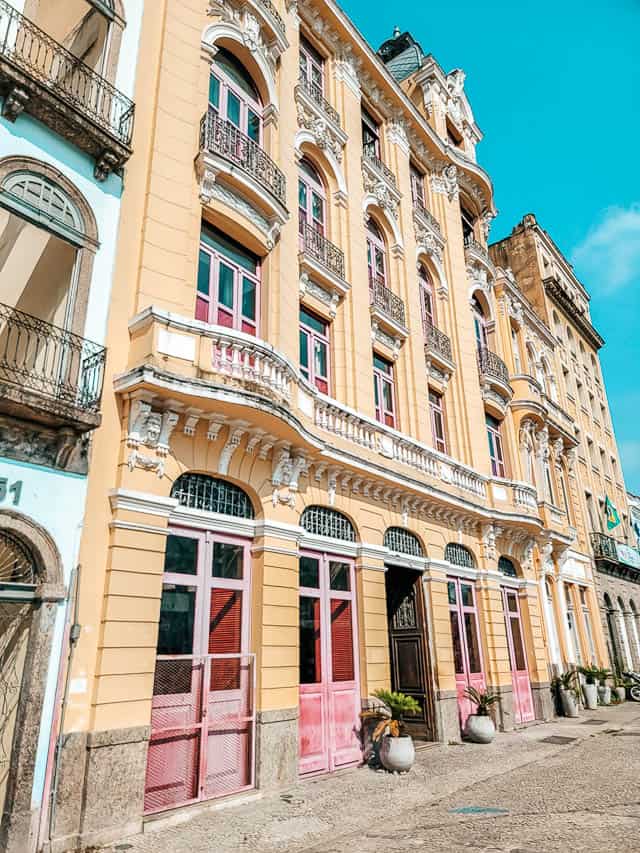
The Theatro Municipal was based off of the theater in Paris, for example. But there are also modern, futuristic designs as well, in the Museum of Tomorrow and the Metropolitan Cathedral.

Throughout Rio you’ll find colorful painted buildings.
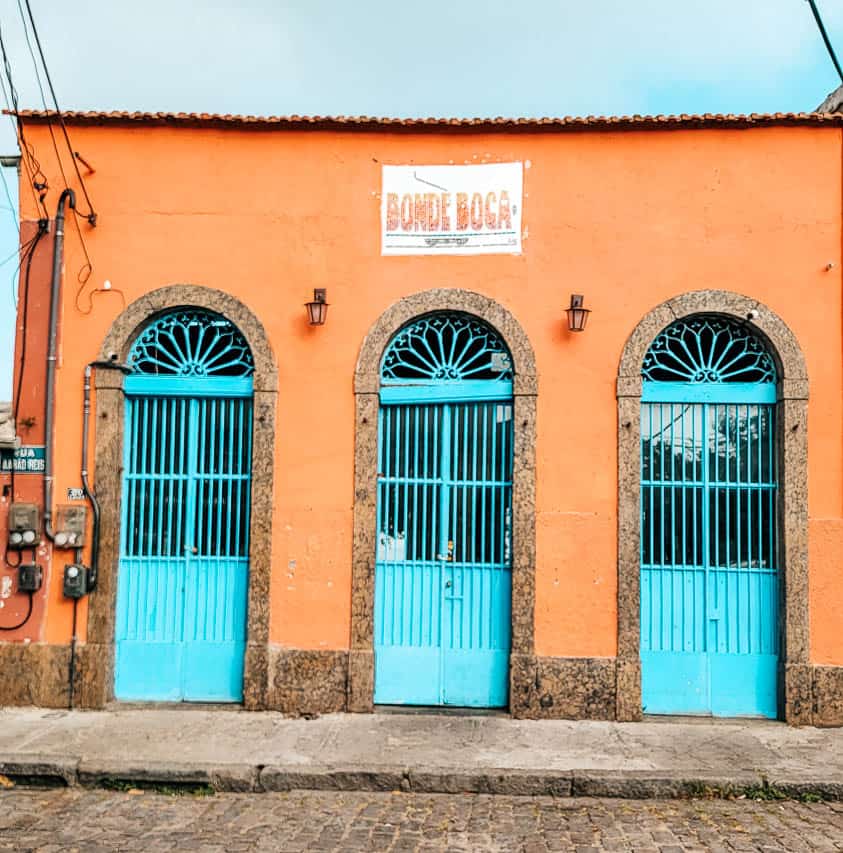
You’ll also find plenty of stark buildings or non-descript high rises.
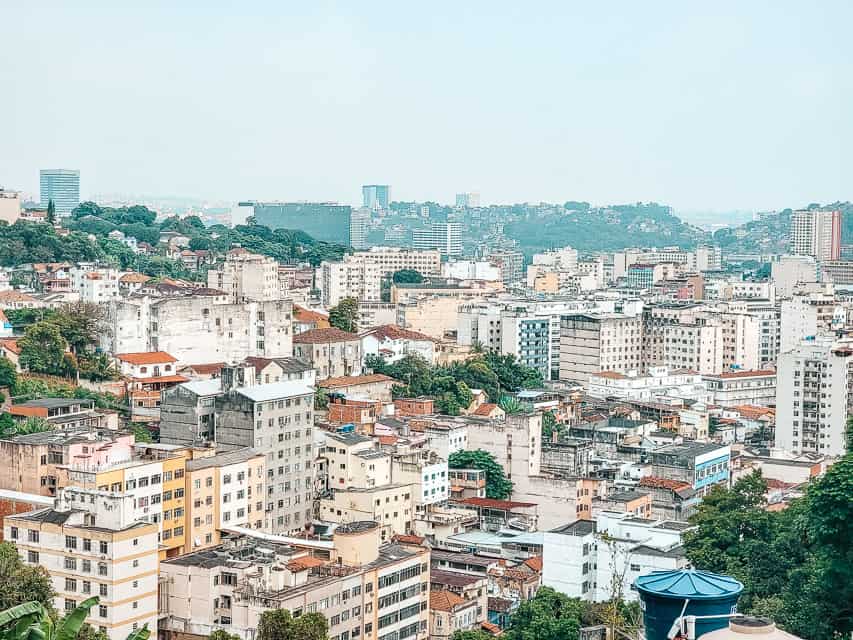
There are areas with a lot of graffiti, and some buildings have barbed wire around the exterior walls.

The Santa Teresa neighborhood is unique in Rio, with a very Bohemian vibe, tons of street art and the trolley that winds its way to the top of the hill overlooking the city.
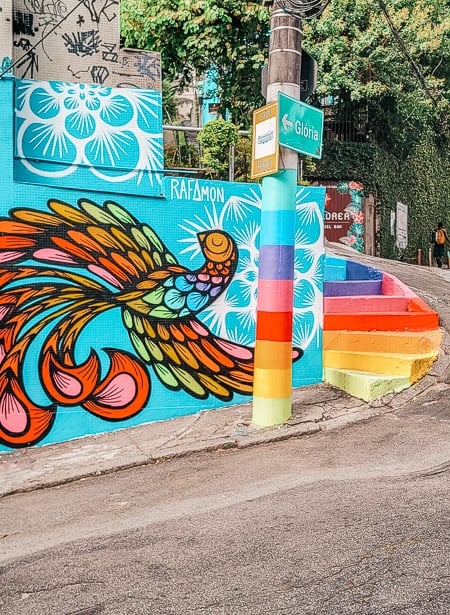
The favelas have their own style as well, with small, squat, painted houses stacked closely together as they climb up a hill.

And be sure to look down, too. There are frequent cobblestone streets and tiled sidewalks to enjoy.

You really get a range of so many styles in Rio! One of my favorite travel tips is to pay attention to all the different types of architecture you’ll see in Rio!
11. The Size and Geography of the City
One of the things to know before you go to Rio de Janeiro is that it is a very big city (over 450 square miles), and it feels particularly big due to its geography. Rio is right on the coast, but the coastline isn’t straight; you have curves and jutoffs and sudden turns.
Additionally, there are a TON of hills and mountains in the city, and the city just builds around (and sometimes up!) them.

So, you do have some navigating around hills to get places, or driving up the mountain to visit certain spots. The twists and turns (and density of the city) can make for slower transit at times.
12. Go to a Futbol Game… with a local!
Brazilians LOVE their futbol (soccer) and Rio de Janeiro has one of the biggest and most famous stadiums and futbol rivalries in the world. Going to a game at the Maracana stadium was high on our Rio bucket list, and I’m so glad we were able to do it.

My biggest travel tip for going to a futbol game in Rio is to go with a local! However, I will say, we got kind of lucky for getting to go. Despite our many attempts, we could not find a game schedule online, or information about where and how to get tickets.
We ended up just stumbling on a situation in Rio where a new, local friend we had met offered to let us come to the game with him, and he would help arrange the logistics.
This ended up being one of the craziest and most exciting travel experiences we’ve ever had. We joined up with all the friends of this Brazilian and the whole group went into the hardcore fan section that sits behind the goals.
People were packed in tight, standing up singing and cheering literally non-stop, drums beating, flags waving. It was a whoooole vibe, and we loved it.
Basically, I would highly recommend you go with a local, who will take you to the pre-party outside the stadium, and help you have the best experience during the game. Good news is this is an “excursion” you can actually arrange ahead of time! ⚽ Check prices and availability for this futbol match experience here!
13. Brazilian Coinage
Brazil’s currency is the Real, which is pronounced “hay-ahl”. The plural of real (reais) is pronounced “hay-ize.” The emphasis is on the last syllable (the “ahl” or “ize” part).
At the time of writing, one US dollar is worth about 5 reais. Most places around the city take card, but I would still plan to have cash on hand for things like bus fares, street food, or taxis.
14. Withdrawing Money
Be careful at ATMs on the street and exercise caution if there are other people around.
I would recommend withdrawing some money at the airport, but find the ATMs, not the exchange centers. We did try the exchange centers by baggage claim, but one only took cash (we only had our debit cards), and the exchange rate from the other one was basically highway robbery.
Quick Travel Tip : At the airport exit doors where you can get a taxi into Rio, there are some escalators that will take you up a level, and at the top there are some ATMs. These machines will give you a much better exchange rate, and you can use your debit card instead of cash. You can ask any employee or taxi driver where the ATMs are.
General Travel Tip: Whenever traveling in a foreign country, always have cashiers run your credit card in the local currency, not dollars (or whatever your home currency may be).
Sometimes you are given the option to choose between the two currencies on the screen if you are inserting the card yourself. You will get a better exchange rate by having your bank convert it, not the store.
Wondering what it costs to visit Rio? Check out our detailed Rio de Janeiro trip costs post here !
15. Best Areas to Stay in Rio de Janeiro
Figuring out the best area to stay is an important part of planning a trip to Rio de Janeiro, since, as we mentioned earlier, the city is very spread out, and some areas of the city are decidely more safe than others.
There are a few good areas that I would recommend to stay in Rio, based on where we stayed, what we experienced there, and other extensive research.
➡️ Santa Teresa
This was the area we ultimately ended up staying, and I was extremely happy with this choice. Santa Teresa is a quiet, artsy neighborhood that extends up a hill overlooking the city. There was a ton of street art and brightly painted houses in Santa Teresa, and the area felt very residential, and safe during the daytime hours.
The traffic was never bad in this neighborhood, and it was a quick and easy (and cheap) ride down into Centro, where a lot of sites are.
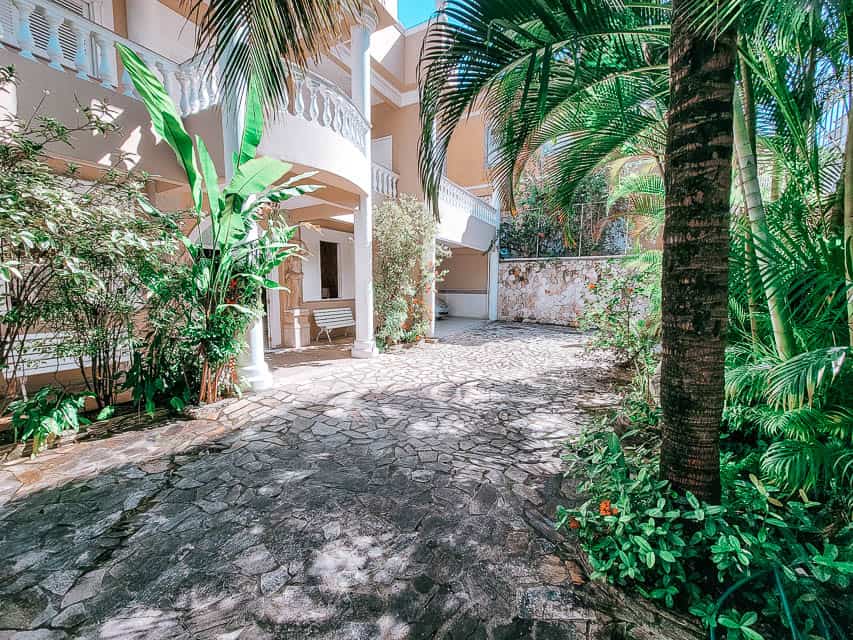
Recommended Hotel: Villa Franca I can highly recommend Villa Franca in Santa Teresa. It had a secure entrance, a beautiful courtyard, and a very relaxing lobby entrance that really felt more like the living area of a villa than a hotel reception area. The rooms were large and decorated nicely, and, very importantly, the wifi and air conditioning were strong, and the rooms had a good size mini-fridge. Check current rates for Villa Franca here!
➡️ Centro
Centro is a great area to stay in. It is more the “business” district of Rio, but it also has a lot of buildings that are beautiful, historic, and/or colorful.
There are a TON of things to see and do in Centro, and so staying in this area will be very convenient, as you’ll be able to walk to a lot of spots. It is a safe area, especially during the day. I would be careful and exercise caution at night, as there are some areas with more homeless people.
Lapa is the neighborhood right next to Centro, although we found the Lapa area to be just a little bit more dilapidated, and is known for having more crime. So while you can and should visit the sites in Lapa, just exercise a little more caution here.
Recommended Hotels: Windor Asturias Hotel This is a very comfortable hotel in the Centro district, not far from the Lapa attractions. It is within walking distance of many sites in the area! In addition, the hotel has a rooftop bar and pool, with beautiful views out over the bay. You’ll enjoy an extensive breakfast buffet every day, and of course, comfortable rooms and a helpful staff. Check current rates for the Windsor Asturias Hotel here!
➡️ Copacabana and Ipanema
Copacabana and Ipanema are the best areas to stay in Rio de Janeiro if you want to spend more time at the beach. Copacabana is a little more centrally located, while Ipanema is generally considered a nicer beach.
However, we found the beach at Copacabana to be really nice! I had heard that it was a pretty crappy beach, but I think it got cleaned up quite a bit before the Olympics in 2016. The water was nice and the sand, while there was some trash here and there, did not feel particularly dirty or gross. I would hang out at Copacabana again, no problem.
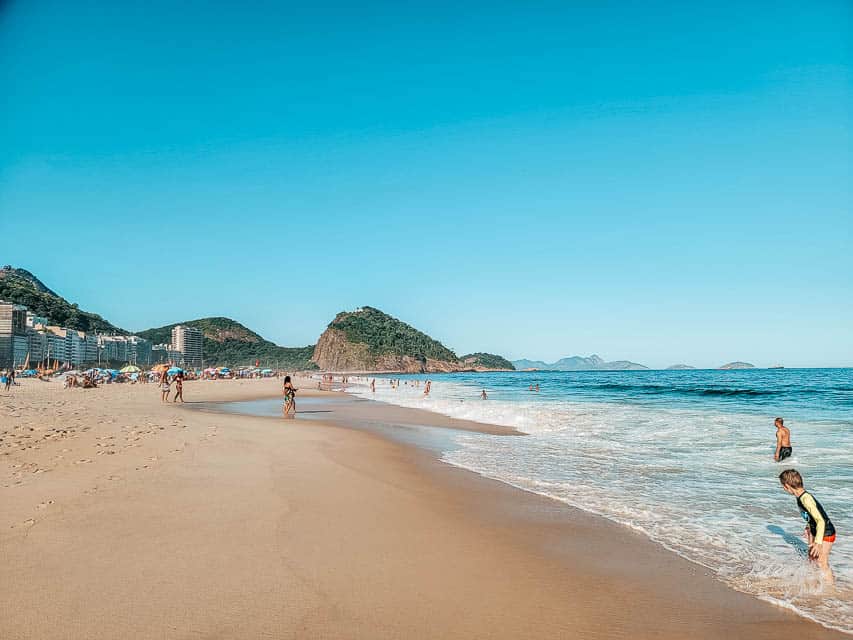
Ipanema is considered to be a more expensive area in the city, and also generally considered to be a little nicer than Copacabana.
Note that we did find the traffic to be heavier in this area (but as noted above, it is on a metro line, which is a plus).
Recommended Hotel in Copacabana: Velinn Reserva Copacabana The Velinn Reserva Copacabana is in an awesome location if you are wanting plenty of beach time, as it is just a couple blocks from both the Copacabana and Ipanema beaches. The hotel is clean and the staff is friendly, and the rooftop breakfast is a big highlight. Check current rates for the Velinn Reserva here!
➡️ Botafogo
Botafogo is a lively area situated between Copacabana and Centro. It’s a good, central location and generally considered a safe area to stay and visit in Rio. This neighborhood sits right on Guanabara Bay and at the foot of the super cool Sugar Loaf mountain.
We came to this area a few times for dinner and really liked it!
Recommended Hotel in Botafogo: O Veleiro Bed and Breakfast I love the cozy interiors in this B&B and the absolutely gorgeous garden courtyard area (with pool!). It’s a perfect retreat from the hustle and bustle of the city. The bedroom design feels like you’re visiting an old friend in Rio instead of staying in a hotel, and the views over the hills are excellent. Make sure you book a standard room (not economy) for the AC. Check current rates for O Veleiro here!
➡️Leblon
Leblon is the best area to stay in Rio de Janeiro if you want to be close to the beach, but in a nicer and quieter area than either Copacabana and Ipanema. The downside – it is a pricier area and farther away from many attractions. It can be a beautiful spot, though!
Recommended Hotel in Leblon: Sheraton Grand Rio Resort and Hotel If you’re staying in Leblon, it’s probably because you want that upscale beach experience, and the Sheraton Grand Rio definitely delivers. With an absolutely gorgeous pool and lush grounds directly overlooking Leblon Beach, you’ll enjoy luxury beach and pool days, with several on-site restaurants and spacious rooms with balconies overlooking the beach. Check current rates for the Sheraton Grand Rio here!
16. The Language
Portuguese is the official language of Brazil, and unlike many other tourist destinations in Europe, not many Brazilians speak English, even in tourist-facing locations. While there were some people who spoke English, most people did not.
We did learn a few Portuguese words and got along fine, but I do wish we had learned a few more common words and phrases before traveling in Rio de Janeiro (please, thank you, hello, goodbye, where are the bathrooms, I don’t speak Portuguese, the numbers 1-10, etc are some good ones).
Knowing some basic phrases before you go is a really useful step for visiting Rio de Janeiro.
I would also try to look up and practice pronunciation of any words you’ll learn, because pronunciation in Portuguese is not always how you think it’d be (we were really surprised with some of the pronunciation rules!)
A big travel tip for Rio : Plan to use Google Translate a lot!
Despite a big language barrier, we found that people were still very nice and willing to work with our pointing/miming/google translating. Most of the Brazilians we interacted with were extremely friendly!
17. Weather in Rio de Janeiro
Weather in Rio is either hot or VERY HOT. As Rio de Janeiro is in the southern hemisphere, seasons are opposite the US, with December being summer and June being winter.
Thus, hottest months in Rio are December, January, and February, with temperatures almost always above 100 degrees Fahrenheit (plus humidity!) Coldest months are June, July, and August, with average highs in the upper 70’s.
The rainy season is from December to March and the dry season from May to October, with April and November being transitional months. During the rainy season, you can either get rain showers in the afternoon (the kind of rain very common in tropical areas) or you can get all day downpours.
When we visited in the middle of March, the forecast showed high chances of rain and thunderstorms every day we would be there, but we ended up barely even having any clouds in the sky and no rain at all.
The average relative humidity stays very constant throughout the year, at about 78 to 80%. This is EXTREMELY humid!

18 . What to Wear in Rio de Janeiro
One of the big travel tips for visiting Rio de Janeiro is to plan on wearing wickable, breathable fabrics as you explore the city.
In hot weather, I prefer wearing breezy dresses (less things to stick to my body!). These are the ones I wore in Brazil:

This is the same dress in two different prints . I love it so much! It’s light and airy and perfect for Rio.

This red dress is amazing – it’s flowy and I’ve worn it all over the world. It’s available in a ton of colors.
This blue dress was a new purchase and I was so happy to inaugurate it in Rio.
A few other travel essentials for Rio include:

Super comfortable sandals : These are THE perfect travel sandal – cushy and with arch support, and feel great right out of the box. I have the “gold cork” option. My feet are always so happy in these shoes. Definitely worth the money!

Faux leather white sneakers : While you should break them in before your trip (ask me how I know that…), once broken in, they are a great walking shoe for long travel days. I’ve been extremely happy with these shoes.

Don’t forget to put on sunscreen everyday! The sun is intense in Rio, even if you’re not at the beach. With my acne-prone skin, I always wear t his sunscreen for sensitive skin , but Matthew likes using this sunscreen stick .

Portable Power Bank : This is an essential piece of gear for any travel day. You’ll certainly take plenty of pictures and videos as you explore Rio, and you don’t want your phone to die! This power bank charges 4 times and tells you the exact percentage of power left in the bank.
19. Tipping

Tipping is not expected or customary when traveling in Rio de Janeiro. A tip is already included in the bill.
20. Bottled Water vs Tap Water
One very important thing to know before going to Rio is that while the cleanliness of tap water in Rio has come a long way, it is still not guaranteed safe to drink. (We did use the tap to brush our teeth, and had no problems).
Bottled water is easy to find around the city, as there are stands, or even just people with a cooler, set up all over the city.
A more environmentally (and cheaper) option is to bring and use a water bottle with a built in filter, as you can refill from any faucet (or even a lake or stream) and have safe drinking water.
>> My recommendation : The Sawyer Filtered Water Bottle This bottle holds a good amount of water (34 oz) and is one of the absolute best and highest-rated water bottles. It filters out 99.99999% of bacteria and protozoa, and 100% of microplastics!
21. Sample Local Cuisine

Rio de Janeiro (and Brazil in general) has some unique and delicious cuisine that you should definitely try when visiting the city. Yes, the mainstay of Brazilian food is rice and beans, but dang those rice and beans are gooooood!
Brazil also has an abundance of unique, tropical juices, the most juicy pineapples I have ever tasted, and the most succulent, juicy barbecue I’ve ever had the pleasure of eating. And definitely don’t forget the pão de queijo!
>> Need some tips on what to eat in Rio? Get all the details on foods to eat and restaurants to try in Rio de Janeiro here!
22. How to Get Around
Having a plan for how to get around is another one of those important things to know before going to Rio. Thankfully, there are a lot of possibilities for transportation, and they are all very affordable.
Attractions are pretty spread out around the city, so we had to get transportation several times a day.
➡️ Metro

Rio’s metro system is very nice. One ride costs R$5 ($1), which is good for transfers within the metro system. I will say that the metro system does not go everywhere in the city, which is a big limitation.
But if you are close to a metro line, the metros are air-conditioned and clean, and it is a cheap, convenient, fast, and safe way to get around the city.
We only ended up taking the metro twice, as our hotel in the Santa Teresa neighborhood was not really close to any metro station.
However, if you are staying in Copacabana, I would definitely take the metro more frequently, as traffic seems to be worse in that area, and there is a line that takes you directly between Copacabana and Centro, where a lot of attractions are.
You can buy a ticket from the kiosks at the station. You can either buy a single ticket, or a longer term pass.
➡️ Bus
We only took the bus once, but it is another cheap and easy way to get around. The bus has many more routes than the metro does, but do beware – grab and run situations can happen on buses more, so just watch your stuff and phones closely.
We did find that taking the bus down from the Dona Marta viewpoint was necessary, as Ubers do not like to come all the way up to the summit for pickup. For this viewpoint, we took an Uber up, and then walked about 20 minutes back down the mountain to the bus stop, and took the bus back into the city.
You can pay with cash for a bus ride. One ride costs R$4.05 (<$1).
Quick Travel Tip: In Rio, when waiting for the bus, you’ll need to wave it down to stop for you.
➡️ Uber

We took a LOT of Ubers during our week in Rio – 30 to be precise. With an average cost of $4.30 per ride (and a total cost of $130 for the whole week), it was a very cheap and convenient way to get around.
In general, when traveling to Rio, I would recommend taking Ubers the most, with the exception of if you are right on a metro line, and then I would opt for metro over Ubers more often.
➡️Taxi
While the taxi fare quoted to us at the airport was a lot higher than what we paid for the Uber at the airport (more than twice the cost), we found that the two times we took taxis in the city, it ended up being about the same cost that was quoted to us by Uber (we did a quick check in the cab).
Still, I preferred the convenience of Uber a little bit more than taxis, as we put the address into the app, didn’t need cash, and didn’t have to try to hail a cab (not difficult, but still felt more convenient).
Just make sure that the cab resets the meter when you go and have cash on hand. The meter resets at R$5.90.
➡️ Light Rail
Rio has a brand new light rail system that debuted just ahead of the 2016 Olympic games. To date, there are 3 lines on the light rail. One ticket costs R$3.60 (about .72 USD)
One crazy thing is that the light rail runs right down a street that has some street market stalls on it. (I don’t think its exactly a part of the Uruguiana market, but it was adjacent to it).
We were in front of a table looking at some candy and, I kid you not, the light rail came less than a foot from where we were standing. I was literally like ‘Matthew do not move backwards at all or you will die.’
You can find a map of the public transport in Rio here .
➡️ Walking
You can definitely walk around parts of Rio during the day, but note that a lot of things are very spread out. There are, however, a lot of attractions in the Centro/Lapa areas that you can walk between, and you can certainly walk around Copacabana and Ipanema.
➡️ Biking

There are bike rental stands throughout the city, but I would hesitate to recommend biking solo in most parts of Rio, as the traffic is kind of crazy. On Copacabana and Ipanema, there is a dedicated bike lane separate from the pedestrian sidewalk and the road, and biking along there is really fun!
Download the Bike Itau app to locate and rent bikes throughout the city – you put your credit card information in, and then it’s an easy scan and go situation at the bike stations.
Final Thoughts on the Rio de Janeiro Travel Tips
I absolutely loved Rio de Janeiro – the bustling, vibrant city, the mountains and hills all around, the street food everywhere, the beaches and friendly people. My biggest Rio travel tips are to really enjoy the city and all the surrounding nature – Rio is such a fun and unique city!
Liked This Rio de Janeiro Travel Guide? Check Out These Other Articles:
- A Rio de Janeiro Travel Budget: What Does a Trip to Rio Cost?
A Rio de Janeiro Favela Tour Review
Pin for later.

Stephanie is the author of The Unknown Enthusiast. She's visited 21 countries and 37 of the 50 US states (but her first love will always be France). When she's not traveling, she enjoys reading, taking naps, playing games, eating popcorn, and spending time with her husband (Matthew) and 4 daughters. Stephanie lives in Alabama, USA.
Similar Posts

22+ Best Foods in Rio de Janeiro to Eat, Plus Best Restaurants

Is Rio de Janeiro Worth Visiting? 12 Reasons to Consider

Rio de Janeiro Travel Budget: What Does a Trip to Rio Cost? (2024)

A Guide for Visiting Sugarloaf Mountain in Rio de Janeiro: 4 Different Options

17 Most Instagrammable Places in Rio de Janeiro, Brazil

©Raphael Koerich/500px
Rio de Janeiro
Golden beaches and lush mountains, samba-fueled nightlife and spectacular football matches: welcome to the Cidade Maravilhosa (Marvelous City).
Best Time to Visit
Best things to do, attractions, must-see attractions.

Parque Nacional da Tijuca
The Tijuca is all that's left of the Atlantic rainforest that once surrounded Rio de Janeiro. This 39-sq-km tropical-jungle preserve is an exuberant green…

Pão de Açúcar
Seen from the peak of Pão de Açúcar, Rio is undoubtedly a Cidade Maravilhosa (Marvelous City). There are many good times to make the ascent, but sunset on…

Copacabana Beach
A magnificent confluence of land and sea, the long, scalloped beach of Copacabana extends for some 4km, with a flurry of activity along its length: over…

Maracanã Football Stadium
Rio’s Maracanã stadium is hallowed ground among football lovers. The massive arena has been the site of legendary victories and crushing defeats. Maracanã…

Museu de Arte do Rio
Looming large over Praça Mauá, the MAR is an icon for the rebirth of Rio's once derelict port. The huge museum hosts wide-ranging exhibitions that focus…

Museu Histórico Nacional
Housed in the colonial arsenal, which dates from 1764, the impressive Museu Histórico Nacional contains relics relating to the history of Brazil from its…

Boulevard Olímpico
Rio's formerly derelict port district has been reborn as a wide promenade lined with massive street art. A handful of renowned artists have painted…

Sítio Burle Marx
This 35-hectare estate was once the home of Brazil's most famous landscape architect, Roberto Burle Marx. The estate's lush vegetation includes thousands…
Planning Tools
Expert guidance to help you plan your trip.
Things to Know
Leave your worries at home and embrace the Carioca way of living with these top tips from a local.
Best Neighborhoods
Rio de Janeiro is a thriving, multicultural city and this is especially evident in its distinct and unique neighborhoods. Here's our picks of the best.
See the wilderness-backed beaches, ancient sites and smaller-scale cities of Rio de Janeiro state on these top day trips from Rio de Janeiro.
Money and Costs
Rio may not be the most budget friendly destination in South America, but these tips will help you make your reais go farther in the Marvelous City.
Transportation
As the second largest city in Brazil, Rio's size can be intimidating to visitors. Here's everything you need to know about getting around Rio de Janeiro.
Free Things to Do
From world-famous beaches and generous green spaces to cultural centers and museums, there's plenty to do in Rio without spending a single centavo.
Traveling with Kids
Brazil is home to a family-centric culture, and Rio de Janeiro is no exception – here's our guide to help you plan a great trip to Rio with kids.
Plan with a local
Experience the real Brazil
Let a local expert craft your dream trip.

Latest stories from Rio de Janeiro

Festivals & Events
Jan 16, 2024 • 7 min read
The world’s largest street party changed my life. As I visit for a third time, here is everything you need to know to make sense of Carnaval 2024.

Dec 2, 2023 • 8 min read

Nov 13, 2023 • 6 min read

Nov 12, 2023 • 5 min read

Nov 10, 2023 • 5 min read

Nov 10, 2023 • 4 min read

Nov 8, 2023 • 4 min read

Oct 6, 2023 • 4 min read

Oct 2, 2023 • 5 min read

Sep 30, 2023 • 5 min read
in partnership with getyourguide
Book popular activities in Rio de Janeiro
Rio de Janeiro Travel Guide
Book your individual trip , stress-free with local travel experts
Select Month
- roughguides.com
- South America
- rio-janeiro
- Travel guide
- Itineraries
- Local Experts
- Travel Advice
- Accommodation
Plan your tailor-made trip with a local expert
Book securely with money-back guarantee
Travel stress-free with local assistance and 24/7 support
Just wanted to say that it was incredible. Trip Provider was also incredibly good, and really made their best effort to solve any problems. We were very im...
The citizens of the fourteen-million-strong city of Rio de Janeiro call it the Cidade Marvilhosa – and there can’t be much argument about that. Although riven by inequality, Rio has great style. Its international renown is bolstered by a series of symbols that rank as some of the greatest landmarks in the world: the Corcovado mountain supporting the great statue of Christ the Redeemer; the rounded incline of the Sugar Loaf mountain, standing at the entrance to the bay; and the famous sweeps of Copacabana and Ipanema beaches, probably the most notable lengths of sand on the planet. It’s a setting enhanced annually by the frenetic sensuality of Carnaval, an explosive celebration that – for many people – sums up Rio and its citizens, the cariocas. The major downside in a city given over to conspicuous consumption is the rapacious development that has engulfed Rio. As the rural poor, escaping drought and poverty in other regions of Brazil, swell Rio’s population, the city has been squeezed like a toothpaste tube between mountains and sea, pushing its human contents ever further out along the coast. Over the decades, much of the city’s rich architectural heritage has been whittled away, along with the destruction of much of its natural environment.
Rio de Janeiro state
Inland: north to the mountains, the best time to visit rio de janeiro, staying safe in rio de janeiro, rio de janeiro food and drink, rio de janeiro nightlife and entertainment, shopping in rio de janeiro, the background, carnaval rehearsals.
Sitting on the southern shore of the magnificent Guanabara Bay, Rio has, without a shadow of a doubt, one of the most stunning settings in the world. Extending for 20km along an alluvial strip, between an azure sea and forest-clad mountains, the city’s streets and buildings have been moulded around the foothills of the mountain range that provides its backdrop, while out in the bay there are many rocky islands fringed with white sand. The aerial views over Rio are breathtaking, and even the concrete skyscrapers that dominate the city’s skyline add to the attraction. As the former capital of Brazil and now its second largest city, Rio has a remarkable architectural heritage, some of the country’s best museums and galleries, superb restaurants and a vibrant nightlife – in addition to its legendary beaches. With so much to see and do, Rio can easily occupy a week and you may well find it difficult to drag yourself away.
The state of Rio de Janeiro, surrounding the city, is a fairly recent phenomenon, established in 1975 as a result of the amalgamation of Guanabara state and Rio city, the former federal capital. Fairly small by Brazilian standards, the state is both beautiful and accessible, with easy trips either northeast along the Costa do Sol or southwest along the Costa Verde, taking in unspoilt beaches, washed by a relatively unpolluted ocean. Inland routes make a welcome change from the sands, especially the trip to Petrópolis , a nineteenth-century mountain retreat for Rio’s rich.
Travel ideas for Brazil, created by local experts

Brazilian Beaches: Copacabana, Botafogo and more
Begin at Foz do Iguaçu, where you will stand in awe of the huge Iguaçu Falls. Next up, we'll head to the lively city of Rio de Janeiro, home of the legendary Copacabana, Botafogo and Flamengo beaches, and of course, Sugar Loaf Mountain and the iconic Christ the Redeemer statue.

Blissful Brazil
Welcome to a lavish journey that marries adventure with style, featuring stays in carefully chosen four-star hotels. This reinvigorating trip will have you sightseeing in São Paulo, gazing at the spectacular Foz do Iguaçu falls and relaxing on Rio's finest beaches before you know it.

Breathtaking Brazil: Rio, Beaches and Waterfalls
Explore the lively city of Rio de Janeiro, home to Ipanema and Copacabana beaches; experience the stunning Foz do Iguaçu National Park and see the world’s largest waterfalls system; immerse yourself in cultural Salvador, the magnificent former capital of Portugal’s New World colony.

Extraordinary Brazil - Paraty & Iguaçu
Combine adventure and nature in Paraty with the stunning Iguaçu waterfalls. Your trip starts in the colonial town Paraty, Costa Verde's main attraction. Jeep rides, beaches, and a lot of culture are part of the program. Afterwards, fly to Foz do Iguaçu and see the falls from both Argentina & Brazil.

Jaguars in North Pantanal
Spend a week in a lodge in North Pantanal with boat tours, walking trails, horseback riding and an unforgettable Jaguar expedition. Experienced wildlife guides are available in the lodge to explain more of the fascinating fauna and flora around you.

Pure Wildlife - North Pantanal & Amazonia
Discover the world's largest continental flood area - the Pantanal, one of the richest places in biodiversity. Continue your wildlife trip to the Amazon River. Your lodges throughout the trip are located right in nature, with easy access to lodge trails around.
It’s easy to get out of Rio city, something you’ll probably want to do at some stage during your stay. The easiest trips are by ferry just across the bay to the Ilha de Paquetá – a car-free zone popular with locals – or to Niterói , whose Museu de Arte Contemporânea has become an essential sight for visitors to Rio. After that, the choice is a simple one: either head east along the Costa do Sol to Cabo Frio and Búzios, or west along the Costa Verde to Ilha Grande and Paraty ; both coasts offer endless good beaches and little holiday towns, developed to varying degrees. Or strike off inland to Petrópolis and Teresópolis, where the mountainous interior provides a welcome, cool relief from the frenetic goings-on back in Rio.
Inter-urban buses fanning out to all points in the state make getting out of the city easy. If you plan on renting a car, this is as good a state as any to brave the traffic: the coasts are an easy drive from the city and stopping off at more remote beaches is simple; additionally, having your own wheels would let you get to grips with the extraordinary scenery up in the mountains.
Ilha de Paquetá
The ILHA DE PAQUETÁ is an island of one square kilometre in the north of Guanabara Bay, an easy day-trip that is very popular with cariocas at weekends. It was first occupied by the Portuguese in 1565 and later was a favourite resort of Dom João VI, who had the São Roque chapel built here in 1810. Nowadays, the island is almost entirely given over to tourism. About two thousand people live here, but at weekends that number is multiplied several times by visitors from the city, here for the tranquillity – the only motor vehicle allowed is an ambulance – and the beaches, which, sadly, are now heavily polluted. Still, the island makes a pleasant day’s excursion – with colonial-style buildings that retain a certain shabby charm – and the trip is an attraction in itself: if possible, time your return to catch the sunset over the city as you sail back. Weekdays are best if you want to avoid the crowds, or come in August for the wildly celebrated Festival de São Roque.
Excellent bus services from Rio de Janeiro make the interior of the state easily accessible, and its mountainous wooded landscape and relatively cool climate are a pleasant contrast to the coastal heat. There’s not a great deal in the way of historical interest, but the scenic beauty of the countryside, studded with small towns still bearing their colonial heritage, is an attraction in itself.
Parque Nacional da Serra dos Órgãos
One of Brazil’s most beautiful mountain regions, the Parque Nacional da Serra dos Órgãos straddles an area of highland Atlantic rainforest between Petrópolis and Teresópolis. The main features of the park are dramatic rock formations that resemble rows of organ pipes (hence the range’s name), dominated by the towering Dedo de Deus (“God’s Finger”) peak. There are tremendous walking possibilities in the park, with the favourite peaks for those with mountain-goat tendencies being the Agulha do Diablo (2050m) and the Pedra do Sino (2263m); the latter has a path leading to the summit, a relatively easy three-hour trip (take refreshments). There are some campsites but no equipment for rent, so you’ll need to come prepared.
Approaching from Petrópolis, take one of the frequent buses to Corrêas (30min; R$3) and change to a #616 “Pinheiral” bus (hourly; 35min; R$3), which will leave you near the park entrance.
Coffee country
To many people, coffee and Rio de Janeiro are synonymous, a legacy of the nineteenth century when Brazil completely dominated the trade. But Rio’s coffee boom was actually short-lived, getting under way in the 1820s and collapsing suddenly in 1888 as a consequence of the abolition of slavery, on which plantation owners were completely dependent. Many of the more resourceful farmers migrated south to São Paulo to take advantage of Italian and other immigrant labour and the availability of fertile, well-watered land. Furthermore, single-crop farming on the hilly terrain of the Paraiba Valley had resulted in serious levels of soil erosion, while the felling of the forest to plant coffee bushes altered the climate, causing draught. The “coffee barons” either abandoned their fazendas (plantations) or looked for other uses of their land. Dairy farming was eventually found to work, and today almost all the land is given over to cattle grazing – the area, some 200km west of Petrópolis, is a peaceful backwater, with the evidence of the coffee boom most clearly apparent in the fazenda houses that are left standing in various states of repair.
With a few days and, ideally, a car, a visit to the Paraiba Valley can be fascinating. The area can be reached in two hours from Rio, and is a convenient stop-off if travelling between Petrópolis and Paraty, or other points on the coast. A particularly attractive place to make for is Rio das Flores, a sleepy little place dotted with grand fazenda houses, some right alongside the approach road to town, others hidden from view off side-roads. The tourist information office at Rua Cesar Nillares 120 can usually help with visiting these houses, and you can even stay in one, the Fazenda Santo Antônio, set amidst beautiful gardens some 22km southeast of town. The six guest rooms are either in the impeccably preserved casa grande, or plantation house, that dates back to 1842, or in the former senzala, or slave quarters, and there’s a pool and horses to ride. The helpful English-speaking owner and his wife can make arrangements for visits to neighbouring properties: the slightly run-down look of Fazenda Campos Eliseos, established in 1847, contrasts greatly with the beautifully preserved Fazenda Santa Justa, the detail of the period decor of the casa grande seemingly leaping from the pages of a coffee-table book.
The best time to visit both city and state, at least as far as the climate goes, is between May and August, when the region is cooled by trade winds, the temperature remains at around 22–32°C and the sky tends to be clear. Between December and March (the rainy season), it’s more humid, with the temperature hovering around 40°C; but even then it’s rarely as oppressive as it is in northern Brazil, and there’s a chance of blue sky for at least part of the day.
Although it sometimes seems that one half of Rio is constantly being robbed by the other, don’t let paranoia ruin your stay. It’s true that there is quite a lot of petty theft in Rio – pockets are picked and bags and cameras swiped – but use a little common sense and you’re unlikely to encounter problems. Most of the real violence affecting Rio is drug related and concentrated in the favelas. In addition, there are certain areas that should be avoided.
In Centro, contrary to popular belief, Sunday is not the best time to stroll around – the streets are usually empty, which means you can be more easily identified, stalked and robbed. The area around Praça Mauá, just to the north of Centro, should be avoided after nightfall, and even during the day care should be taken. In the Zona Sul’s Parque do Flamengo it’s also inadvisable to wander unaccompanied after nightfall. Similarly, tourists who choose to walk between Cosme Velho and the Corcovado have been subject to robbery and assault – both of which can be best avoided by taking the train. Copacabana ’s record has improved since the authorities started to floodlight the beach at night, but it’s still not a good idea to remain on the sand after sunset.
Much of historical Rio is concentrated in Centro, with pockets of interest, too, in the neighbouring Saúde and Lapa quarters of the city. You’ll find you can tour the centre fairly easily on foot, but bear in mind that lots of the old historical squares, streets and buildings disappeared in the twentieth century under a torrent of redevelopment, and fighting your way through the traffic – the reason many of the streets were widened in the first place – can be quite a daunting prospect.
From Rio’s Bay of Guanabara to the Bay of Sepetiba, to the west, there are approximately 90km of sandy beaches, including one of the world’s most famous – Copacabana. Rio’s identity is closely linked to its beaches, which shape the social life of all the city’s inhabitants, who use them for recreation and inspiration. For many, they provide a source of livelihood, and a sizeable service industry has developed around them, providing for the needs of those who regard the beach as a social environment.
On the beach
Rio’s beaches may attract hordes of tourists but they’re first and foremost the preserve of cariocas. Rich or poor, old or young, everybody descends on the beaches throughout the week, treating them simply as city parks. The beaches are divided into informal segments, each identified by postos (marker posts) assigned a number. In Copacabana and Ipanema in particular, gay men, families, beach-sport aficionados and even intellectuals claim specific segments, and it won’t take you long to identify a stretch of sand where you’ll feel comfortable.
Beach fashion
Looking good is important on Rio’s beaches, and you’ll come across some pretty snappy seaside threads. Fashions change regularly, though, so if you’re really desperate to make your mark you should buy your swimsuits in Rio. Keep in mind that although women may wear the skimpiest of bikinis, going topless is completely unacceptable.
Beach sports
Maintaining an even tan and tight musculature is the principal occupation for most of Rio’s beachgoers. Joggers swarm up and down the pavements, bronzed types flex their muscles on parallel bars located at intervals along the beaches, and beach football on Copacabana is as strong a tradition as legend would have it. There’s lots of volleyball, too, as well as the ubiquitous batball, a kind of table tennis with a heavy ball, and without the table.
A lot of people make their living by plying food – sweets, nuts, ice cream – and beach equipment along the seashore, while dotted along the sand are makeshift canopies from which you can buy cold drinks. Like bars, most of these have a regular clientele and deliver a very efficient service. Coconut milk, côco verde, is sold everywhere, and is a brilliant hangover cure.
Staying safe
The water off many of the beaches can be dangerous. The seabed falls sharply away, the waves are strong, and currents can pull you down the beach. Mark your spot well before entering the water, or you’ll find yourself emerging from a paddle twenty or thirty metres from where you started – which, when the beaches are packed at weekends, can cause considerable problems when it comes to relocating your towel. Copacabana is particularly dangerous, even for strong swimmers. However, the beaches are well served by lifeguards, whose posts are marked by a white flag with a red cross; a red flag indicates that bathing is prohibited. Constant surveillance of the beachfronts from helicopters and support boats means that, if you do get into trouble, help should arrive quickly.
Pollution is another problem to bear in mind. Although much has been done in recent years to clean up Guanabara Bay, it is still not safe to swim in the water from Flamengo or Botafogo beaches. While the water beyond the bay at Copacabana and Ipanema is usually clean, there are times when it – and the beaches themselves – aren’t, especially following a prolonged period of heavy summer rain, when the city’s strained drainage system overflows with raw sewage.
Natural dangers aside, the beaches hold other unwelcome surprises. Giving your passport, money and valuables the chance of a suntan, rather than leaving them in the hotel safe, is madness. Take only the clothes and money you’ll need – it’s quite acceptable to use public transport while dressed for the beach.
Hang-gliding above Rio
For a bird’s-eye view of Rio’s beaches and forest, take off with an experienced pilot on a tandem hang-glider flight from the Pedra Bonita ramp on the western edge of the Parque Nacional da Tijuca, 520m above the beach at São Conrado. Depending on conditions, flights last between ten and thirty minutes, flying alongside the mountains and over the forest and ocean before landing on the beach at São Conrado.
The most experienced operator, Just Fly , offers flights daily when weather permits, which includes pick-up and drop-off from your hotel.
Rio’s favelas
In a low-wage economy, and with minimal social services, life is extremely difficult for the majority of Brazilians. During the last forty years, the rural poor have descended upon urban centres in search of a livelihood – often unable to find accommodation, or pay rent, they have established shantytowns, or favelas, on any available empty space, which in Rio usually means the slopes of the hills around which the city has grown.
Favelas start off as huddles of cardboard boxes and plastic sheeting, and slowly expand and transform: metal sheeting and bricks provide more solid shelters of often two or more storeys. Clinging to the sides of Rio’s hills, and glistening in the sun, they can from a distance appear not unlike a medieval Spanish hamlet, perched secure atop a mountain. It is, however, a spurious beauty. The favelas are creations of need, and their inhabitants are engaged in an immense daily struggle for survival, worsened by the prospect of landslides caused by heavy rains, which could tear their dwellings from their tenuous hold on precipitous inclines.
Life for some of Rio’s favela dwellers is slowly changing for the better, however. Bound together by their shared poverty and exclusion from effective citizenship, the favelados display a great resourcefulness and cooperative strength. Self-help initiatives – some of which are based around the escolas de samba that are mainly favela-based – have emerged, and the authorities are finally recognizing the legitimacy of favelas by promoting favela-bairro projects aimed at fully integrating them into city life. Private enterprise, too, is taking an interest as it becomes alert to the fact that the quarter of the city’s population that live in favelas represents a vast, untapped market.
Favela tours
Wandering into a favela does not, as many middle-class cariocas would have you believe, guarantee being robbed or murdered. Law and order is essentially in the hands of highly organized drugs gangs, but it’s simply not in their interest to create trouble for visitors, as this would only attract the attention of the police who normally stay clear of favelas. Alone, you’re liable to get lost and, as in any isolated spot, may run into opportunistic thieves, but if accompanied by a favela resident you’ll be perfectly safe and received with friendly curiosity. For the majority of people, however, the best option is to take a tour, with the most insightful and longest-established run by Marcelo Armstrong. Marcelo, who speaks excellent English, is widely known and respected in the favelas that are visited and has made a point of getting community approval. It is strongly advised to make your own arrangements with Marcelo rather than through a travel agent or hotel front desk, where you may end up with an inferior tour and be charged too much – some operators treat the favelas rather as they might an African game park, ferrying groups in open-topped camouflaged jeeps. But if you’re worried about voyeurism, you shouldn’t be: residents want outsiders to understand that favelas are not in fact terrifying and lawless ghettos, but inhabited by people as decent as anywhere else, eager to improve the local quality of life.
Marcelo’s highly responsible tours usually take in two favelas: Roçinha, Rio’s largest, with around 200,000 inhabitants, and Vila Canoas, much smaller, with some 3000 residents. Twice a day, tourists are picked up from their hotels or pre-arranged spots in the Zona Sul for the two-hour tour, which stops at lookout points, a day-care centre, a bar and other places of interest. Marcelo offers a fascinating commentary, pointing out the achievements of favelas and their inhabitants without romanticizing their lives. For more information, check out www.favelatour.com.br .
Instituto Moreira Salles
The Instituto Moreira Salles is one of Rio’s most beautiful private cultural centres. Located in the former home of the Moreira Salles family (the owners of Unibanco, one of the country’s most important banks), the house, built in 1951, is one of the finest examples of modernist residential architecture in Brazil. Designed by the Brazilian architect Olavo Redig de Campos – with gardens landscaped by Roberto Burle Marx, who also contributed a tile mural alongside the terrace, the building has been open to the public since 1999. Important exhibitions of nineteenth- and twentieth-century painting and photography are staged and there’s a tearoom that serves light lunches, cakes and ice creams, and a good, but expensive, high tea. It’s a good half-hour walk to the Instituto from the Jockey Club; alternatively, you can take bus #170 from Centro (Av. Rio Branco), Botafogo, Humaitá or Jardim Botânico, or #174 from Copacabana, Ipanema or Leblon.
Parque Nacional da Tijuca and Alta da Boa Vista
When the Portuguese arrived, the area that is now the city of Rio was covered by dense green tropical forest. As the city grew, the trees were felled and the timber used in construction or for charcoal. However, if you look up from the streets of Zona Sul today, the mountains running southwest from the Corcovado are still covered with exuberant forest, the periphery of the Parque Nacional da Tijuca, which covers an area of approximately 120 square kilometres.
In the seventeenth century, the forests of Tijuca were cut down for their valuable hardwood and the trees replaced by sugar cane and, later, coffee plantations and small-scale agriculture. In the early nineteenth century, the city authorities became alarmed by a shortage of pure water and by landslides from the Tijuca slopes, and in 1857, a reafforestation project was initiated: by 1870, over 100,000 trees had been planted and the forest was reborn. Most of the seeds and cuttings that were planted were native to the region, and today the park serves as a remarkable example of the potential for the regeneration of the Mata Atlântica.
Following on from the success of the forest, fauna have gradually been reintroduced to the extent that it is once again the home of insects and reptiles, ocelots, howler monkeys, agoutis, three-toed sloths and other animals. Most successful of all has been the return of birdlife, making Tijuca a paradise for birdwatchers. At the same time, however, overstretched park rangers have been struggling to keep residents of the eight neighbouring favelas from hunting wildlife for food or for trade.
As one of the world’s most exotic tourist resorts and with (for Brazil) a relatively large middle-class population, Rio is well served by restaurants offering a wide variety of cuisines – from traditional Brazilian to French and Japanese. In general, eating out in Rio is not cheap – and can, in fact, be very expensive – but there’s no shortage of low-priced places to grab a lunchtime meal, or just a snack and a drink. Cariocas generally dine late, and restaurants don’t start to fill up until after 9pm. Last orders are usually taken around midnight, but there are some places where you can get a meal well after 2am.
The best way to find out what’s on and where in Rio is to consult Caderno B, a separate section of the Jornal do Brasil, which lists cinema, arts events and concerts; O Globo, too, details sporting and cultural goings-on in the city. Veja, Brazil’s answer to Newsweek, includes a weekly Rio supplement with news of local events; the magazine reaches the newsstands on Sunday. Regardless, you should never find yourself stuck: there’s no end of things to do come nightfall in a city whose name is synonymous with Carnaval, samba and jazz.
If you’re expecting Rio’s gay nightlife to rival San Francisco’s or Sydney’s, you may well be disappointed. In general, nightlife is pretty integrated, with gay men, lesbians and heterosexuals tending to share the same venues; apart from transvestites who hang out on street corners and are visible during Carnaval, the scene is unexpectedly discreet.
A good starting-point for an evening out is Rua Visconde Silva in Botafogo, which is lined with gay- and lesbian-oriented cafés, bars and restaurants that are liveliest on Friday and Saturday nights. The classic introduction to Rio’s more traditional male gay society is Le Ball, a bar in the Travessa Cristiano Lacorte, just off Rua Miguel Lemos, at the Ipanema end of Copacabana. Opposite this, the Teatro Brigitte Blair hosts a gay transvestite show from around 10pm. Also in Copacabana, the bar and nightclub Inc (formerly called Encontros), at Praça Serzedelo Correia 15, next to Rua Siquera Campos, is open nightly and very popular, although mainly with tourists.
In Lapa, at Rua Mem de Sá 25, behind a pink facade under the Aqueduto da Carioca, the Cabaré Casanova is Rio’s oldest and most interesting gay bar. In business since 1929, the Casanova features drag shows, lambada and samba music, with large ceiling fans to cool down the frenetic dancers. The most popular gay nightclub is undoubtedly Le Boy at Rua Raul Pompéia 102 in Copacabana, towards Ipanema. Based in a former cinema, this huge club is open nightly apart from Mondays and features dancefloors, drag shows and much more besides.
The strip of beach between Rua Farme de Amoedo and Rua Teixeira do Melo in Ipanema is the best-known daytime gay meeting-point. For Ipanema’s post-beach gay crowd, there’s Bofetada, a bar and café at Rua Farme de Amoedo 87. The beach area in front of the Copacabana Palace Hotel is also frequented by gay bathers, and the café next door, Maxims, is a fun gay place to hang out. Nearby on Avenida Atlântica at the junction with Rua Siqueira Campos, is the Gay Kiosk Rainbow, a summertime information point for gay visitors – ask about circuit parties, usually held in Centro.
For information about Rio’s gay balls, see the carnival in Rio de Janiero page . If it’s tours highlighting Rio’s gay history you’re after, Carlos Roquette, a rather dapper former federal judge turned tour guide, can help you to explore. Useful websites on gay and lesbian Rio include www.riogayguide.com and www.riogaylife.com , while www.arco-iris.org.br offers more political and campaigning insights, but the website is only in Portuguese.
It’s not hard to find things to buy in Rio, but it’s surprisingly difficult to find much that’s distinctively Brazilian. Throughout the city are shops geared to tourists (most of which sell a similar line in semi precious stones, mounted piranha fish and T-shirts), but the best shopping area is undoubtedly Ipanema, with a wealth of boutiques lining Rua Visconde de Pirajá and its side streets. Books and CDs make good purchases – sales assistants in music stores are usually delighted to offer recommendations and you’ll be able to listen before you buy. Of Rio’s markets, the so-called Hippie Market in Ipanema has nowadays become very touristy; much better is the Babilônia Feira Hype in Gávea, the Mercado das Pulgas at Largo dos Guimarães in Ipanema, or the Feira de Antiguidades at Praça Santos. For arts, crafts and food from Brazil’s Northeast, there’s nowhere better than the Feira Nordestina in the Zona Norte.
Top image © Marcos Amend/Shutterstock
Carnaval is celebrated in every Brazilian city, but Rio’s party is the biggest and flashiest of them all. From the Friday before Ash Wednesday to the following Thursday, the city shuts up shop and throws itself into the world’s most famous manifestation of unbridled hedonism. Carnaval’s greatest quality is that it has never become stale, thanks to its status as the most important celebration on the Brazilian calendar, easily outstripping either Christmas or Easter. In a city riven by poverty, Carnaval represents a moment of freedom and release, when the aspirations of cariocas can be expressed in music and song. And at the end of the very intense long weekend, there’s a brief collective hangover before attention turns to preparing for the following year’s event.
The origins of Carnaval in Rio can be traced back to a fifteenth-century tradition of Easter revelry in the Azores that caught on in Portugal and was exported to Brazil. Anarchy reigned in the streets for four days and nights, the festivities often so riotous that they were formally abolished in 1843 – this edict was ignored, however, allowing street celebrations to stand out as the most accessible and widely enjoyed feature of Carnaval ever since. In the mid-nineteenth century, masquerade balls were first held by members of the social elite, while processions, with carriages decorated in allegorical themes, also made an appearance, thus marking the ascendancy of the procession over the general street melee. Rio’s masses, who were denied admission to the balls, had their own music – jongo – and they reinforced the tradition of street celebration by organizing in Zé Pereira bands, named after the Portuguese tambor that provided the basic musical beat. The organizational structure behind today’s samba schools (escolas da samba) is partly a legacy of those bands sponsored by migrant Bahian port workers in the 1870s – theirs was a more disciplined approach to the Carnaval procession: marching to stringed and wind instruments, using costumes and appointing people to coordinate different aspects of the parade.
Music written specifically for Carnaval emerged in the early twentieth century, by composers such as Chiquinho Gonzaga, who wrote the first recorded samba piece in 1917 (Pelo Telefone), and Mauro de Almeida e Donga. In the 1930s, recordings began to spread the music of Rio’s Carnaval, and competition between different samba schools became institutionalized: in 1932, the Estação Primeira Mangueira school won the first prize for its performance in the Carnaval parade. The format has remained virtually unchanged since, except for the emergence in the mid-1960s of the blocos or bandas: street processions by the residents of various bairros, who eschew style, discipline and prizes and give themselves up to the most traditional element of Carnaval – street revelry, of which even the principal Carnaval procession in the Sambódromo is technically a part.
Rio’s street celebrations centre on the evening processions that fill Avenida Rio Branco (metrô to Largo do Carioca or Cinelândia). Be prepared for the crowds and beware of pickpockets: even though the revellers are generally high-spirited and good-hearted, you should keep any cash you take with you in hard-to-reach places (like your shoes), wear only light clothes and leave your valuables locked up at the hotel.
Most of what’s good takes place along Avenida Rio Branco. The processions include samba schools (though not the best); Clubes de Frevo, whose loudspeaker-laden floats blast out the frenetic dance music typical of the Recife Carnaval; and the Blocos de Empolgacão, including the Bafo da Onça and Cacique de Ramos clubs, between which exists a tremendous rivalry. There are also rancho bands playing a traditional carioca carnival music that predates samba.
Samba schools
The samba schools, each representing a different neighbourhood or social club, are divided into three leagues that vie for top ranking following the annual Carnaval parades. Division 1 (the top league) schools play in the Sambódromo, Division 2 on Avenida Rio Branco and Division 3 on Avenida 28 de Setembro, near the Maracanã.
Preparations start in the year preceding Carnaval, as each school mobilizes thousands of supporters to create the various parts of their display. A theme is chosen, music written and costumes created, while the dances are choreographed by the carnavelesco, the school’s director. By December, rehearsals have begun and, in time for Christmas, the sambas are recorded and released to record stores.
The main procession of Division 1 schools – the Desfile – takes place on the Sunday and Monday nights of Carnaval week in the purpose-built Sambódromo, further along the avenue beyond the train station; the concrete structure is 1.7km long and can accommodate 90,000 spectators. The various samba schools – involving some 50,000 people – take part in a spectacular piece of theatre: no simple parade, but a competition between schools attempting to gain points from their presentation, which is a mix of song, story, dress, dance and rhythm. The schools pass through the Passarela da Samba, the Sambódromo’s parade ground, and the judges allocate points according to a number of criteria. Each school must parade for between 85 and 95 minutes, no more and no less.
Regardless of the theme adopted by an individual samba school, all include certain basic elements within their performances. The bateria, the percussion section, has to sustain the cadence that drives the school’s song and dance; the samba enredo is the music, the enredo the accompanying story or lyric. The harmonia refers to the degree of synchronicity between the bateria and the dance by the thousands of passistas (samba dancers); the dancers are conducted by the pastoras, who lead by example. The evolução refers to the quality of the dance, and the choreography is marked on its spontaneity, the skill of the pastoras and the excitement that the display generates. The costumes, too, are judged on their originality; their colours are always the traditional ones adopted by each school. The carros alegóricos (no more than 10m high and 8m wide) are the gigantic, richly decorated floats, which carry some of the Figuras de Destaque (“prominent figures”), amongst them the Porta-Bandeira (“flag bearer”) – a woman who carries the school’s symbol, a potentially big point-scorer. The Mestre-Sala is the dance master, also an important symbolic figure, whose ability to sustain the rhythm of his dancers is of paramount importance. The Comissão da Frente, traditionally a school’s “board of directors”, marches at the head of the procession, a role often filled these days by invited TV stars or sports teams. The bulk of the procession behind is formed by the alas, the wings or blocks consisting of hundreds of costumed individuals each linked to a part of the school’s theme.
In addition to a parade, every school has an Ala das Baianas – a procession of hundreds of women dressed in the flowing white costumes and African-style headdresses typical of Salvador – in remembrance of the debt owed to the Bahian emigrants, who introduced many of the traditions of the Rio Carnaval procession.
The parade of schools starts at 7.30pm, with eight Division 1 schools performing on each of the two nights, and goes on until noon the following day. Two stands (7 & 9) in the Sambódromo are reserved for foreign visitors and seats cost over R$150 per night. Though much more expensive than other areas, the seats here are more comfortable and have good catering facilities. Other sections of the Sambódromo cost from R$15 to R$60 and there are three seating options: the high stands (arquibancadas), lower stands (geral) and ringside seats (cadeiras de pista) – the last being the best, consisting of a table, four chairs and full bar service.
Unless you have a very tough backside, you will find sitting through a ten-hour show an intolerable test of endurance. Most people don’t turn up until 11pm, by which time the show is well under way and hotting up considerably. Tickets are available from the organizers online or at premium prices from travel agents in Rio. Book well in advance, or try local travel agents who often have tickets available for a modest commission.
In whatever bairro you’re staying there will probably be a bloco or banda – a small samba school that doesn’t enter an official parade – organized by the local residents; ask about them in your hotel. These schools offer a hint of what Carnaval was like before it became regulated and commercialized. Starting in mid-afternoon, they’ll continue well into the small hours, the popular ones accumulating thousands of followers as they wend their way through the neighbourhood. They all have a regular starting-point, some have set routes, others wander freely; but they’re easy to follow – there’s always time to have a beer and catch up later.
Some of the best blocos are: the Banda da Glória, which sets off from near the Estação Glória metrô station; the Banda da Ipanema (the first to be formed, in 1965), which gathers behind Praça General Osório in Ipanema; the Banda da Vergonha do Posto 6, starting in Rua Francisco Sá in Copacabana; and the Carmelitas de Santa Teresa, which gathers in the bairro of the same name. There are dozens of others, including several in each bairro of the Zona Sul, each providing a mix of music, movement and none-too-serious cross-dressing – a tradition during Carnaval in which even the most macho of men indulge.
Carnaval balls
It’s the Carnaval balls (bailes) that really signal the start of the celebrations – warm-up sessions in clubs and hotels for rusty revellers, which are quite likely to get out of hand as inhibitions give way to a rampant eroticism. The balls start late, normally after 10pm, and the continual samba beat supplied by live bands drives the festivities into the new day. At most of the balls, fantasia (fancy dress) is the order of the day, with elaborate costumes brightening the already hectic proceedings; don’t worry if you haven’t got one, though – just dress reasonably smartly.
You’ll often have to pay an awful lot to get into these affairs, as some of the more fashionable ones attract the rich and famous. There’s none grander than the Magic Ball held at the Copacabana Palace Hotel drawing the elite from across the world. For the privilege of joining in, expect to pay well over R$1000 – black tie or an extravagant costume is obligatory. If you’ve got the silly costume but a little less money, other lavish balls worth checking out include the Pão de Açúcar, on the Friday before Carnaval, halfway up the famous landmark – spectacular views, exotic company, but well over R$200 a head and very snobby. The Hawaiian Ball, hosted by the Rio Yacht Club, opens the season on the Friday of the week before Carnaval: it takes place around the club’s swimming pool, amid lavish decorations, and is popular and expensive (about R$150); tickets are available from the Yacht Club, on Avenida Pasteur, a few hundred metres before the Sugar Loaf mountain cable-car terminus. On the same Friday, other big parties take place, with the Baile de Champagne and the Baile Vermelho e Preto being amongst the most important. The latter (the “Red and Black Ball”) has developed a particular reputation as a no-holds-barred affair. Named after the colours of Rio’s favourite football team, Flamengo, it’s a media event with TV cameras scanning the crowds for famous faces – exhibitionism is an inadequate term for the immodest goings-on. In Leblon, the Monte Libano (t 21/3239-0032 for details) hosts a number of “last days of Rome” festivities – the Baile das Gatas, Baile Fio Dental, even Bum Bum Night – sexually charged exercises all, though safe to attend and reasonable at around R$50 a ticket. In recent years, the Rio Scala club at Av. Afrânio de Melo Franco 292, Leblon, has become an important centre for balls, each night of Carnaval hosting a different school of samba. To reserve a table (R$300), go to the box office at least five days before the event. To stand, you can simply show up on the night.
There are a number of gay balls, too, which attract an international audience. The Grande Gala G is an institution, usually held in the Help disco on Copacabana’s Avenida Atlântica. Another is the Baile dos Enxutos, hosted by the Hotel Itália on Praça Tiradentes, Centro.
If you can’t make Carnaval, give the shows put on for tourists in the Zona Sul a miss and get a taste of the samba schools at the ensaios (rehearsals) below. They take place at weekends from August to February: phone to confirm times and days. After New Year, Saturday nights are packed solid with tourists and prices triple. Instead, go to one on a midweek evening or, better still, on Sunday afternoon when there’s no entrance fee and locals predominate.
Most of the schools are in distant bairros, often in, or on the edge of, a favela, but there’s no need to go accompanied by a guide. It’s easy, safe and not too expensive to take a taxi there and back (there are always plenty waiting to take people home). Of the schools, Mangueira is certainly the most famous; it has a devoted following, a great atmosphere and includes children and old people amongst its dancers. The gay-friendly Salgueiro has a more white, middle-class fanbase.
The Cidade do Samba, a purpose-built arena and studio complex in Centro, is an even easier way of observing Carnaval preparations. All the Division 1 schools are represented here and their daily musical and dance demonstrations are produced for the public.
Discover more places in Brazil
- Arpoador, Ipanema and Leblon
- East: Niterói and the Costa do Sol
- Ilha Grande
- Leme and Copacabana
- Paraty and around
- The Corcovado
- West: the Costa Verde
The Rough Guides to Brazil and related travel guides
In-depth, easy-to-use travel guides filled with expert advice.

Find even more inspiration here

Planning your own trip? Prepare for your trip
Use Rough Guides' trusted partners for great rates
written by Rough Guides Editors
updated 26.04.2021
Ready to travel and discover Brazil?
Get support from our local experts for stress-free planning & worry-free travels.
- Where to stay
- Travel advice

Découvrez la beauté du Brésil avec Coconuts Rio !
Préparez vous à découvrir la merveille qu'est Rio de Janeiro. Cette destination incroyable vous offre une situation géographique extrao rdinaire, entre montagnes, forêts et océan, où la nature tropicale est omniprésente. Des sites spectaculaires tels que sa baie, le Pain de Sucre et ses plages mythiques, ainsi que son histoire, son architecture et son ambiance décontractée et festive, font de Rio une ville unique. Ici, vous vivrez au rythme envoûtant des plages au charme inimitable et de la joie de vivre des Cariocas. Du quartier bohème de Santa Teresa aux festivités délirantes du Carnaval, des rooftops aux tables gourmandes, en passant par la Bossa Nova, Rio est un mélange captivant de cultures. Et comment ne pas mentionner le football, avec le mythique stade Maracanã qui incarne la passion du sport au Brésil.
Mon équipe bilingue et moi-même, Saly, votre guide francophone, sommes impatients de faire de votre voyage un rêve personnalisé selon vos goûts et désirs. Nous serons à votre entière disposition pour vos visites, transferts, sorties et soirées. Oubliez les craintes et les idées reçues sur le Brésil et Rio en particulier. Venez ! Laissez-nous vous accompagner dans une tranquillité et une sécurité absolues, pour vivre des moments magiques et authentiques à la rencontre du vrai Rio des Cariocas.
Et ce qui fait toute la différence, c'est notre Conciergerie. Disponible 7 jours sur 7, 24 heures sur 24, elle sera là pour vous accompagner et simplifier votre quotidien à Rio. Que ce soit pour des renseignements, des services pratiques tels que l'achat de carte SIM, du baby-sitting, des achats spécifiques, un accompagnement administratif, la recherche d'hôtels et de logements, la location de véhicules, l'organisation de circuits ou toute autre aide dont vous avez besoin, nous serons là pour vous faciliter la vie et rendre vos vacances inoubliables. Alors, prêt(e) à plonger dans l'aventure ? Contactez-nous et laissez la magie de Rio opérer !

"Chez Coconuts Rio , nous savons que chaque voyageur est unique et mérite une expérience sur mesure, aussi enivrante qu'un roman passionné avec le Brésil. C'est pourquoi nous créons des séjours qui enchantent tous les goûts et font briller les yeux, car notre objectif est de faire naître une histoire d'amour inoubliable entre vous et ce magnifique pays." - Saly

Découvrez Saly qui a quitté Paris pour réaliser son rêve au Brésil en ouvrant son agence de tourisme sur mesure: Coconuts Rio
Saly, également appelée " la Carioca" (en raison de son amour pour Rio) est passionnée, déborde d'énergie, elle a trouvé sa place à Rio sa ville de cœur!
Au-delà de son rôle de guide touristique, Saly vous accueillera chaleureusement comme une bonne amie et vous fera immédiatement sentir chez vous. Avec son sourire radieux et son sens de l'humour, elle créera une atmosphère conviviale et détendue, vous permettant de profiter pleinement de votre séjour.
Grâce à son diplôme de guide obtenu à Rio, Saly possède une connaissance approfondie de la ville et de ses trésors cachés. Elle vous emmènera hors des sentiers battus pour vivre des expériences uniques et inoubliables. Que ce soit la découverte des magnifiques plages de Copacabana et Ipanema, le charme historique du centre-ville ou l'exploration des quartiers animés comme Santa Teresa, Saly vous guidera avec expertise et passion.
Le professionnalisme de Saly ne se limite pas à Rio. Sur demande, elle peut vous faire découvrir d'autres villes et régions du Brésil avec la même passion et le même engagement. Des majestueuses chutes d'Iguazu à la beauté sauvage de l'Amazonie, en passant par les trésors culturels de Salvador de Bahia, Saly vous fera découvrir les merveilles et la diversité de ce pays.
En choisissant Saly et son agence Coconuts Rio , vous bénéficierez d'un service personnalisé et attentif. Elle prendra le temps de comprendre vos envies afin de créer un séjour sur mesure qui correspondra à vos attentes. Grâce à ses relations locales, elle organisera des expériences exclusives, des rencontres avec les habitants et des dégustations de spécialités brésiliennes.
En optant pour Coconuts Rio , vous recevrez également un soutien constant tout au long de votre séjour. Saly sera là pour répondre à vos questions, vous offrir des conseils avisés et s'assurer que chaque moment de votre voyage soit mémorable.
Ne cherchez plus, choisissez Saly et son agence Coconuts Rio pour une expérience unique et authentique au Brésil. Laissez-vous guider par sa passion, son enthousiasme et son amour pour ce pays extraordinaire. Préparez-vous à vivre des aventures palpitantes, à créer des souvenirs inoubliables et à tisser des liens durables avec le Brésil et ses habitants chaleureux.

Contactez-nous
Rio the Guide
The insider's guide to rio de janeiro.

Welcome to Rio the Guide
Welcome to the guide to Rio de Janeiro that will help you quickly and easily discover what you need to see and do while you are in one of the world’s most exciting and beautiful cities (and how to get there). No fuss, no puff, just what you actually need to know to plan a visit to Rio de Janeiro, be it on business or leisure. The pleasure – in Rio and Brazil – is a given.

Rio can be visited in its own right, but it can also act as your doorway to visiting the rest of Brazil, be that you are on business or pleasure, with daily flights linking Europe, North America, Africa, Asia and, of course, Latin America, to Rio de Janeiro and beyond. But whatever choice you make, do make sure that when you do visit Rio you leave enough time to do the city justice and enjoy it to the full.
Lying on latitude 22º 54’ 24” south and longitude 43º10’ 21” west, on the Tropic of Capricorn, metropolitan Rio is home to nearly 12 million Cariocas, as the local residents are known. Covering an area of 1,171 km2, Rio is, after São Paulo, Brazil’s second largest city.

Rio, which hosted the finals of the 2013 Confedertions Cup and the 2014 FIFA World Cup, and the 2016 Olympic and Parlaympic games , and will host the 2027 FIFA Women’s World Cup, is both a major cosmopolitan city and a tropical resort.
During 2024 Rio and Brazil will host the G20 , the group that includes the world’s largest economies, and will organise more than 100 working group meetings throughout 2024 across the country, as well as around 20 ministerial meetings. The Summit of Heads of Government and State, will be held in Rio on 18 and 19 November 2024, and will be the culmination of this extensive work. In 2025 Brazil will host COP30 in Belém, the capital of the state of Pará, between 10 and 21 November.

As a major city it has all you might expect. First class restaurants, fashionable bars, sophisticated and cutting edge night clubs, musical extravaganzas and festivals, theatres, cinemas, museums, art galleries, world class sport, designer stores and stylish shopping centres.
As a resort, Rio has miles and miles of golden beaches (over 56 miles / 90 km to be exact), great weather for most of the year, accommodation to appeal to almost every taste and budget, folklore, typical foods and music, sightseeing, and that feeling that you have really travelled somewhere special and very different.
Download a map of Rio de Janeiro

Note on the photos: To see any of the photos or graphics on this site in more detail, such as the satellite of image of Rio above, please simply click on the respective image. The photos of Rio at the top of the site are randomly generated, so do not necessarily apply or relate to the topic on the page .For Terms & Conditions .
_________________________________________________________________
Copyright © 1984-2024 Christopher Pickard – Rio the Guide – Critical Divide All rights reserved – Todos os direitos reservados criticaldivide.com – rio theguide.com

- Already have a WordPress.com account? Log in now.
- Subscribe Subscribed
- Copy shortlink
- Report this content
- View post in Reader
- Manage subscriptions
- Collapse this bar

- Destinations
Rio de Janeiro Travel Guide
Rio is unlike any other place in the world, with more natural beauty per square inch—and more flip-flops per capita—than any major city. Its “urban setting,” tucked dramatically between and amid mountains and sea, is itself a UNESCO World Heritage site. With a beachy, informal vibe infusing its street life, Rio’s natives, Cariocas, are at once so raucous and relaxed that other Brazilians parody them relentlessly, as much with jealousy as with disdain. — Seth Kugel
- Terms of Use
- Privacy Policy
- Your US State Privacy Rights
- Children's Online Privacy Policy
- Interest-Based Ads
- About Nielsen Measurement
- Do Not Sell or Share My Personal Information
- Nat Geo Home
- Attend a Live Event
- Book a Trip
- Inspire Your Kids
- Shop Nat Geo
- Visit the D.C. Museum
- Learn About Our Impact
- Support Our Mission
- Advertise With Us
- Customer Service
- Renew Subscription
- Manage Your Subscription
- Work at Nat Geo
- Sign Up for Our Newsletters
- Contribute to Protect the Planet
Copyright © 1996-2015 National Geographic Society Copyright © 2015-2024 National Geographic Partners, LLC. All rights reserved

IMAGES
VIDEO
COMMENTS
Guide de Rio de Janeiro !Plages dorées, collines verdoyantes, vie nocturne rythmée par la samba et matchs de foot spectaculaires: bienvenue dans la Cidade Maravilhosa ("Ville merveilleuse").Du haut du Corcovado (710m), vous comprendrez pourquoi Rio est ainsi surnommée. La ville est flanquée de monts tapissés de forêt luxuriante, le littoral se compose de plages étincelantes et un ...
Top 5 Things to See and Do in Rio de Janeiro. 1. Celebrate Carnival. The Rio Carnival is one of the most famous festivals in the world, with people coming together from all corners of the globe to see the parade, listen to samba music, dance in the streets, and party for days.
Préparez votre voyage à Rio de Janeiro : incontournables et itinéraires, infos culturelles et pratiques, idées voyage, photos et forum.
Guide parlant français pour visiter Rio de Janeiro. Guide francophone à Rio de Janeiro depuis 2004! Bonjour, je m'appelle Madson, je suis brésilien et guide touristique! • J'ai déjà guidé des milliers de touristes qui parlent français: des suisses, des français, des belges, des canadiens, des luxembourgeois….
Good Guide In Rio, fondée en 2014 par Antoine Pauwels puis rejointe par Ivan Alves Silva en tant qu'associé en 2022, est une agence locale spécialisée dans les visites et activités sur Rio et ses alentours. ... Notre rôle ne se termine pas là car nous considérons que nous sommes aussi des facilitateurs de voyage et, en plus de vous ...
Avec routard.com, toutes les informations Incontournables pour préparer votre voyage à Rio de Janeiro. Carte Rio de Janeiro, formalité, météo Rio de Janeiro, activités, suggestions d ...
Rio de Janeiro is the second largest city in Brazil, located in the southeast region of the country. Known as the "Cidade Maravilhosa" or "Marvellous City", Rio de Janeiro is home to 6.32 million people and has a reputation as one of the most vibrant cities in South America. Rio de Janeiro is most famous for its breathtaking beaches ...
Immerse yourself in the pulsating rhythm of Rio de Janeiro with our comprehensive travel guide. Embark on a captivating journey through this vibrant city where the spirit of Brazil comes alive in every corner. Discover the iconic landmarks that define Rio's skyline and dive into the heart of Brazilian culture as you wander through colorful ...
Rio de Janeiro is the second largest city in Brazil, on the South Atlantic coast. Rio is famous for its breathtaking landscape, its laid-back beach culture and its annual carnival. ... Sports, Entertainment, Travel, as well as offer Classifieds and a daily Rio Nightlife Guide. Lavamaq's, Praia do Flamengo, 118 - Flamengo (two blocks south of ...
Rio de Janeiro has beautiful natural scenery, stunning tropical beaches with fine white sand and warm waters, sparkling golden sunshine. Rio de Janeiro also has a unique culture, vibrant festivals, laidback and friendly people. Tourists also call the city's name Rio for short. With a typical tropical climate, wonderful landscapes, vibrant street festivals and top-notch […]
Review of: Two of Rio's Best: Christ the Redeemer & Sugarloaf Mountain Half-Day Tour. Written August 16, 2024. This review is the subjective opinion of a Tripadvisor member and not of Tripadvisor LLC. Tripadvisor performs checks on reviews. Vova D. Munich, Germany5 contributions. Skip one line Christ.
Janeiro Hotel. Karen I. Chen. Address: Avenida Delfim Moreira, 696 - Leblon, Rio de Janeiro - RJ, 22441-000, Brazil Phone: 55 21 2172 1100 Website. Style and eco-consciousness go hand in hand at ...
Constatant également que bien souvent, les voyages organisés sont programmés à la minute près et laisse peu de place à la personnalisation, c'est donc tout naturellement qu'elle a imaginé et créé Bonjour Rio, afin de proposer des visites guidées et expériences uniques, basées sur l'envie de vous faire découvrir cette ville comme ...
Tipping is not expected or customary when traveling in Rio de Janeiro. A tip is already included in the bill. 20. Bottled Water vs Tap Water. One very important thing to know before going to Rio is that while the cleanliness of tap water in Rio has come a long way, it is still not guaranteed safe to drink.
This Rio de Janeiro itinerary and guide will really set you up for an incredible trip to Rio de Janeiro, one of my favourite cities in the world. Featuring tips on all the main attractions, along with a few hidden gems, it contains all the best places that I've discovered during my four visits to this fascinating, beautiful city.
Rio de Janeiro. Brazil, South America. Golden beaches and lush mountains, samba-fueled nightlife and spectacular football matches: welcome to the Cidade Maravilhosa (Marvelous City). Best Time to Visit. Best Things to Do. Attractions.
Explore the lively city of Rio de Janeiro, home to Ipanema and Copacabana beaches; experience the stunning Foz do Iguaçu National Park and see the world's largest waterfalls system; immerse yourself in cultural Salvador, the magnificent former capital of Portugal's New World colony. view trip ⤍. 8 days.
Rio de Janeiro: Angra dos Reis and Ilha Grande Full-Day Tour. Discover the hidden treasure of Angra dos Reis on this guided tour. Explore the spectacular bay, home to over 365 islands and about 40 beaches, making it one of the most renowned destinations in Brazil. Visit Ilha Grande, the largest island in the region.
Carte de RIO DE JANEIRO. Afficher la carte. Le guide Rio De Janeiro : Lieux incontournables, idées de séjour, itinéraires, infos pratiques et culturelles de RIO DE JANEIRO et les bonnes adresses du Petit Futé pour se restaurer, sortir, se loger et organiser son voyage à RIO DE JANEIRO.
Préparez-vous à vivre des aventures palpitantes, à créer des souvenirs inoubliables et à tisser des liens durables avec le Brésil et ses habitants chaleureux. Coconuts Rio organise votre voyage sur mesure au Brésil ! Séjours dans tout le pays, visite de Rio, guide francophone, et activités les plus folles vous attendent.
Embrassez la beauté séduisante de Rio de Janeiro avec l'aide de ce guide de voyage incroyablement complet. Un voyage plein d'expériences qui changeront la vie, de trésors non découverts et d'un lien plus étroit avec l'esprit de cette ville remarquable vous attend en 2024.
Lying on latitude 22º 54' 24" south and longitude 43º10' 21" west, on the Tropic of Capricorn, metropolitan Rio is home to nearly 12 million Cariocas, as the local residents are known. Covering an area of 1,171 km2, Rio is, after São Paulo, Brazil's second largest city. Rio, which hosted the finals of the 2013 Confedertions Cup and ...
Why It's Worth It. Rio is unlike any other place in the world, with more natural beauty per square inch—and more flip-flops per capita—than any major city. Its "urban setting," tucked ...